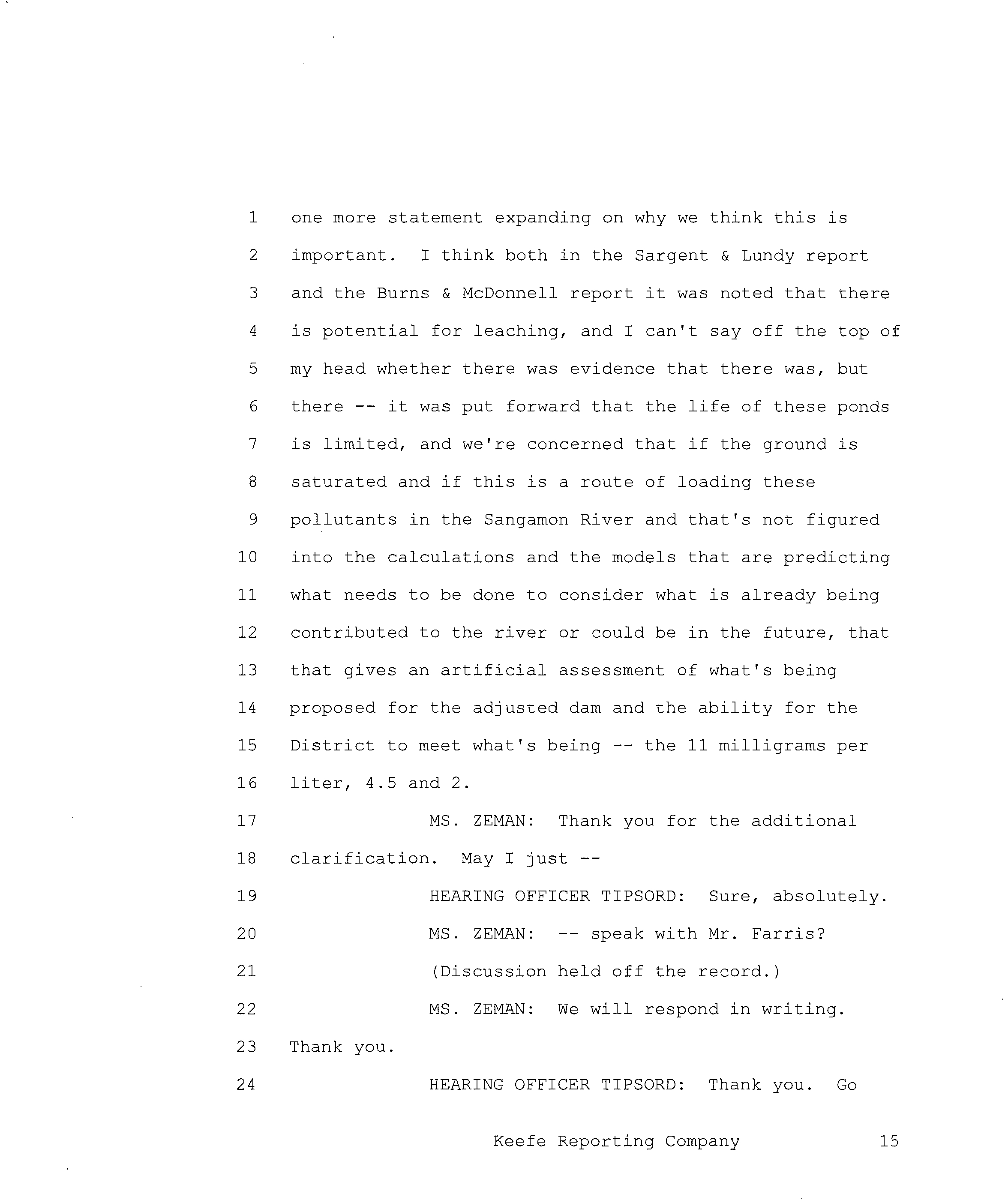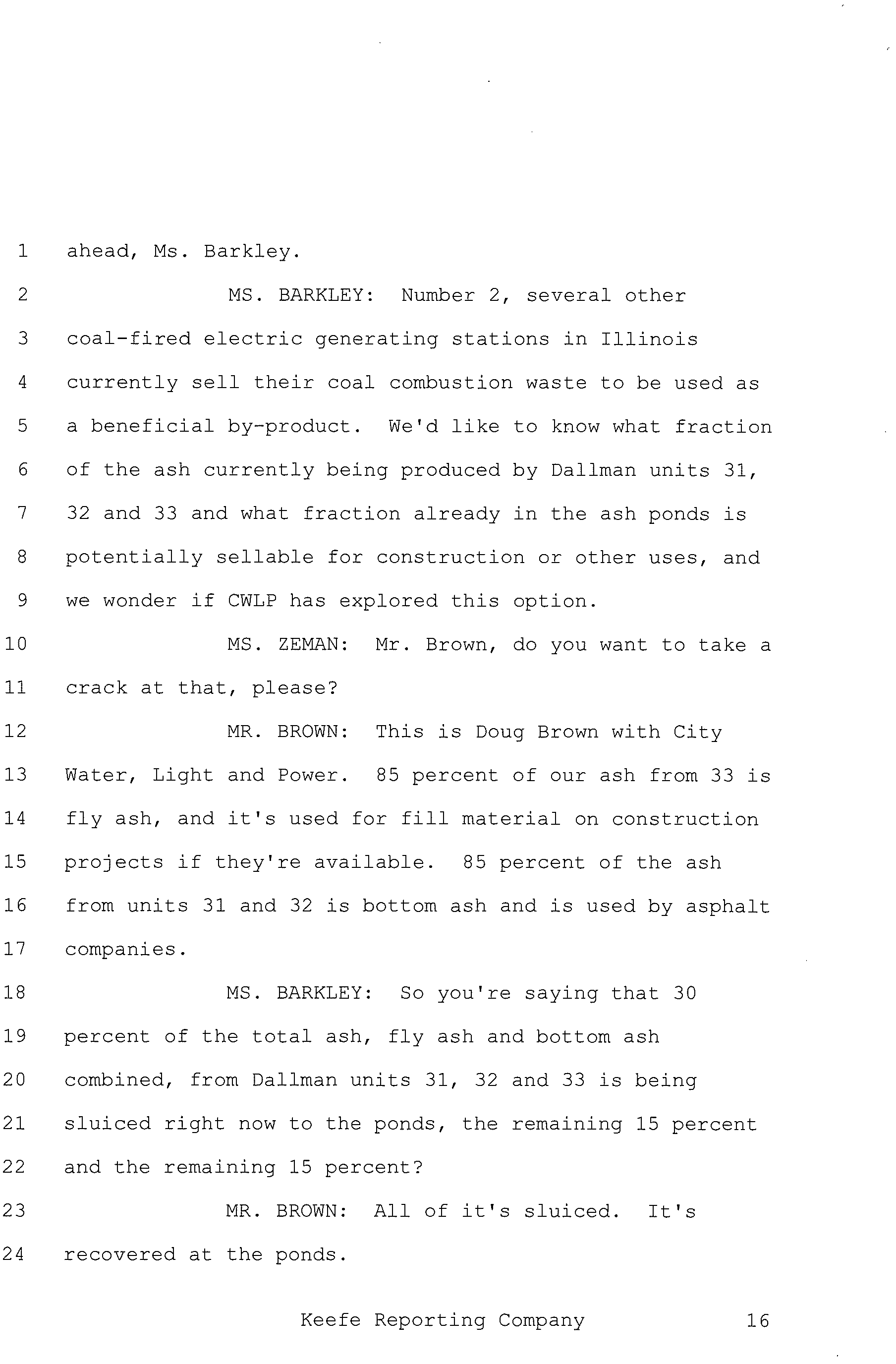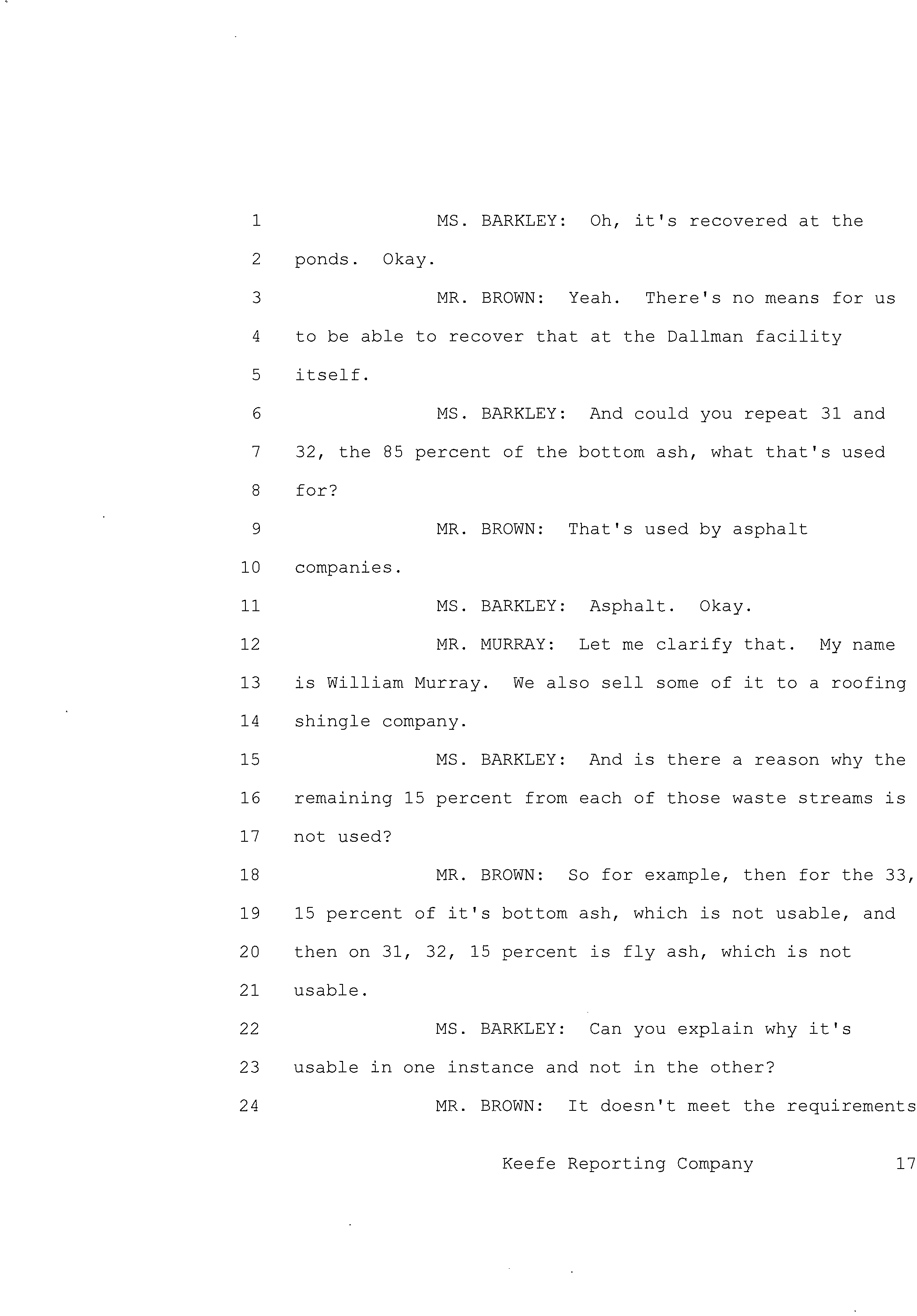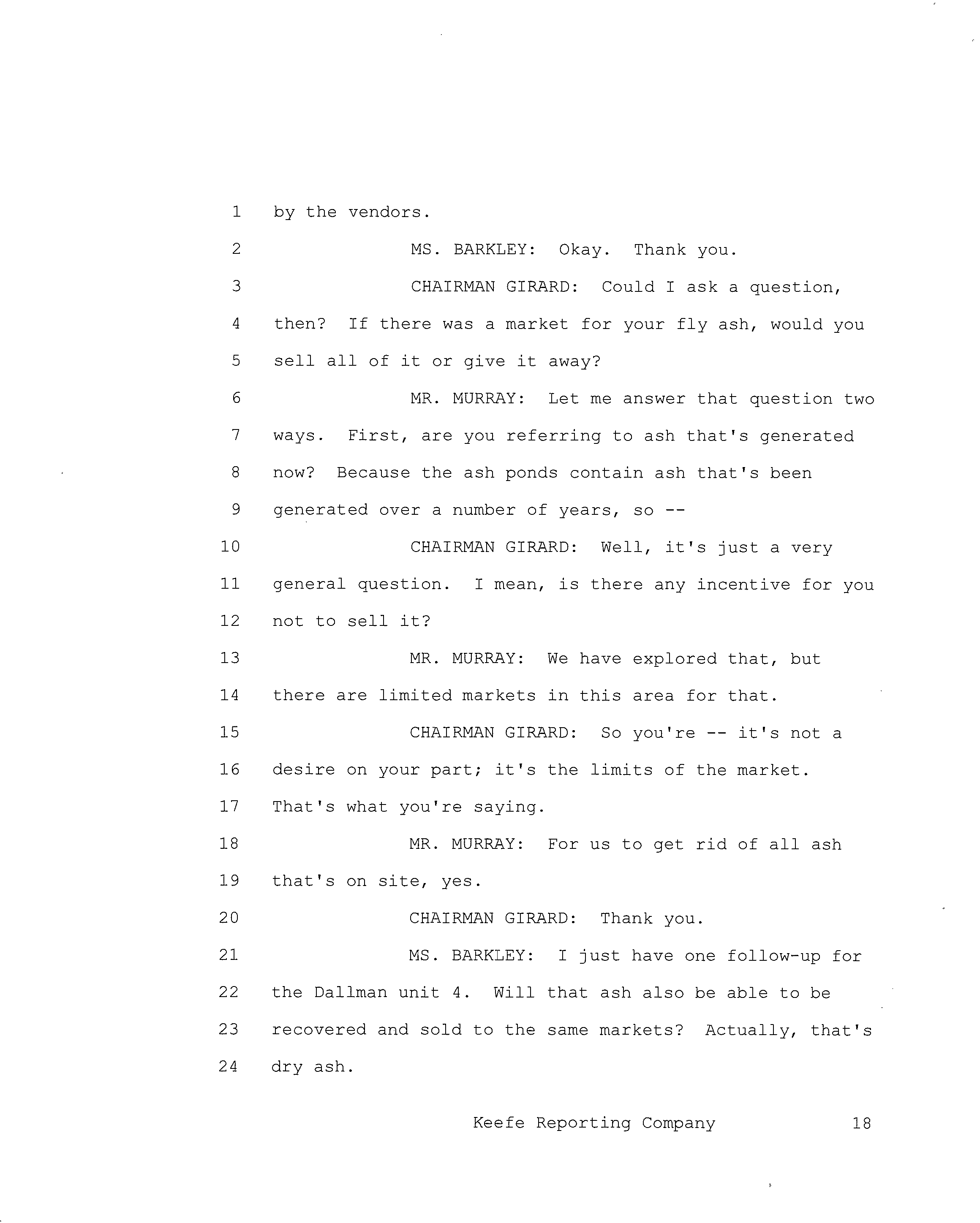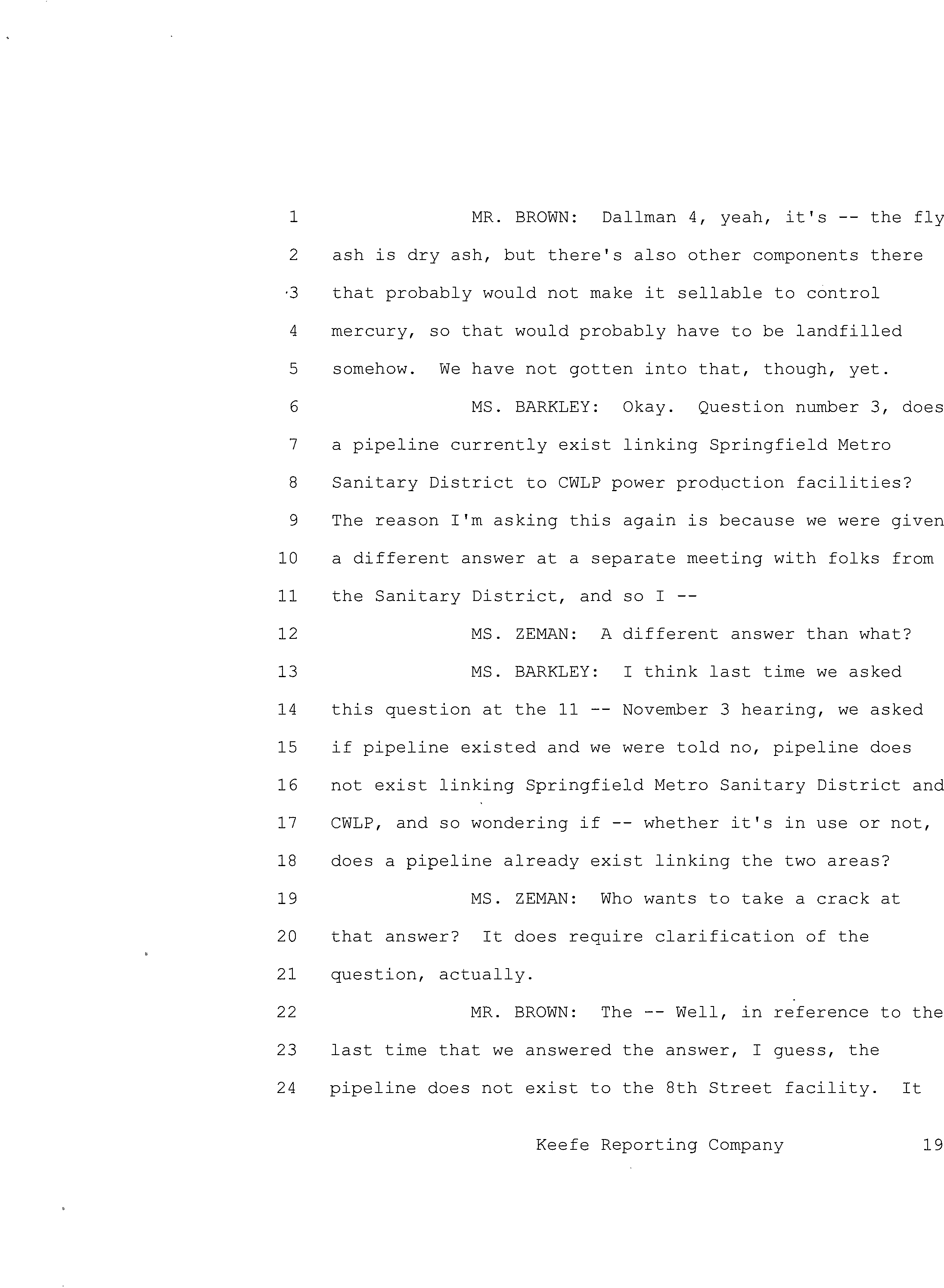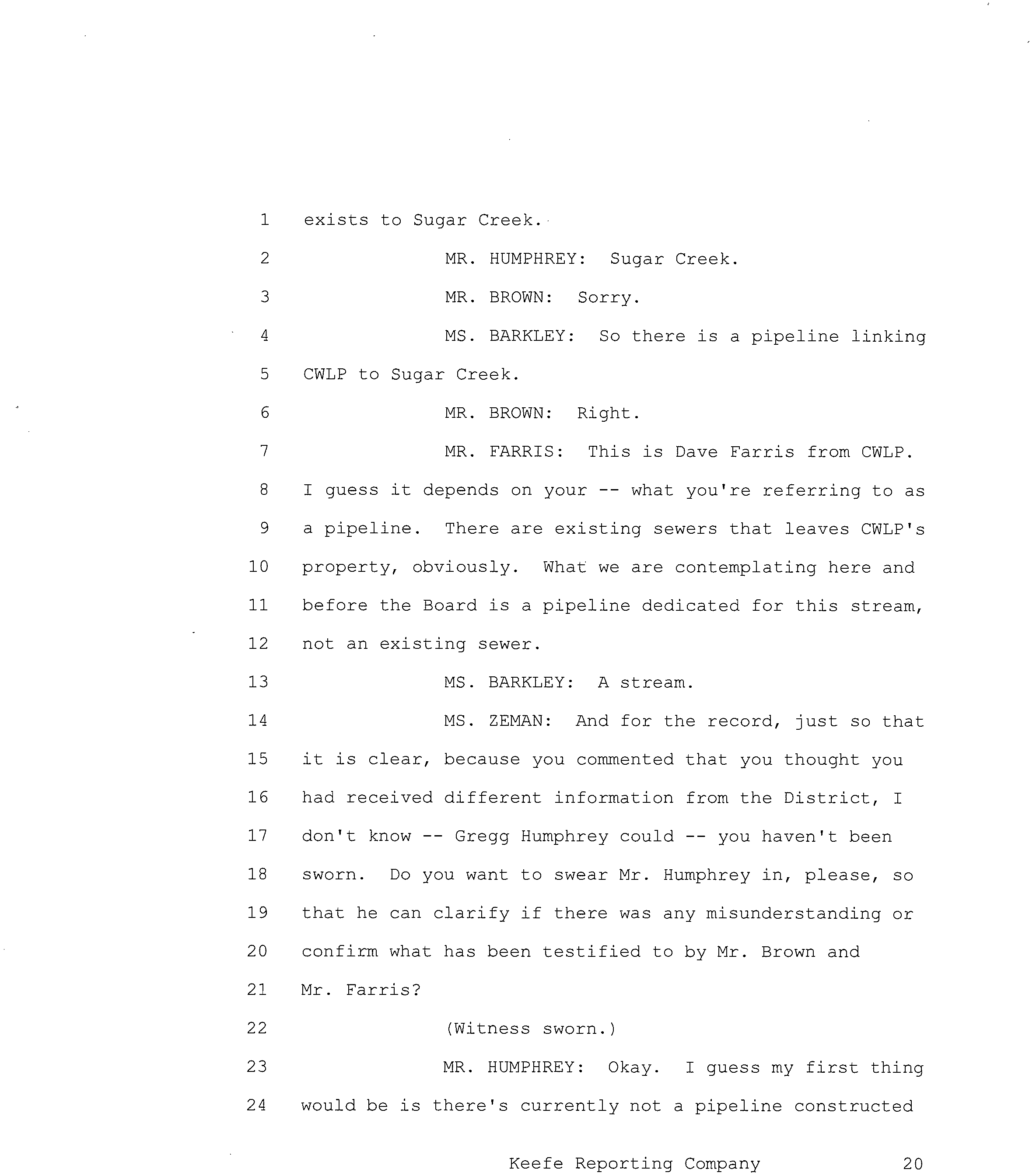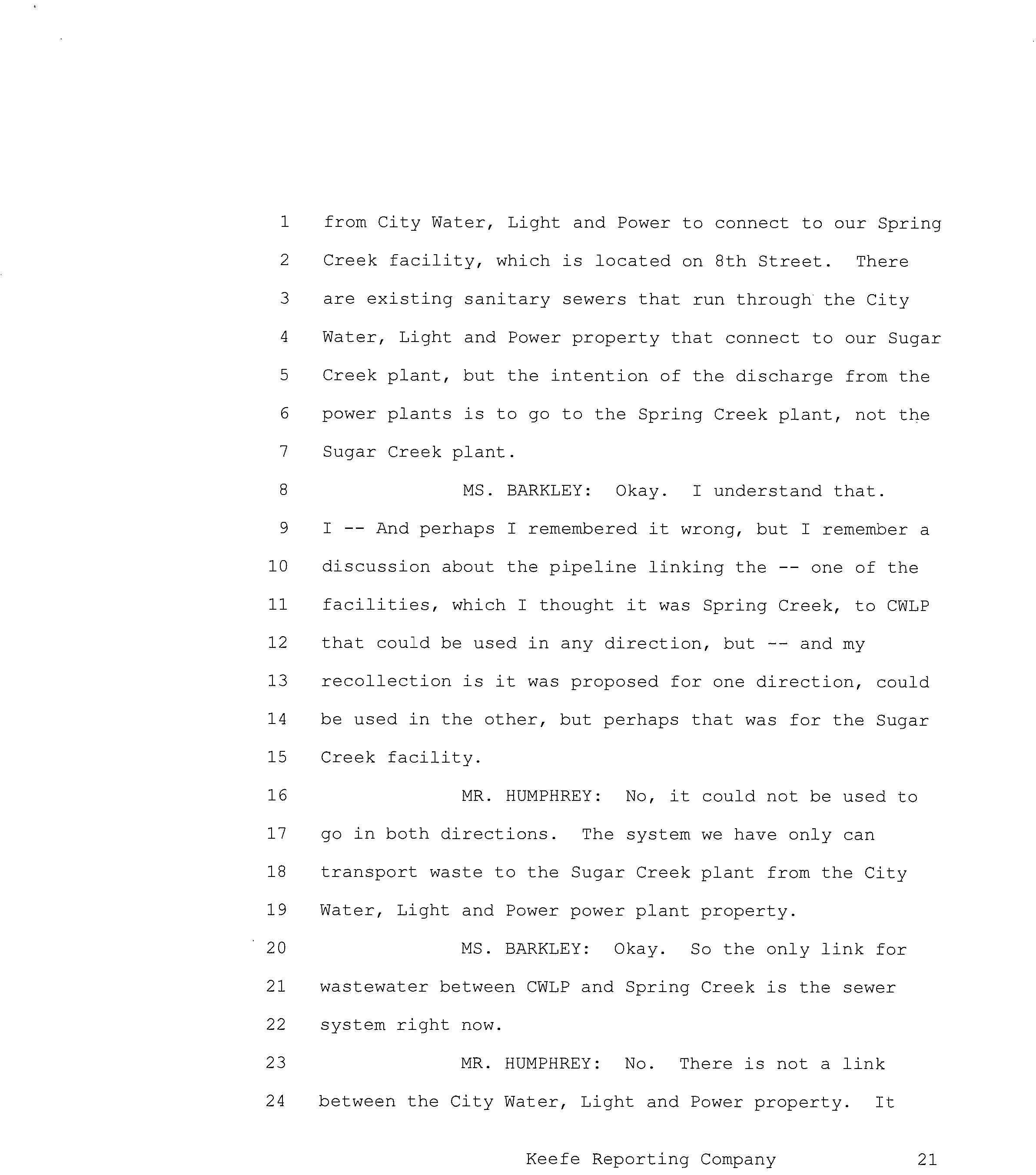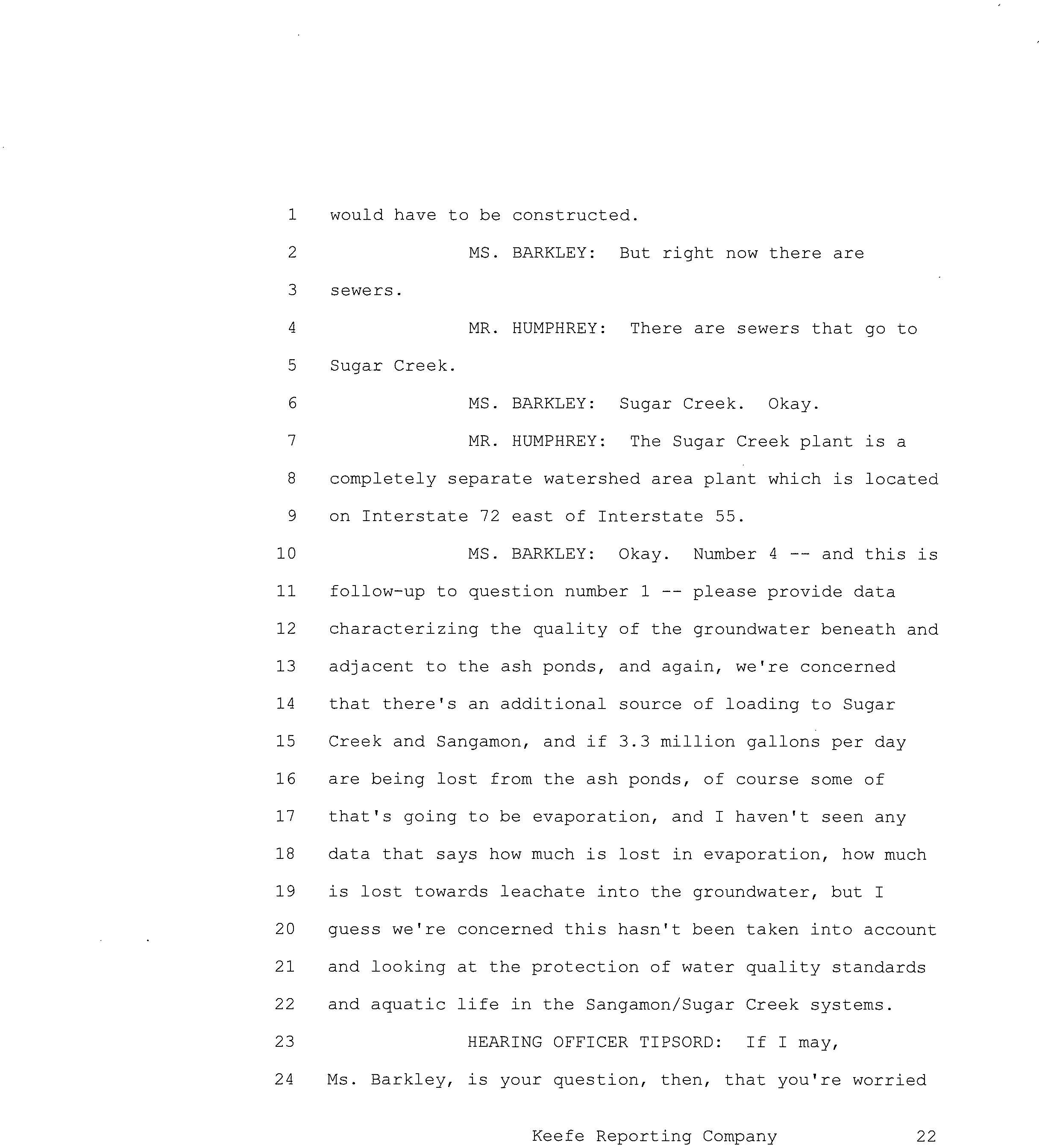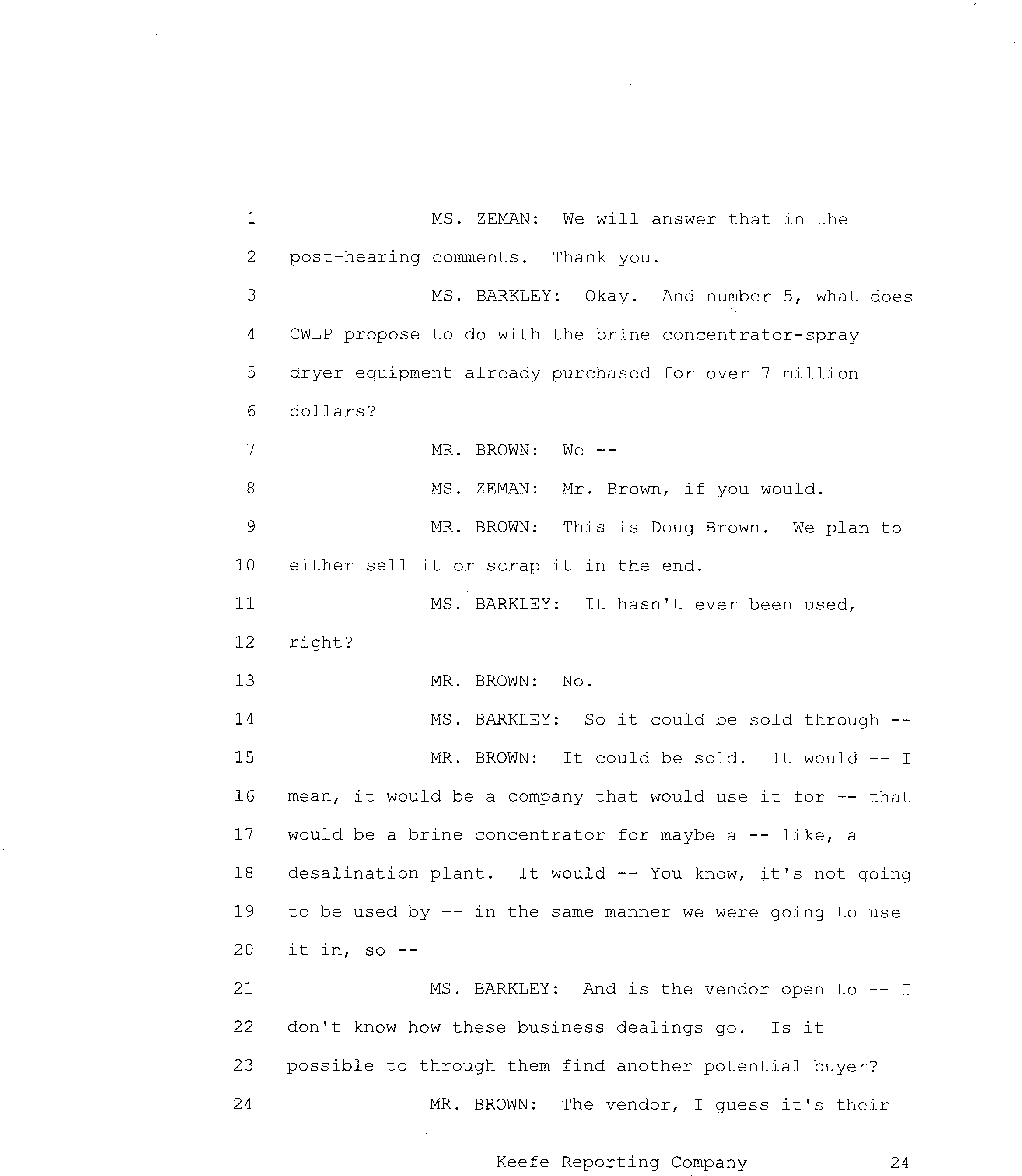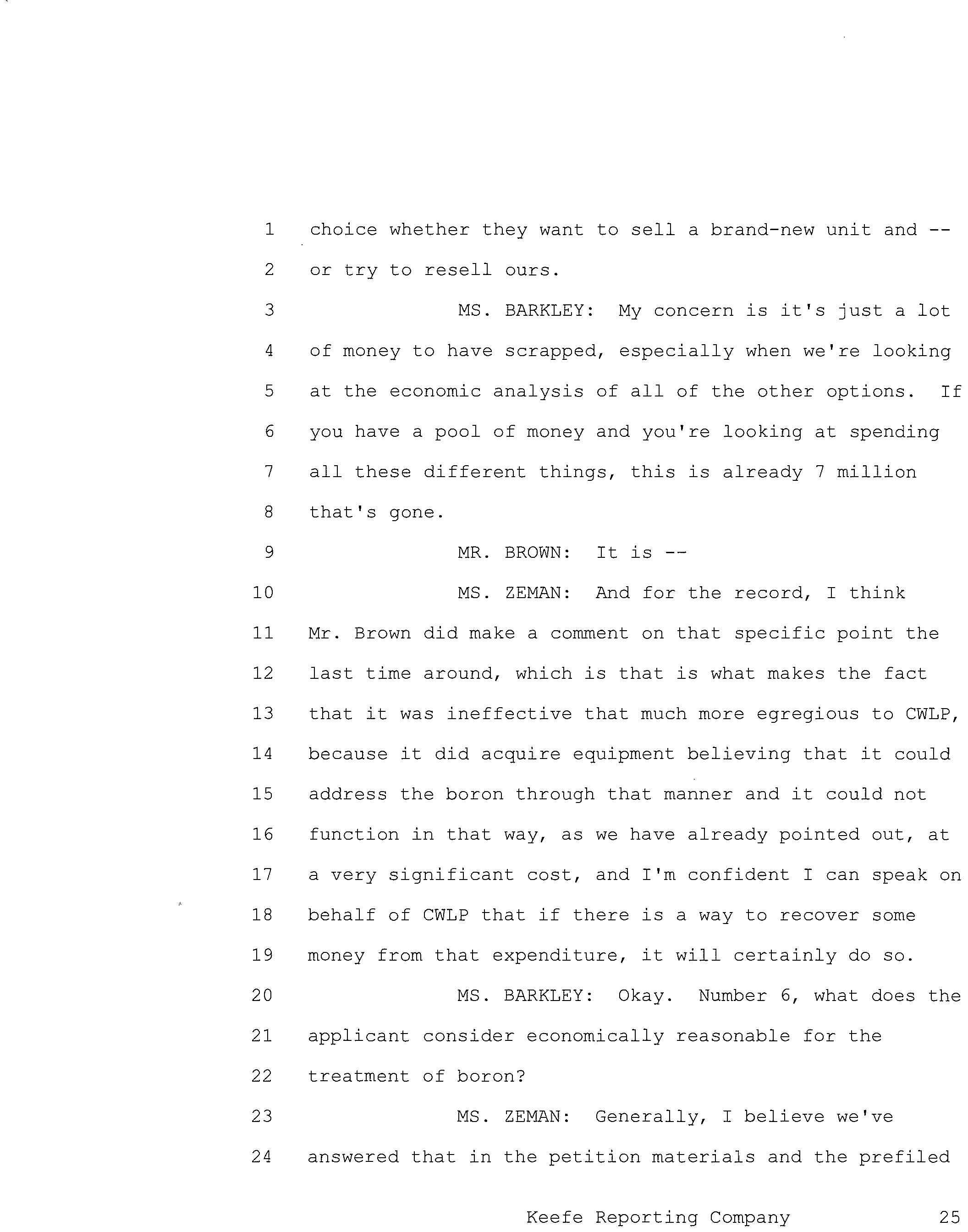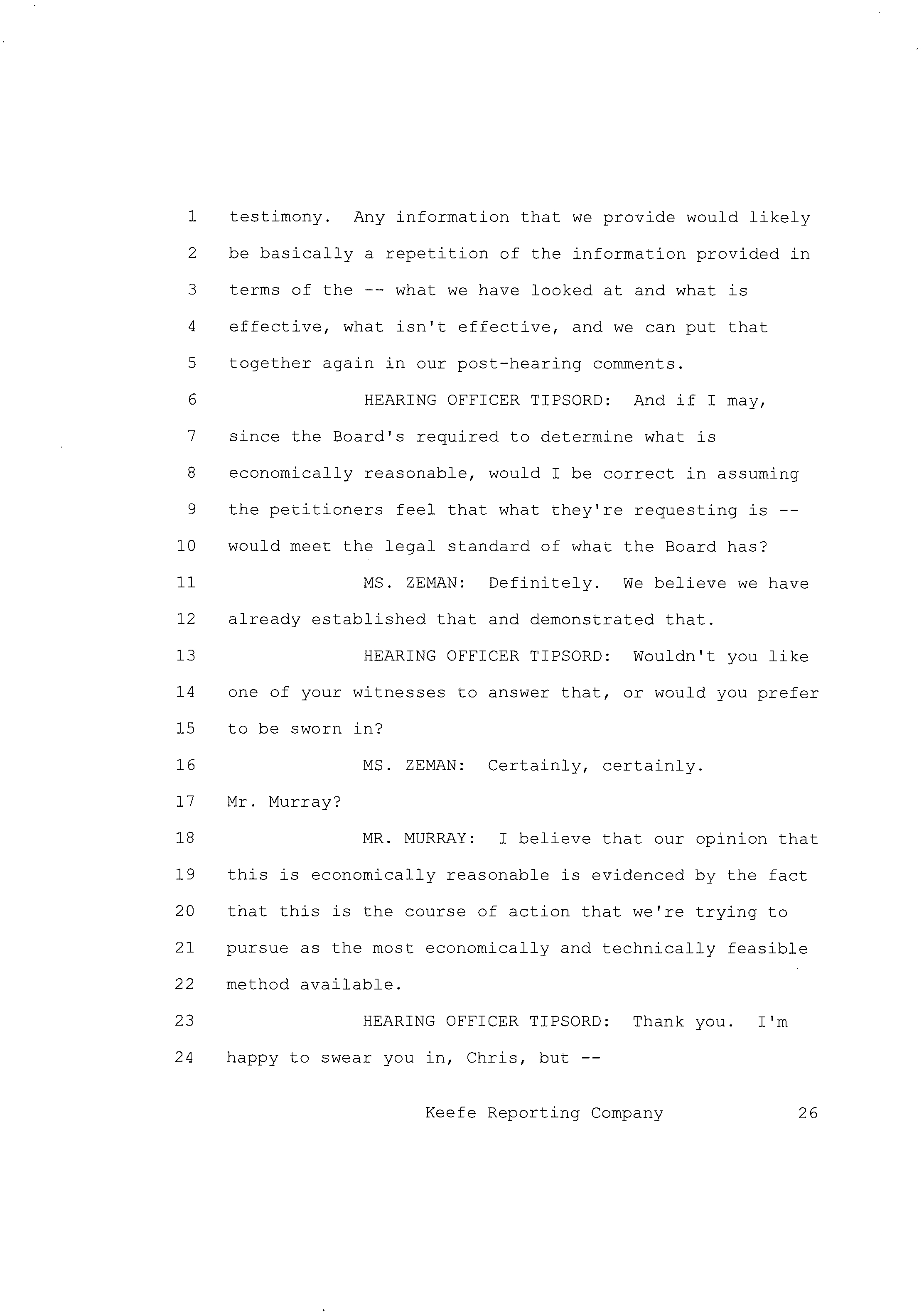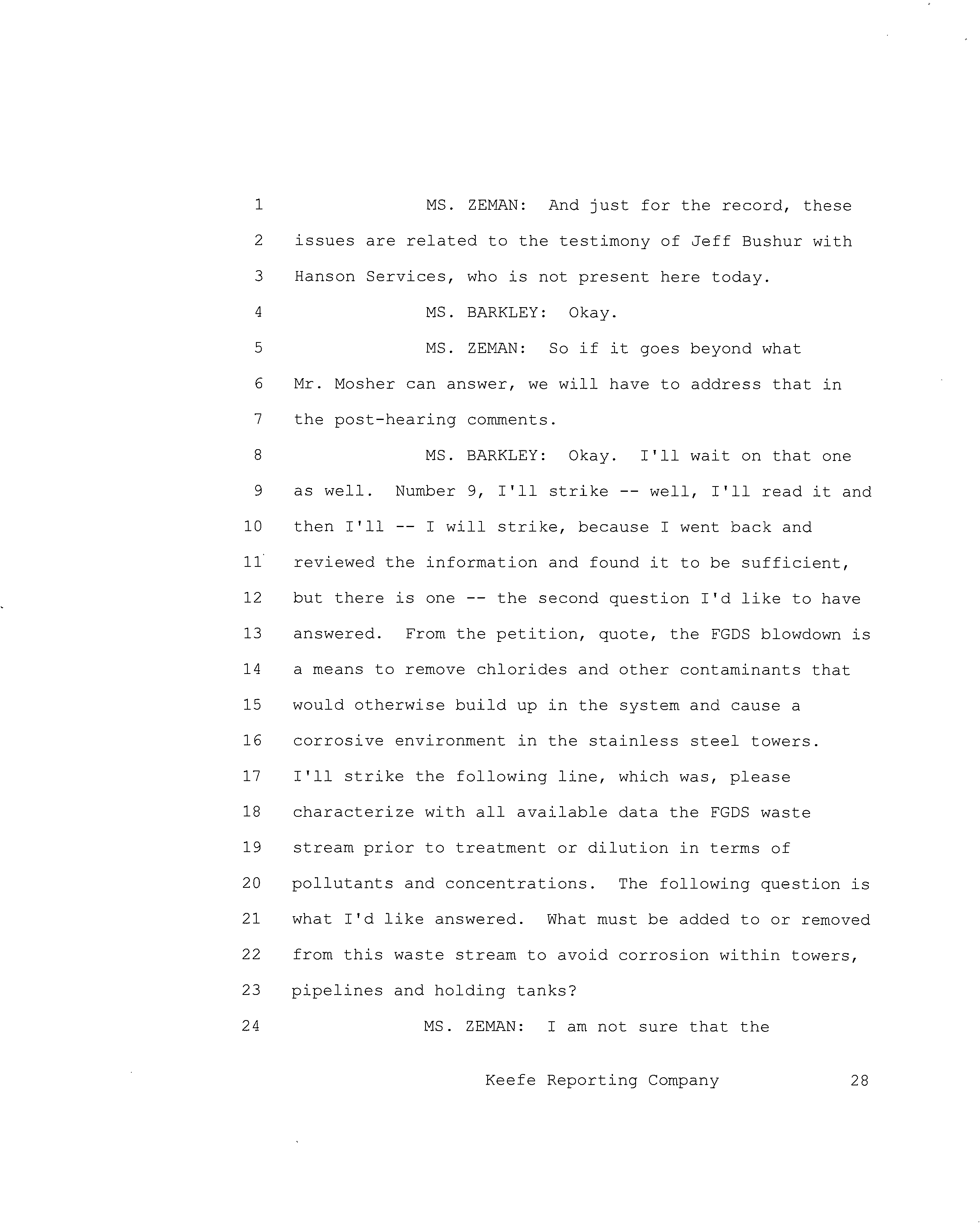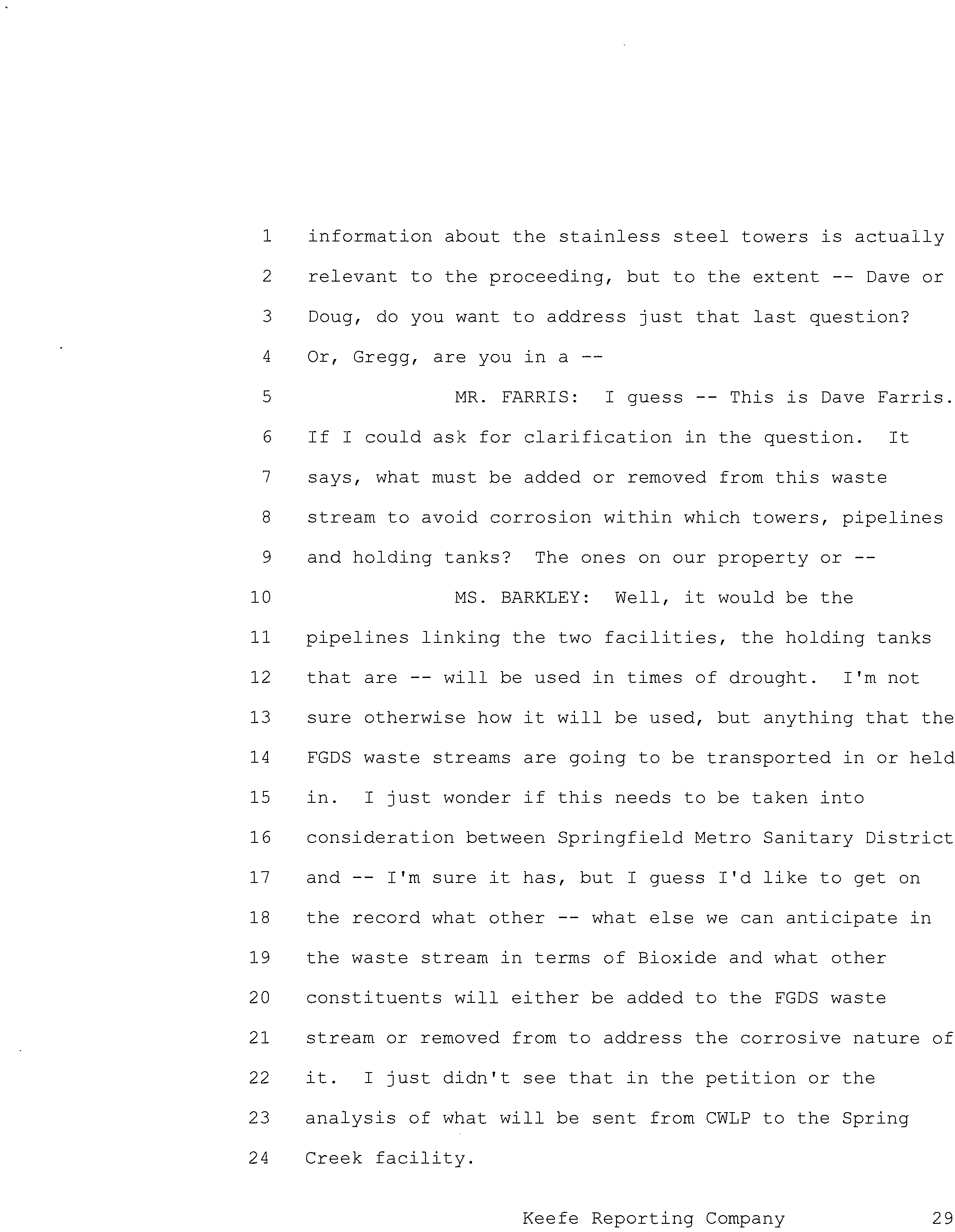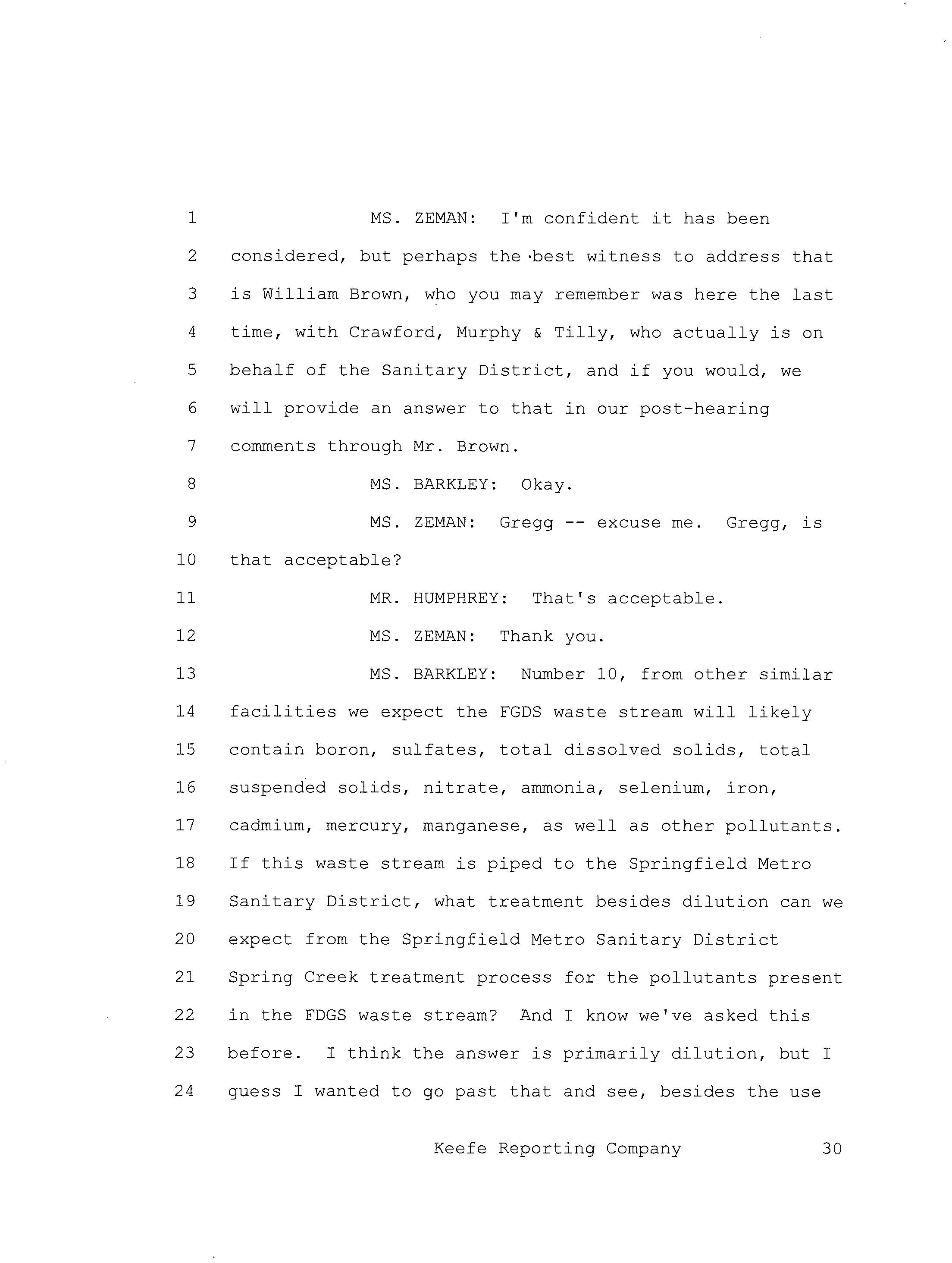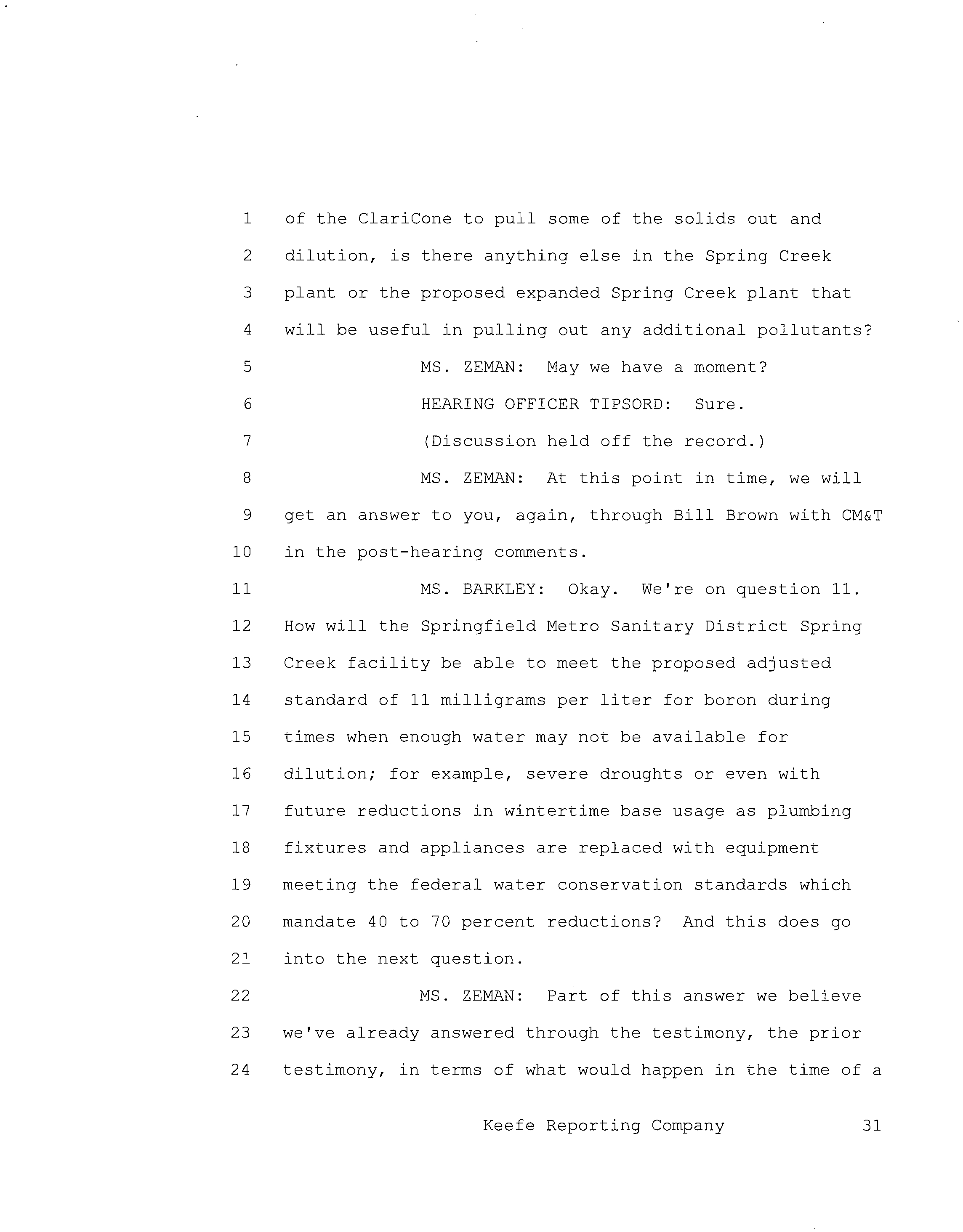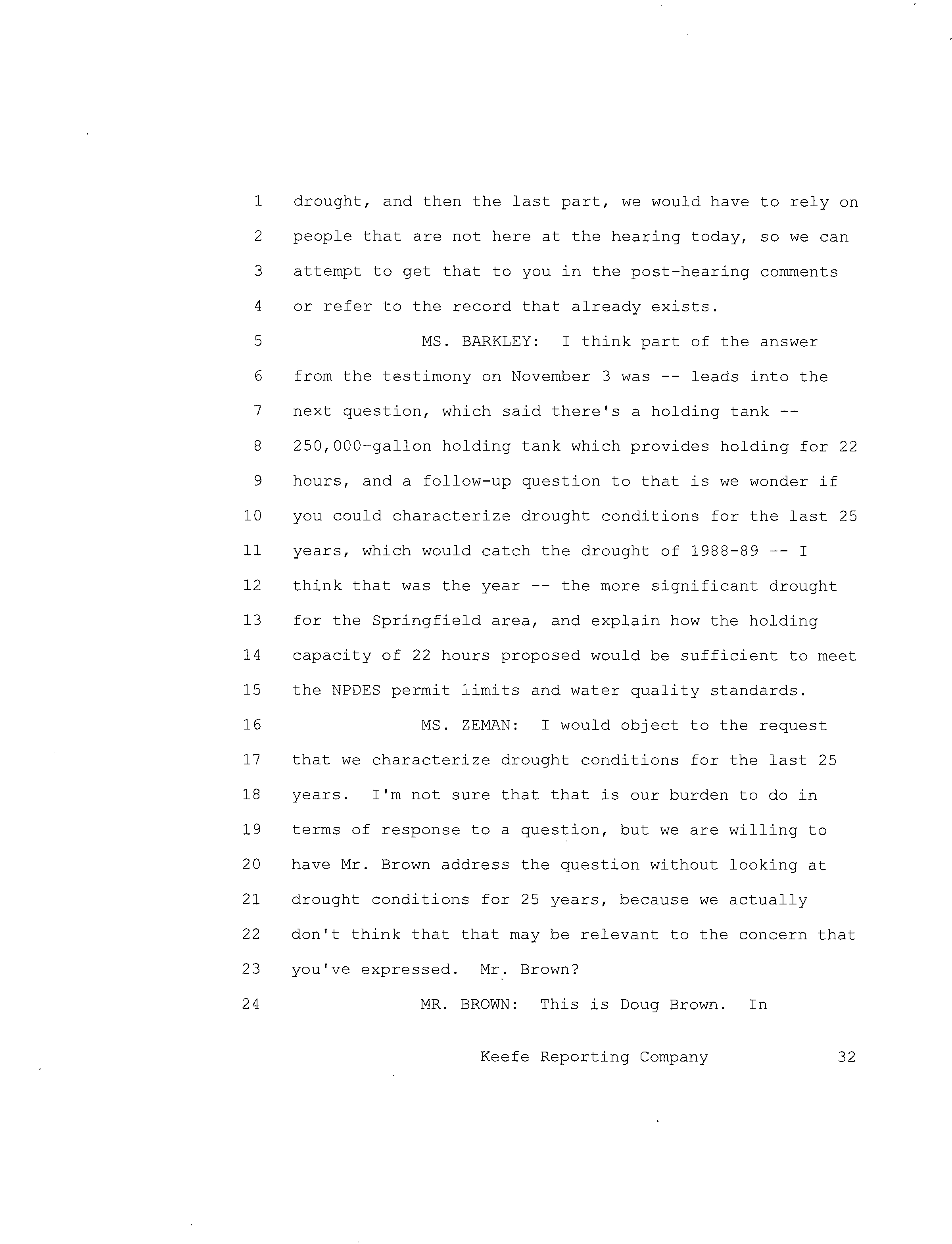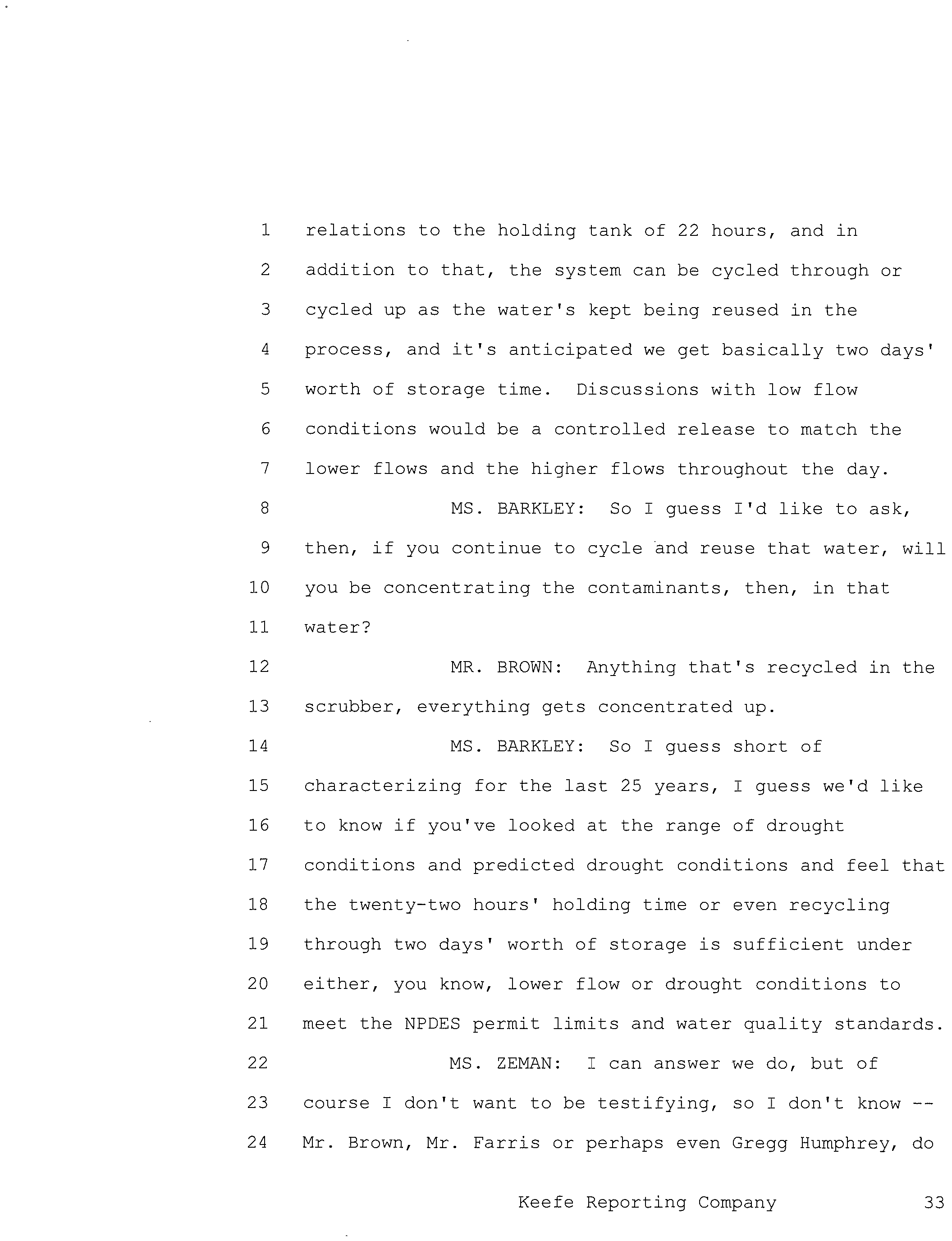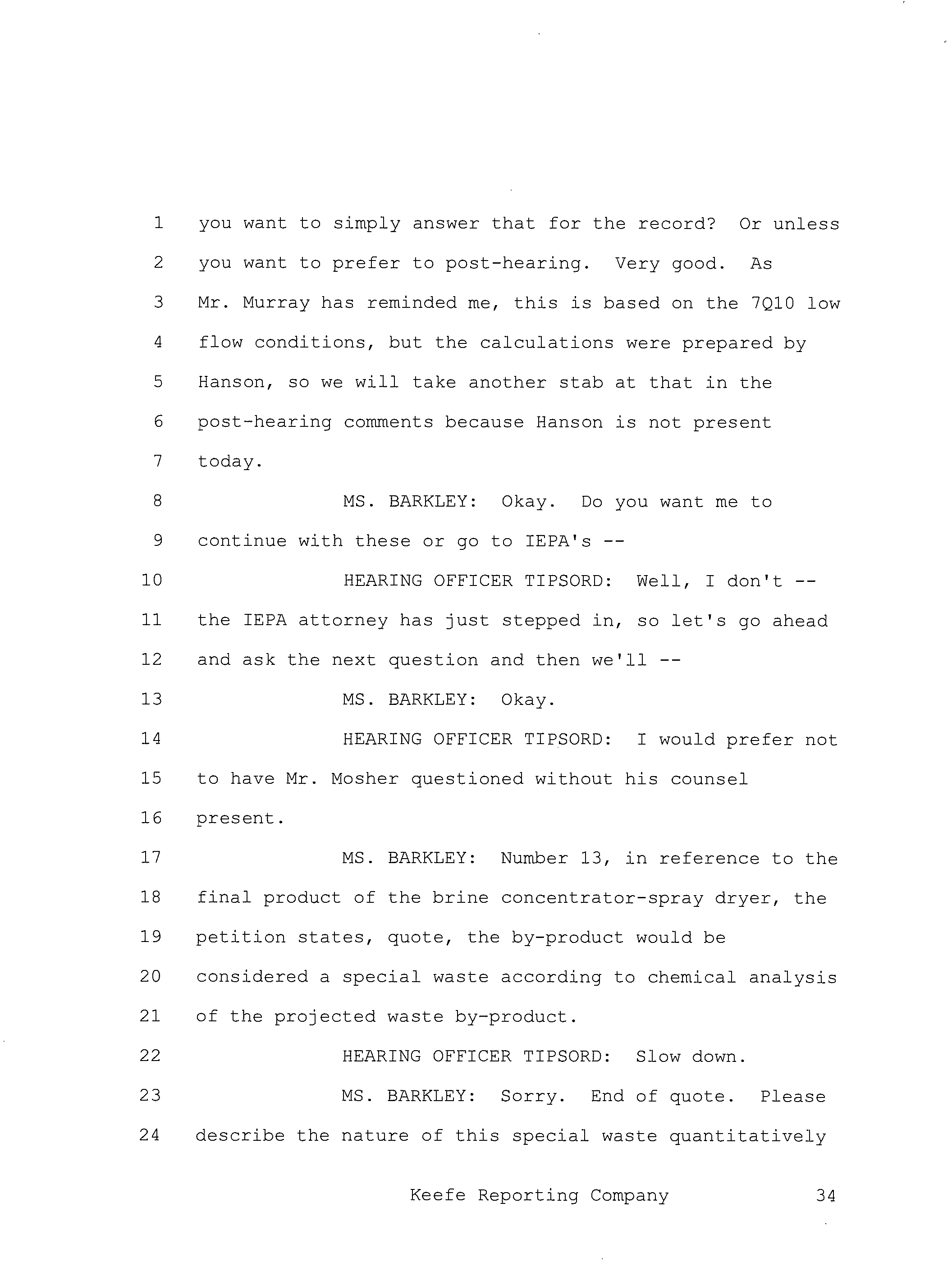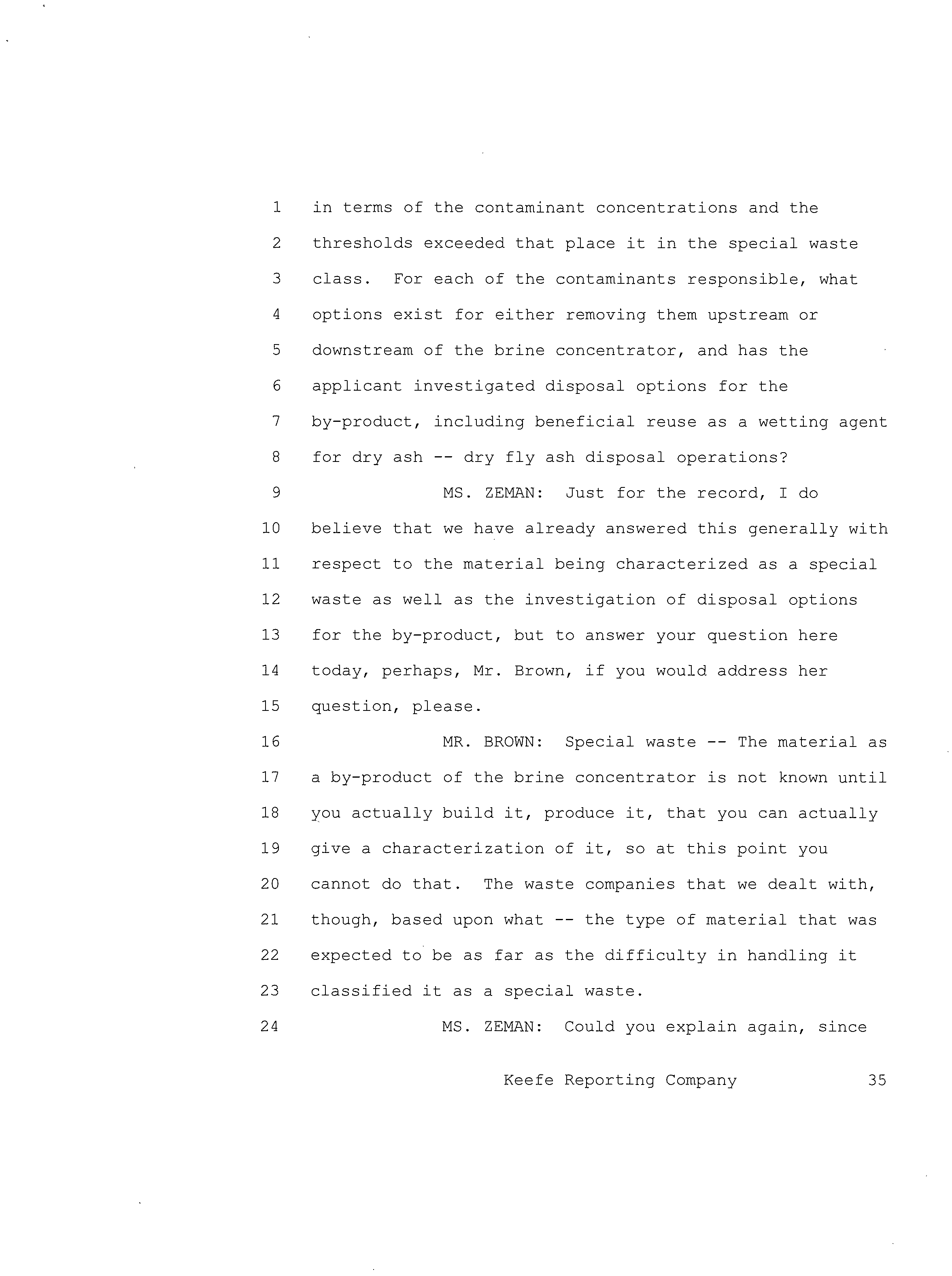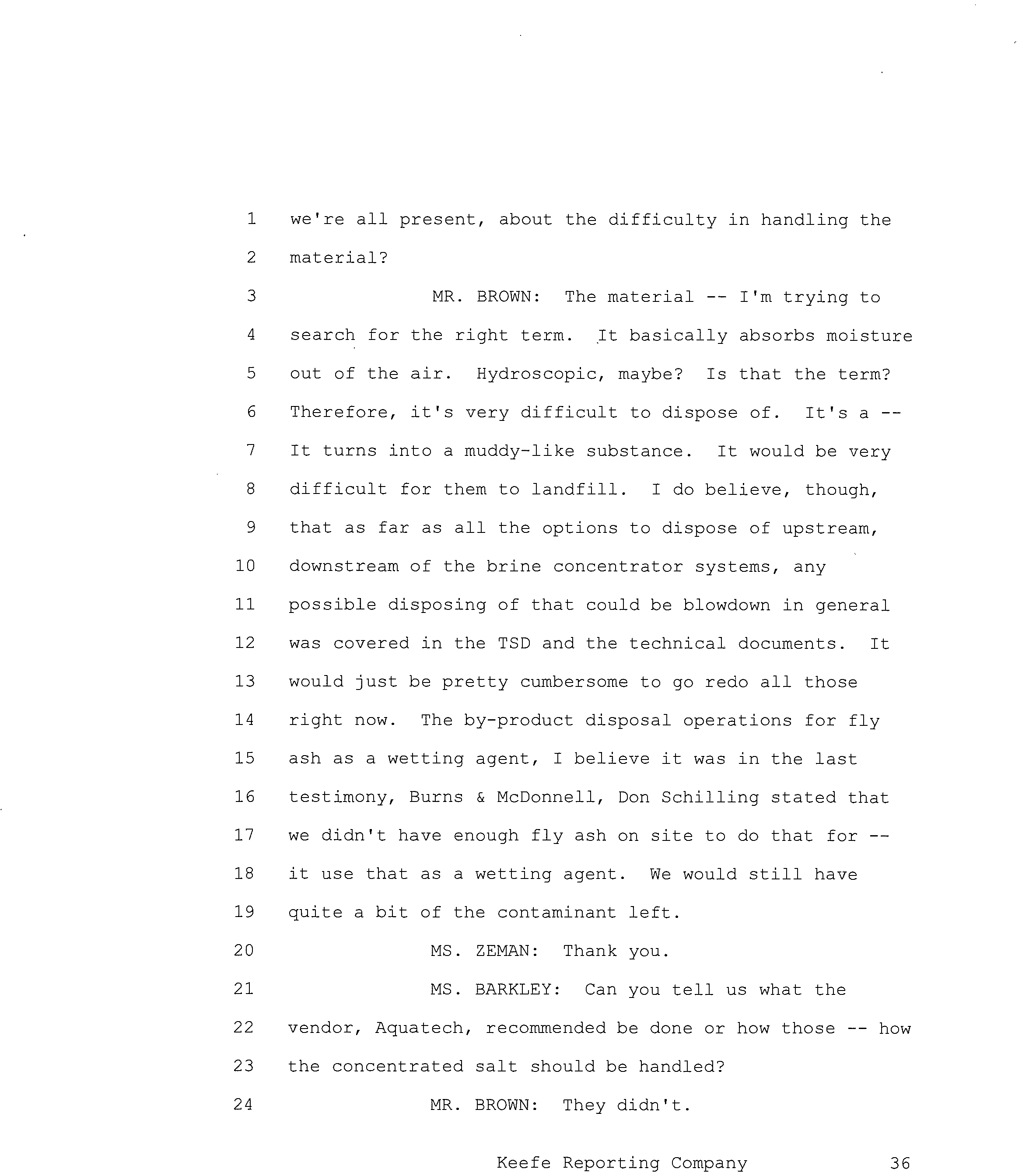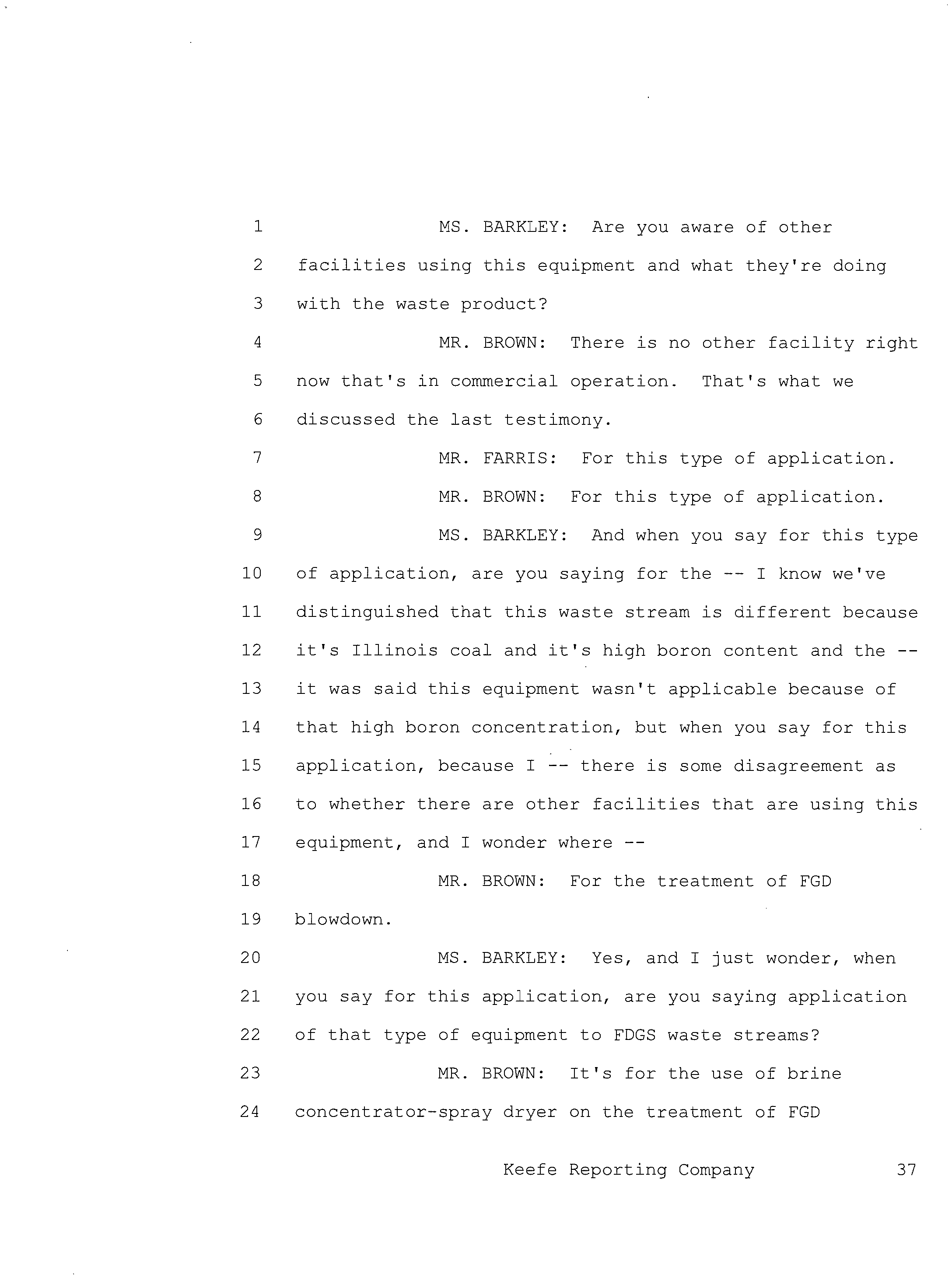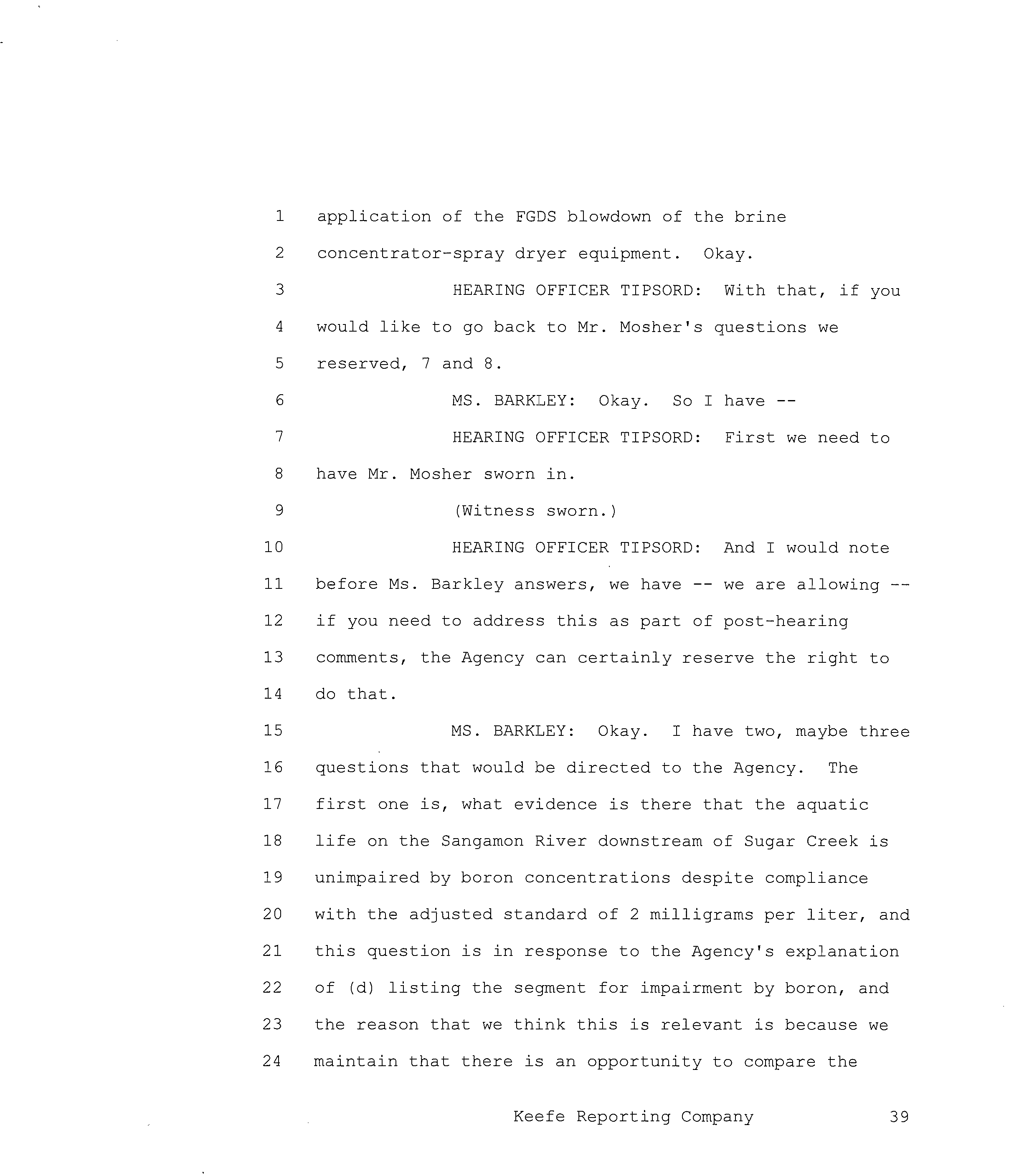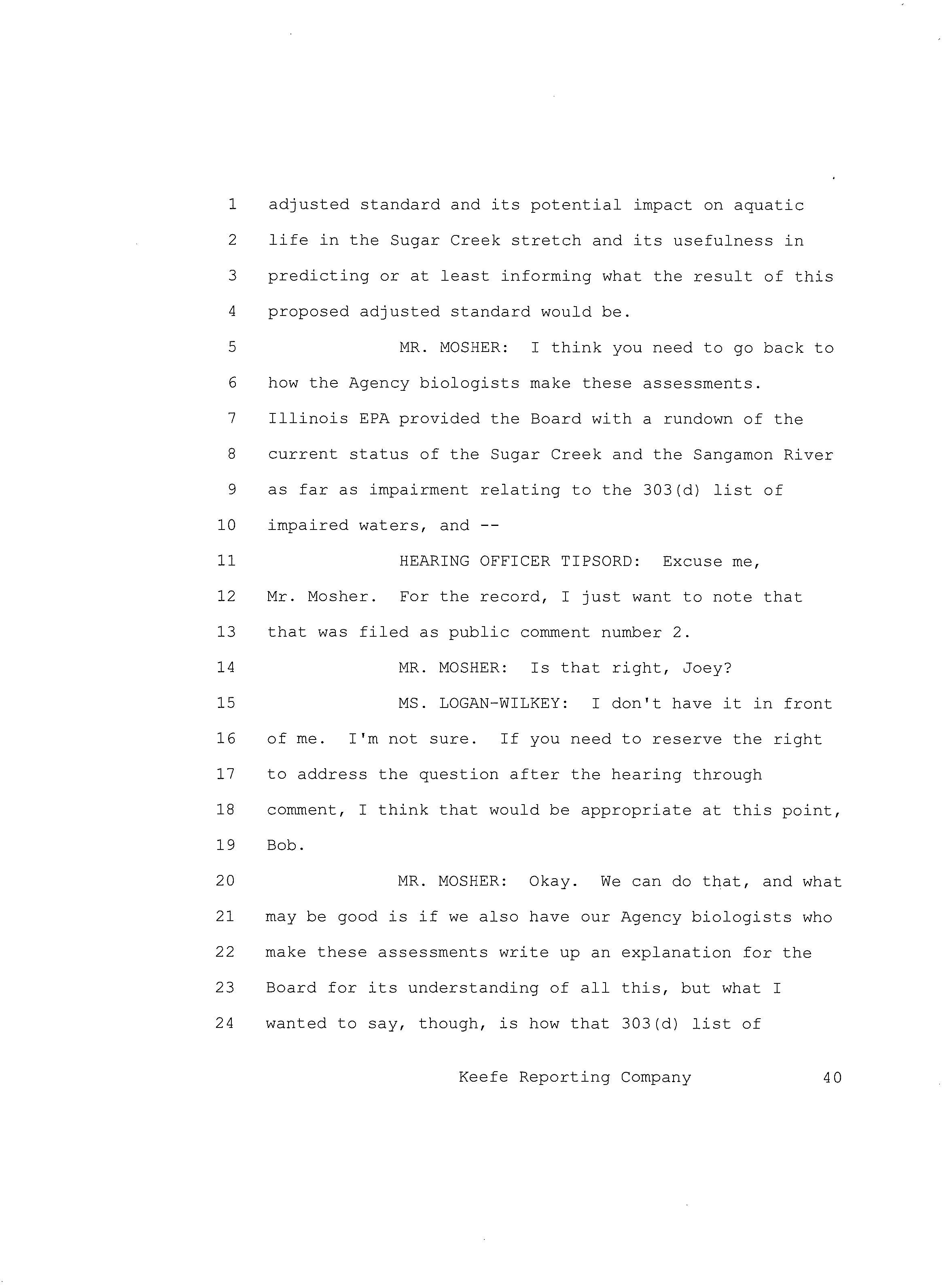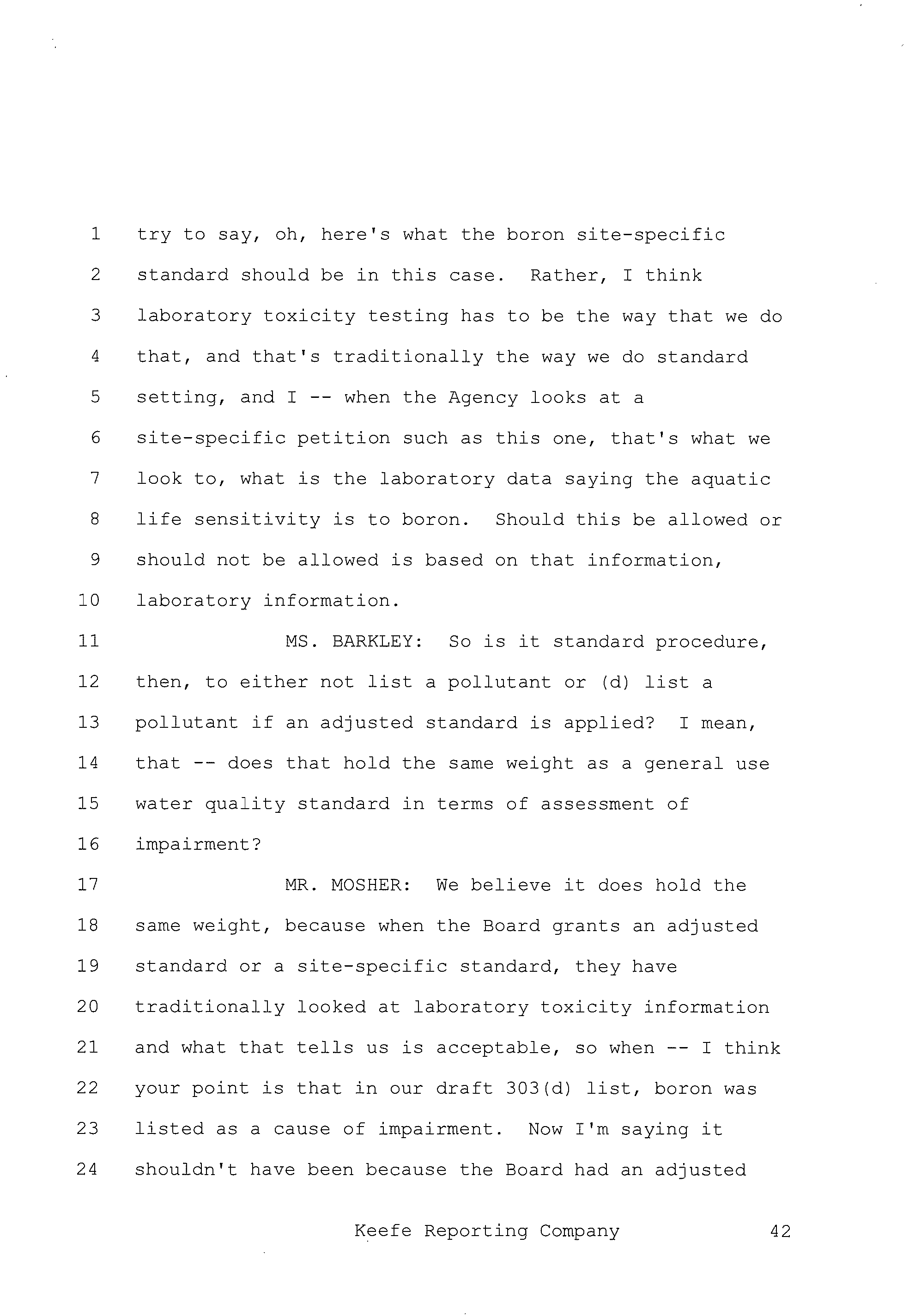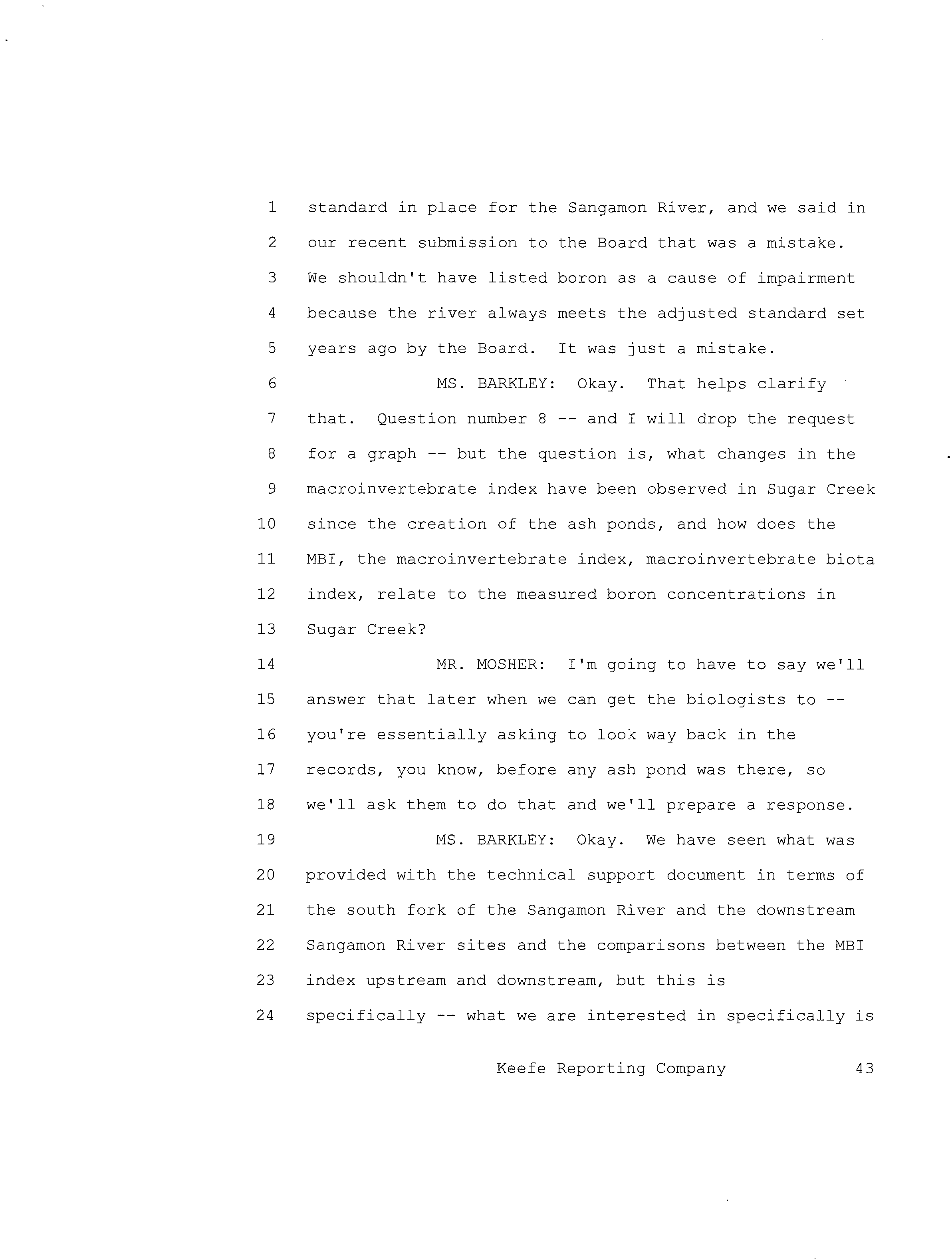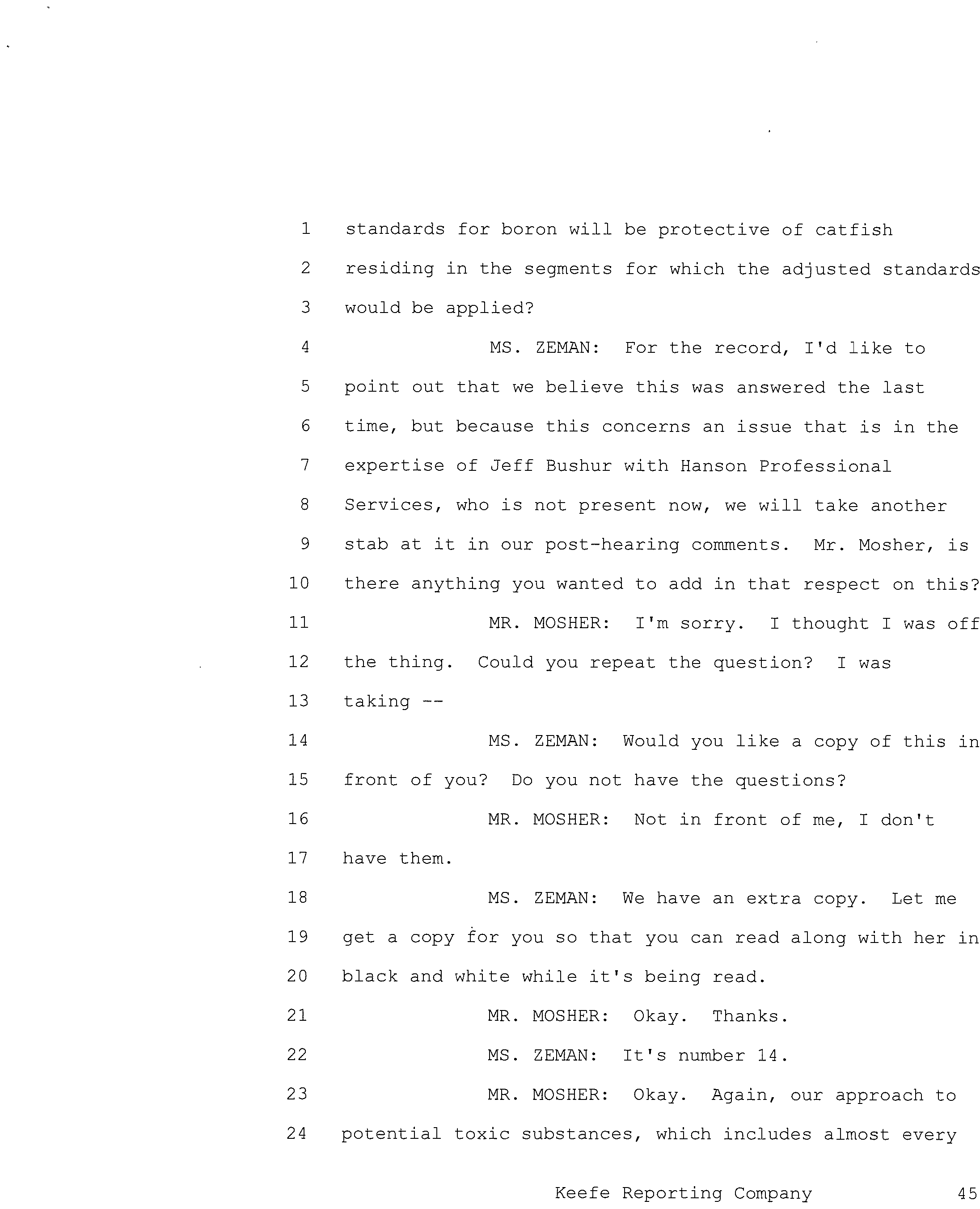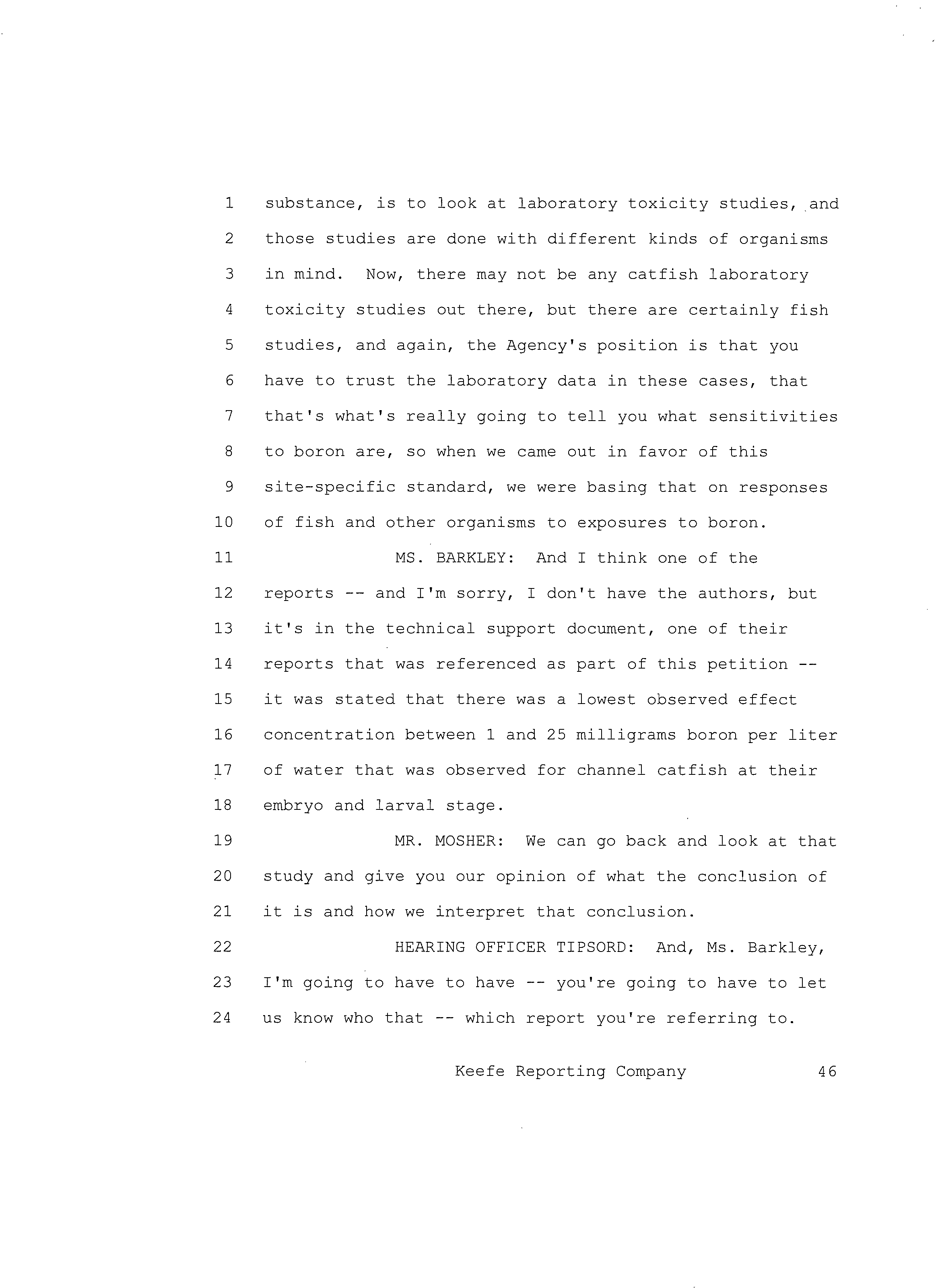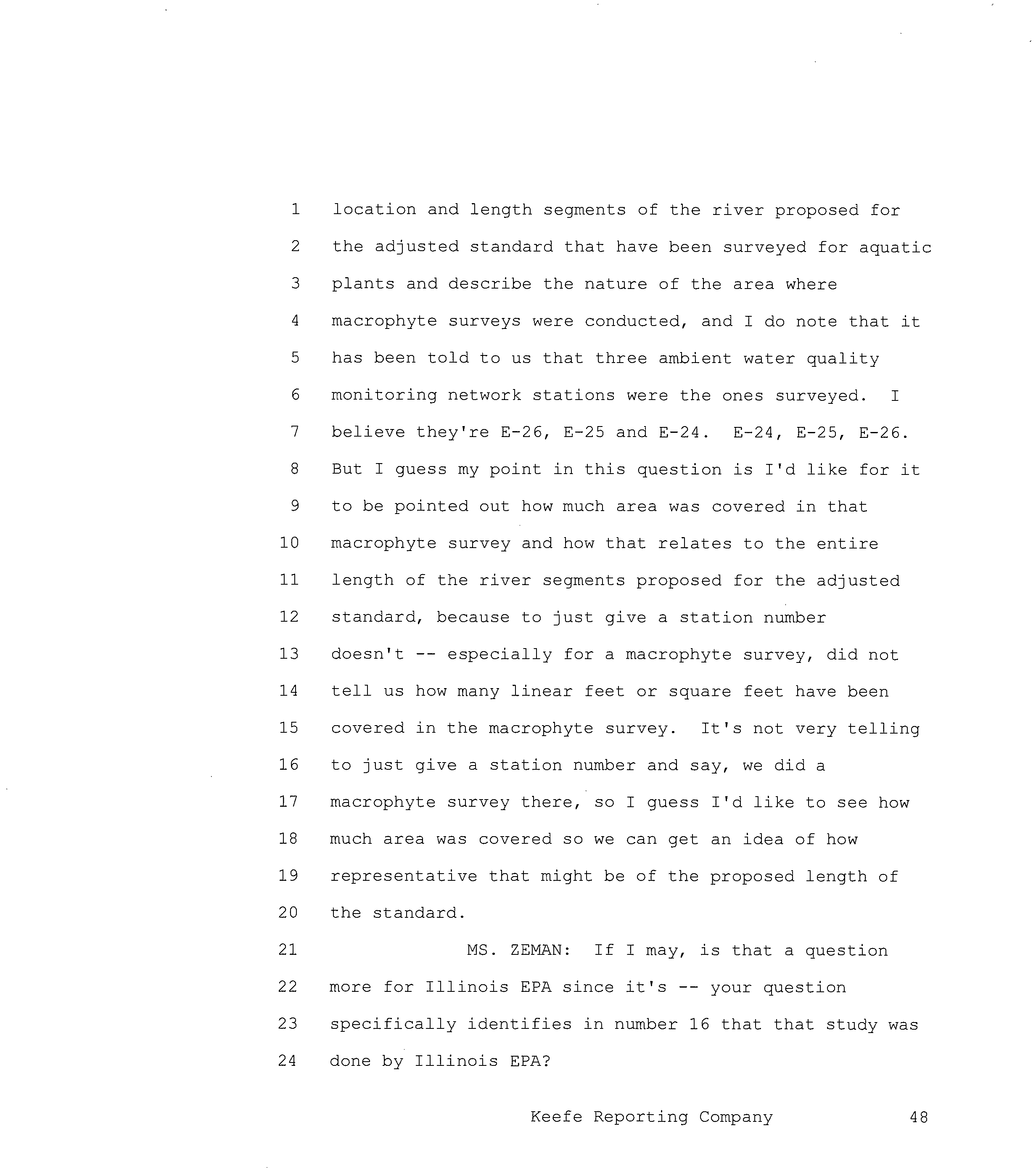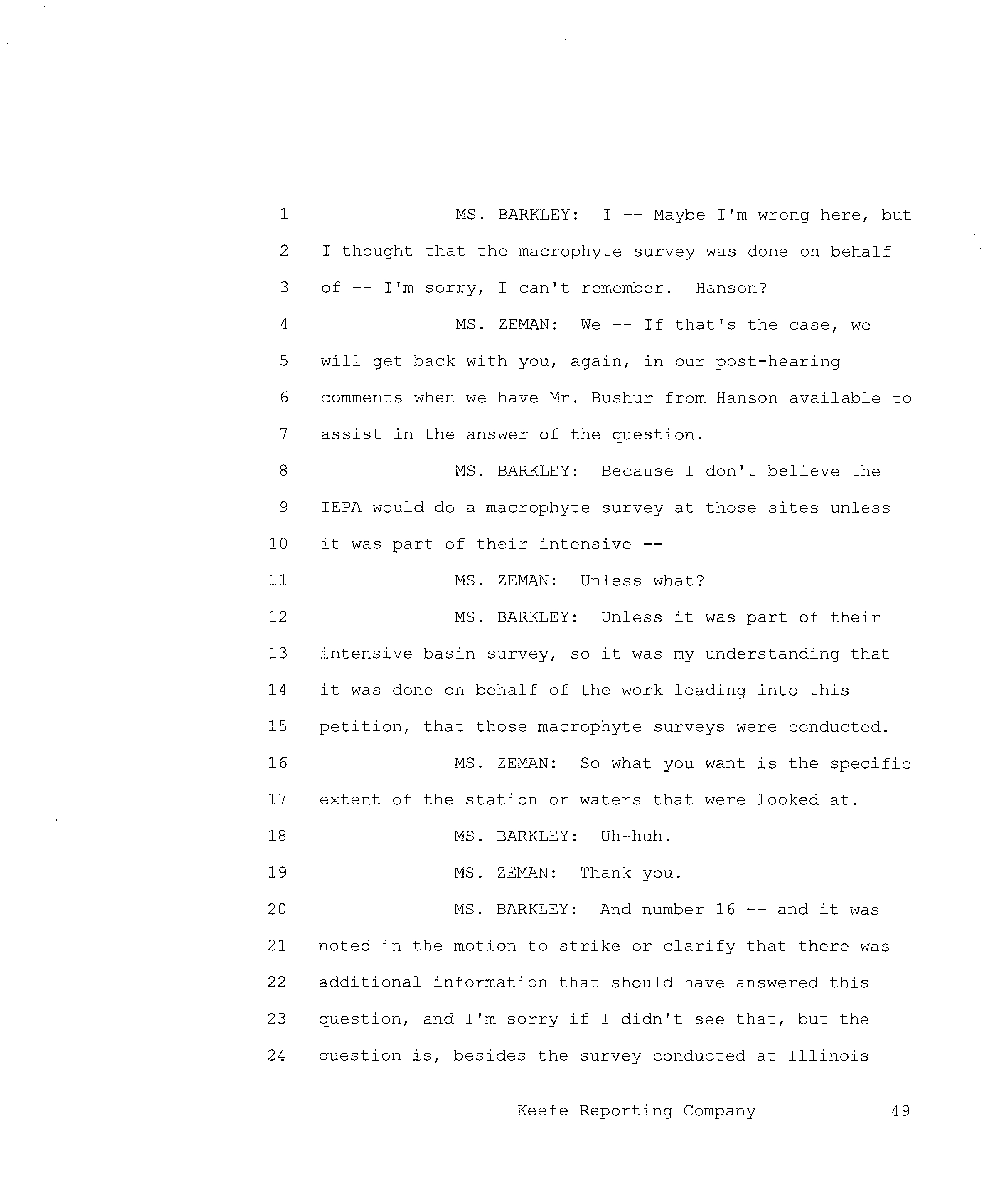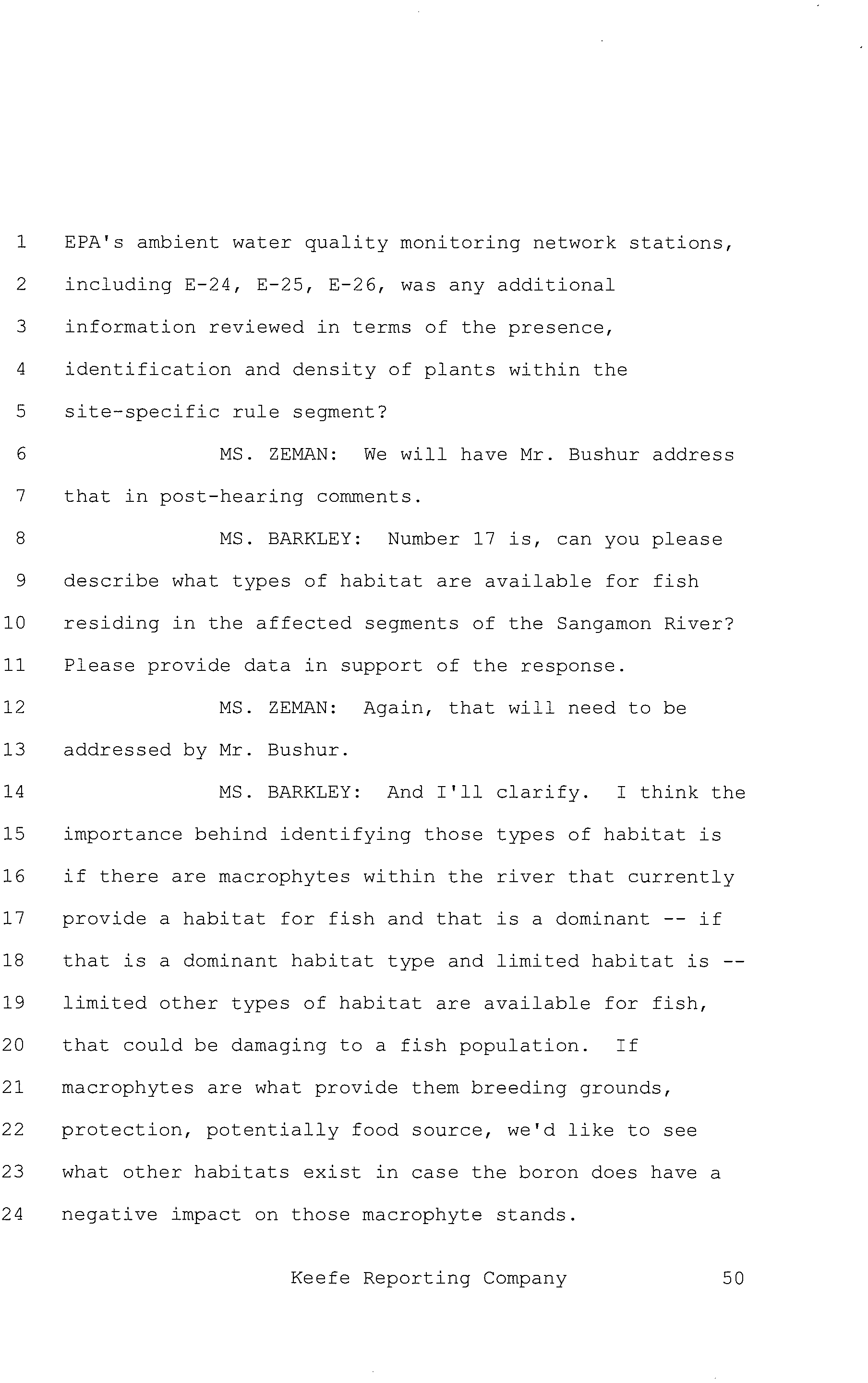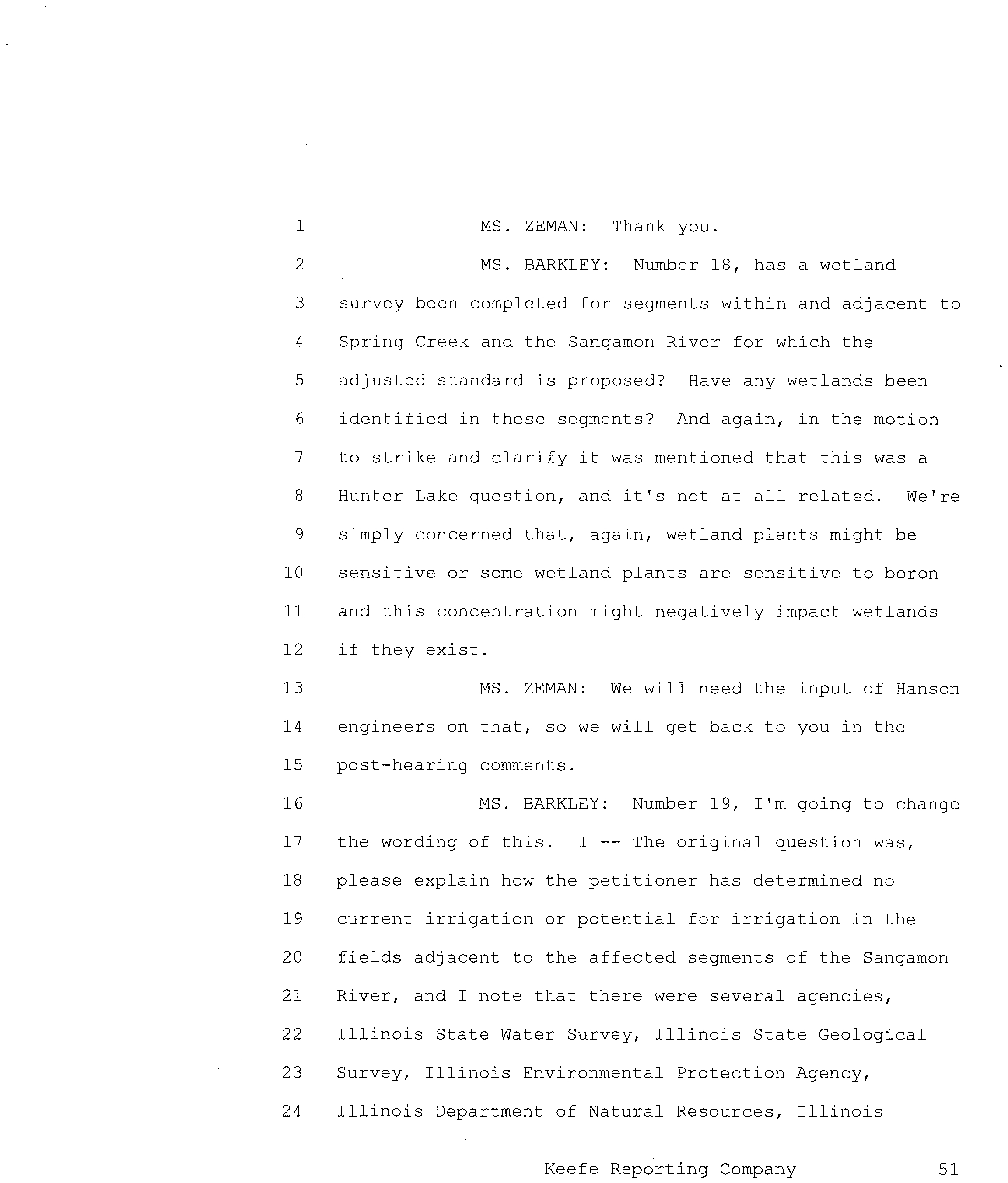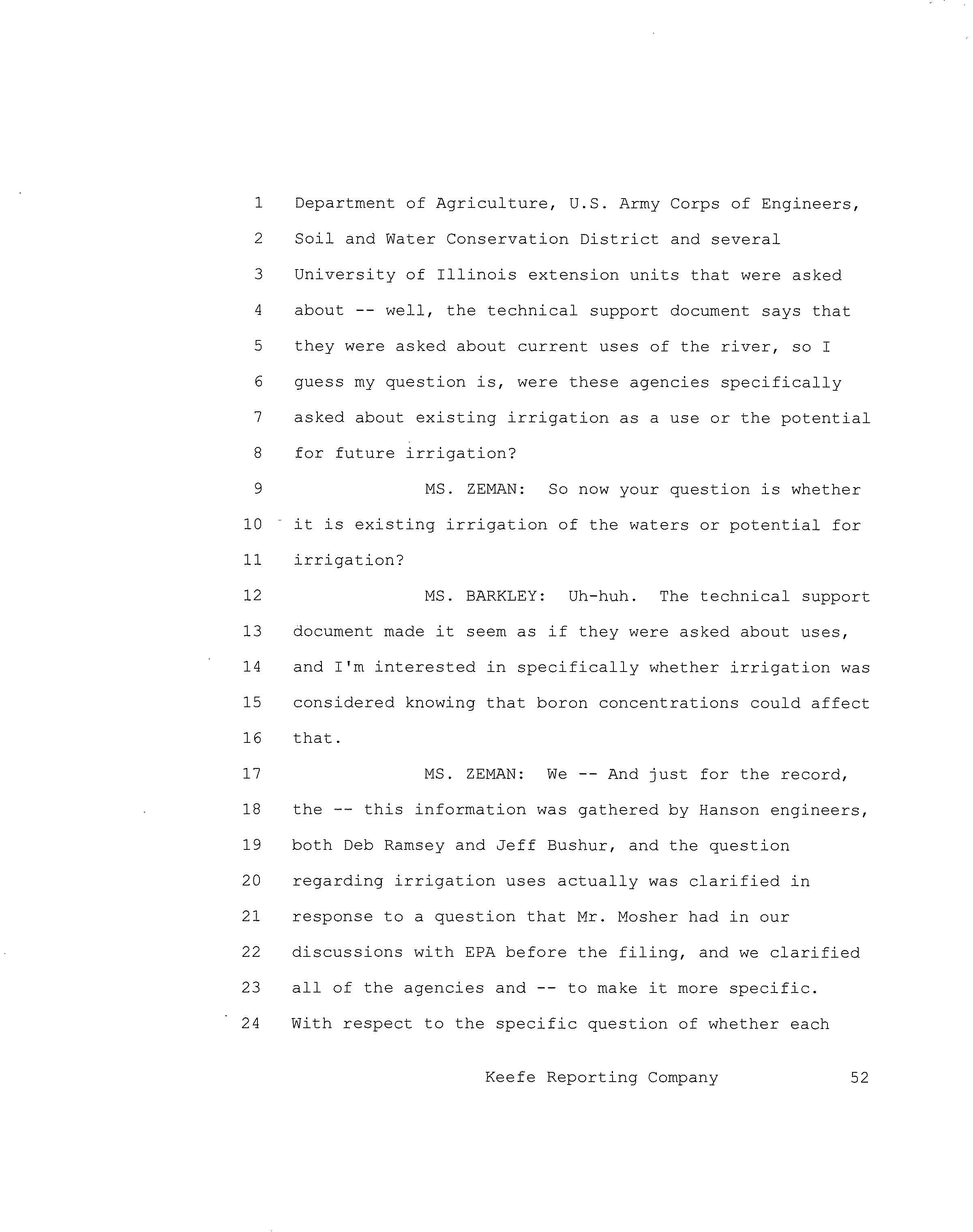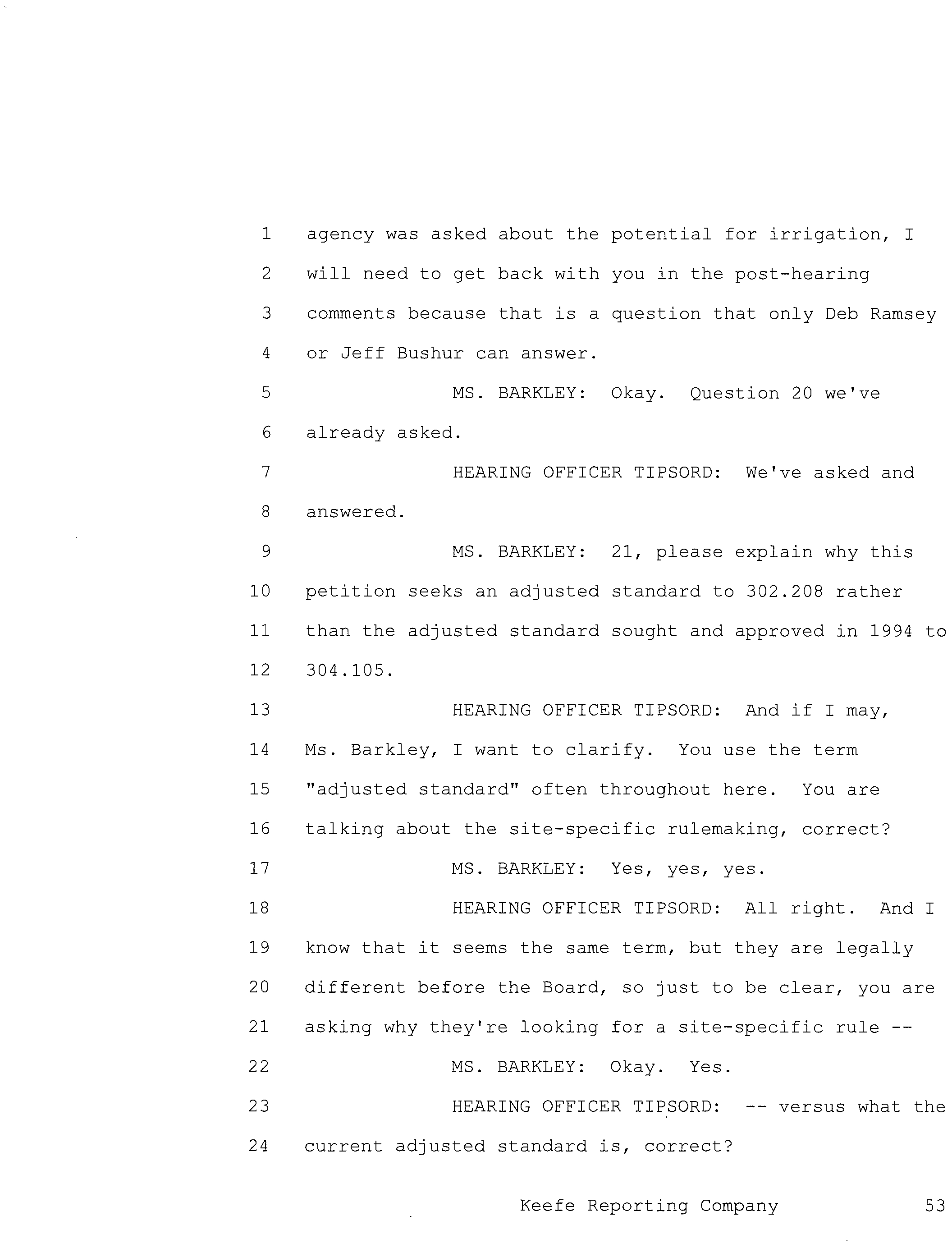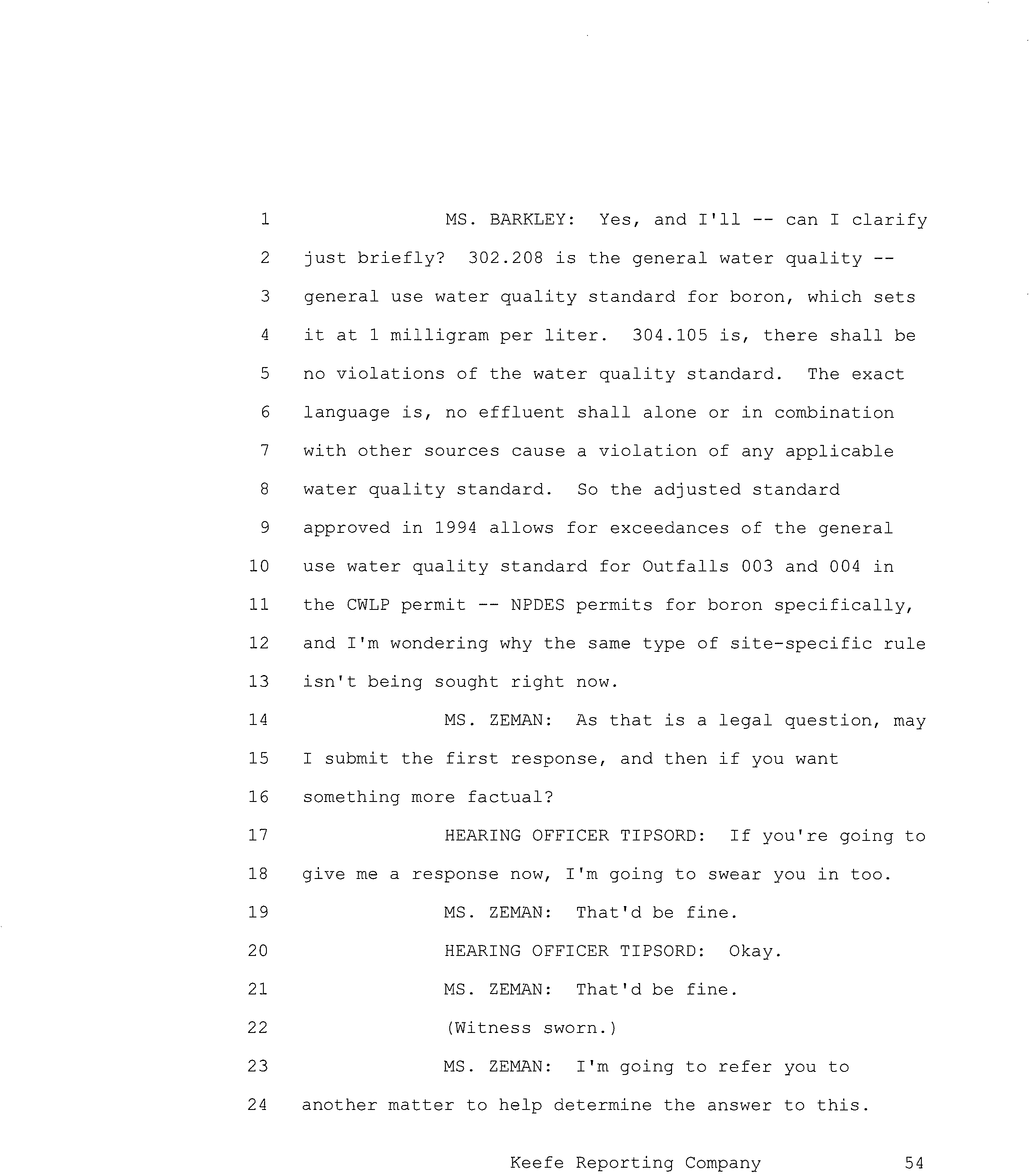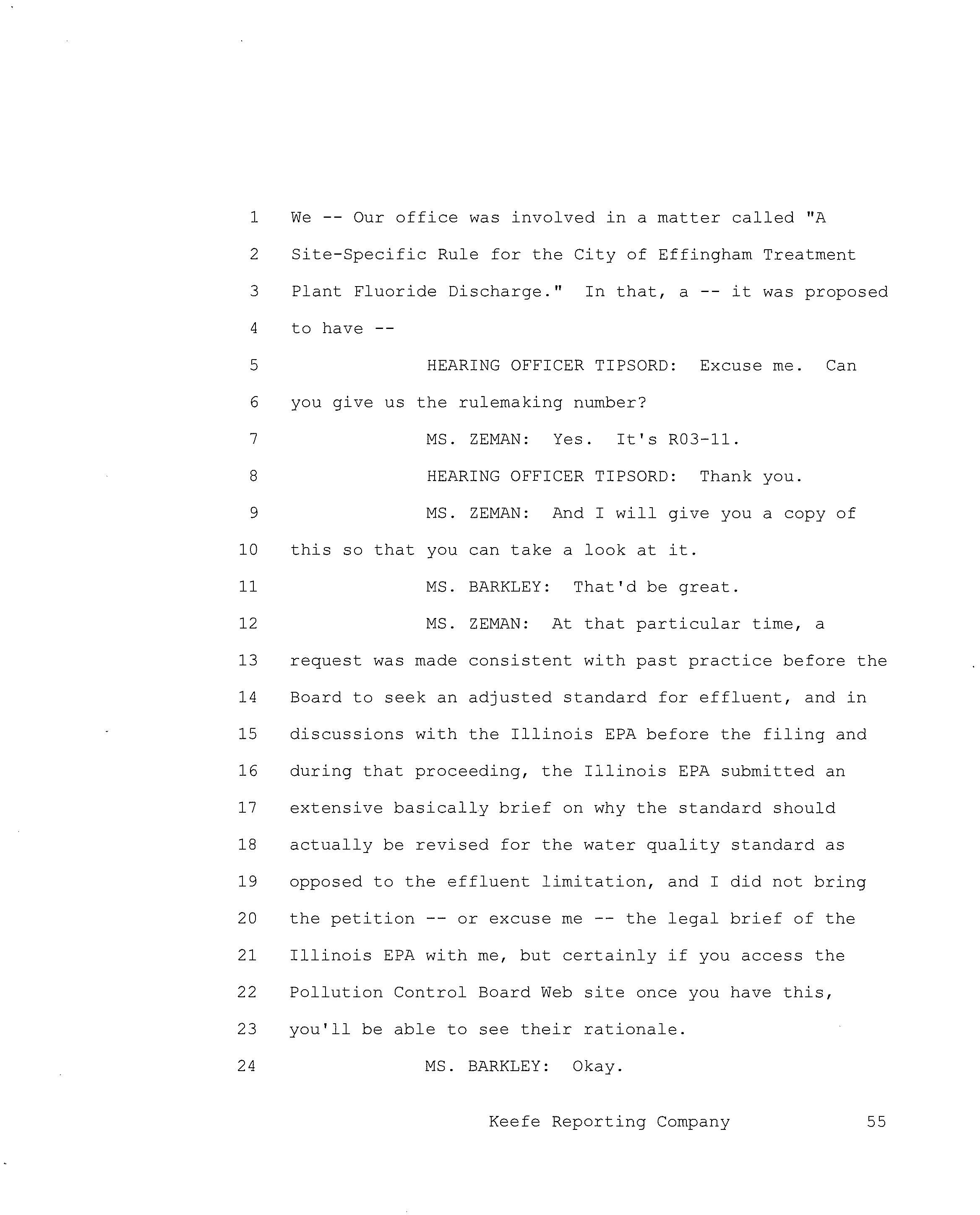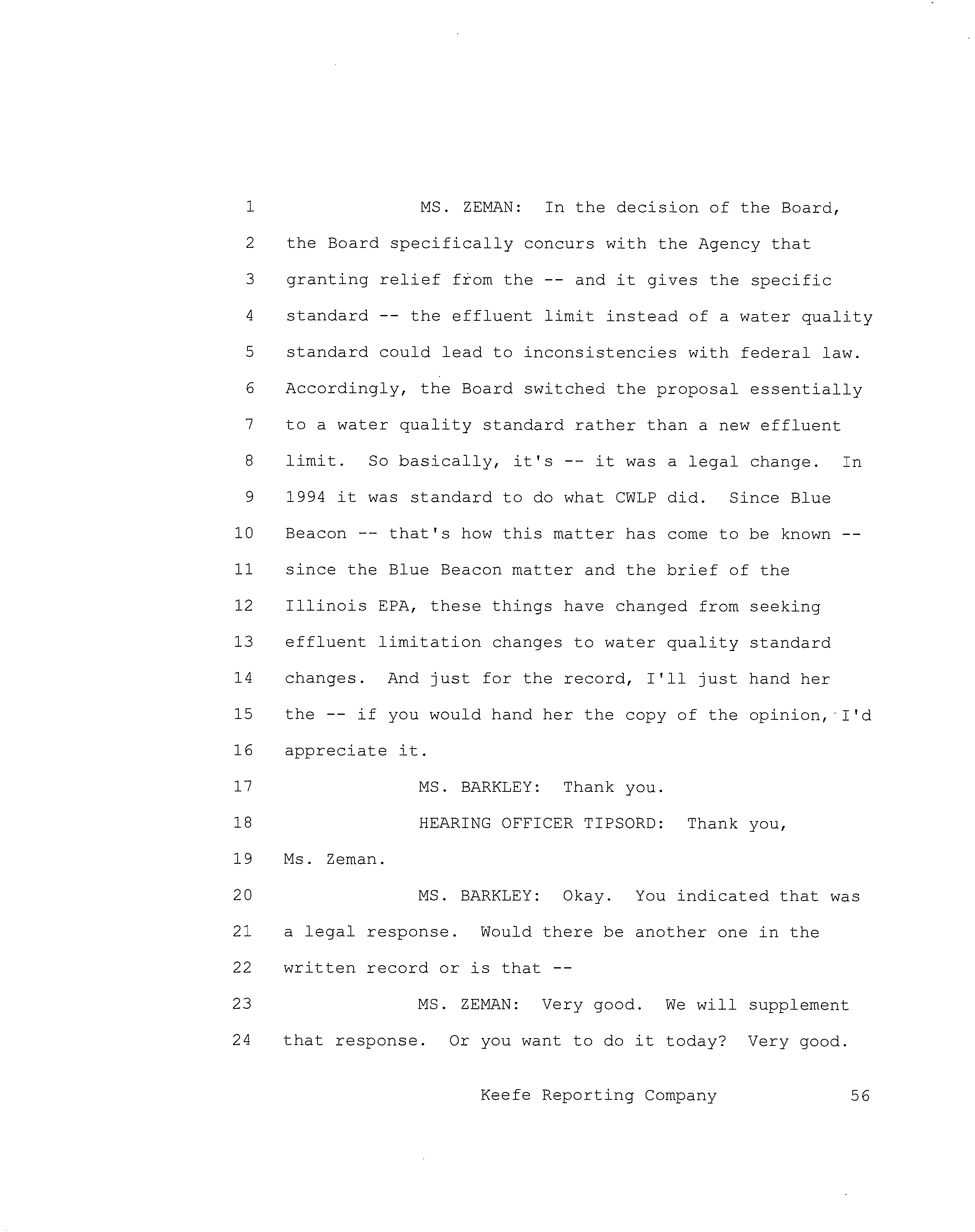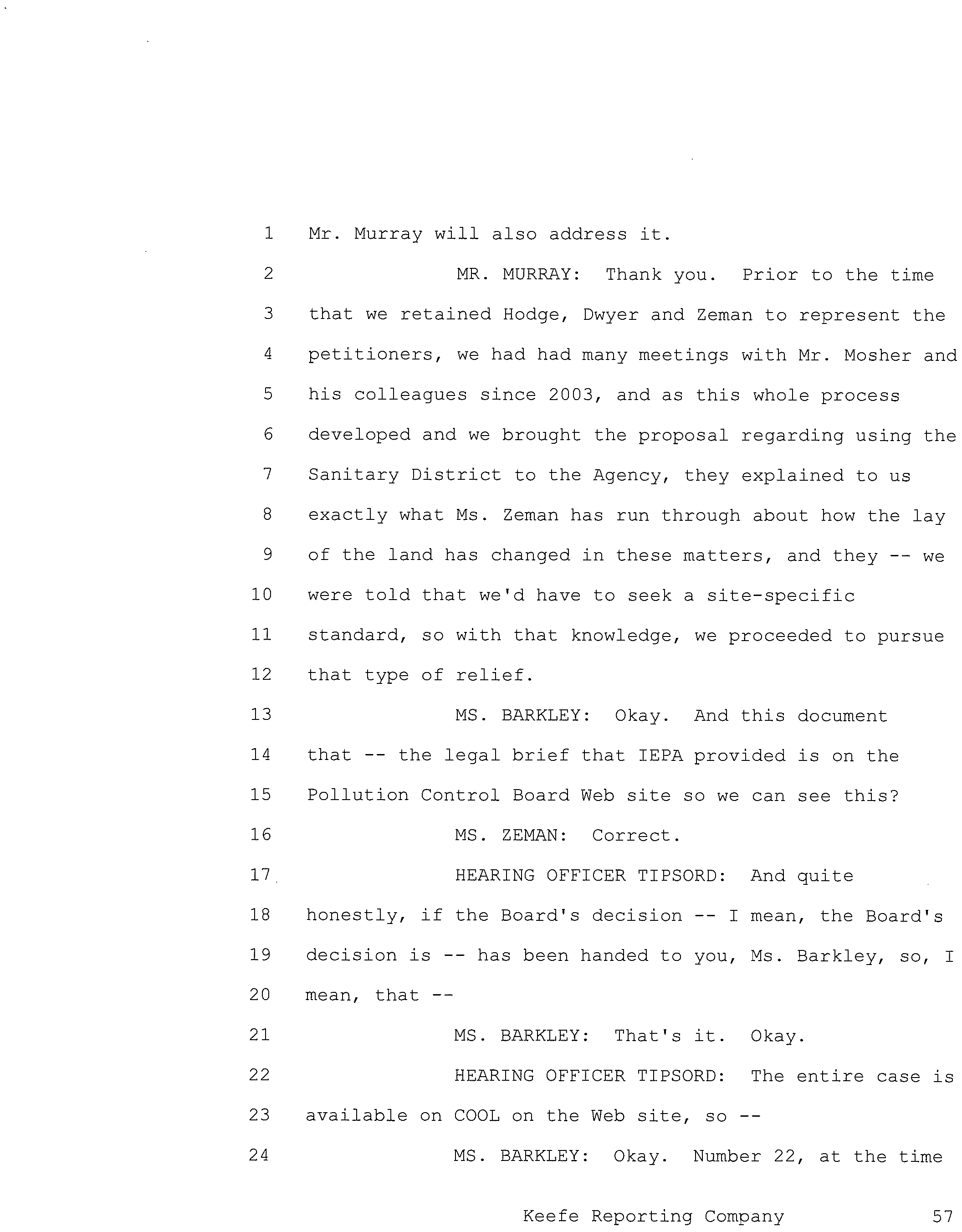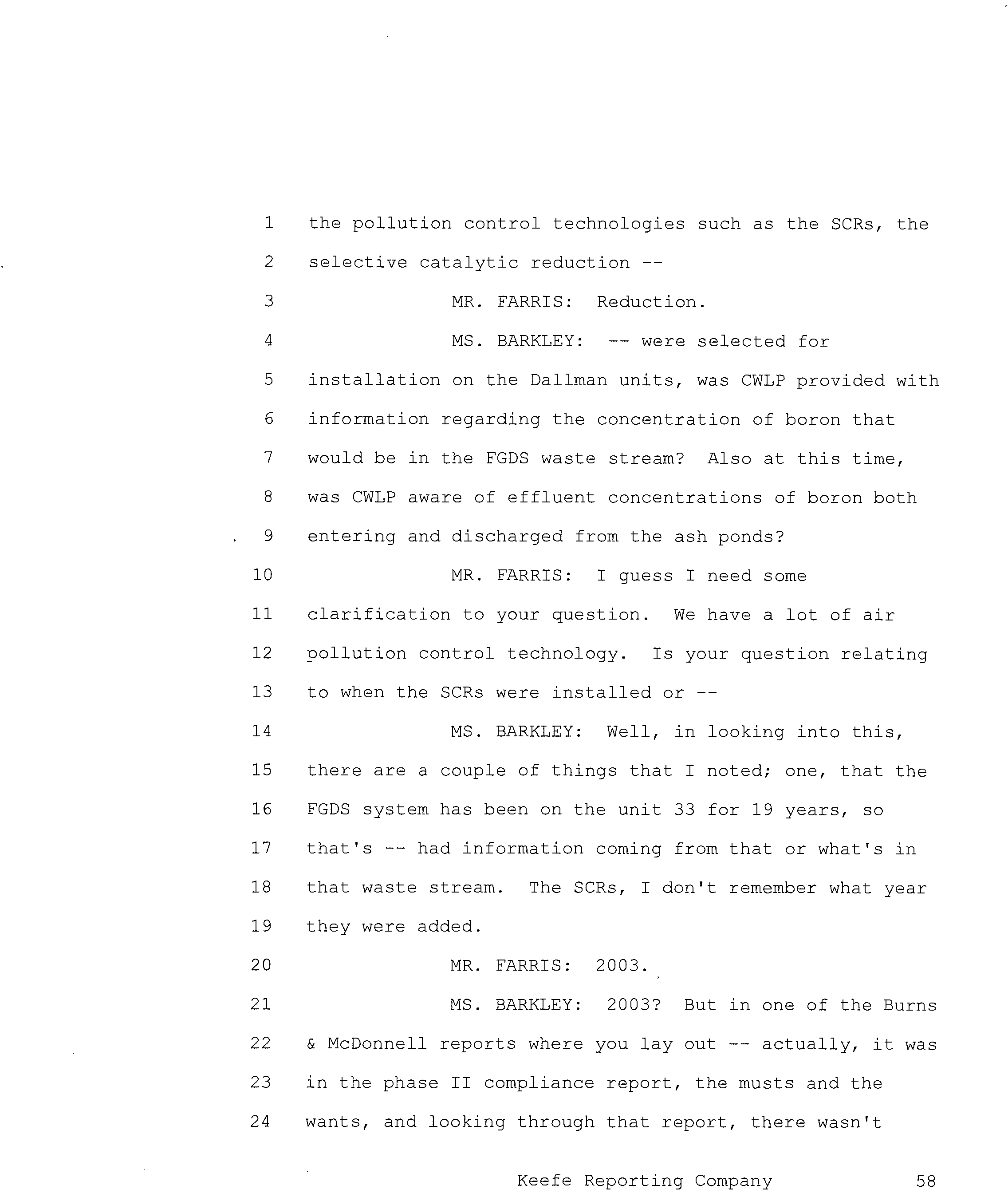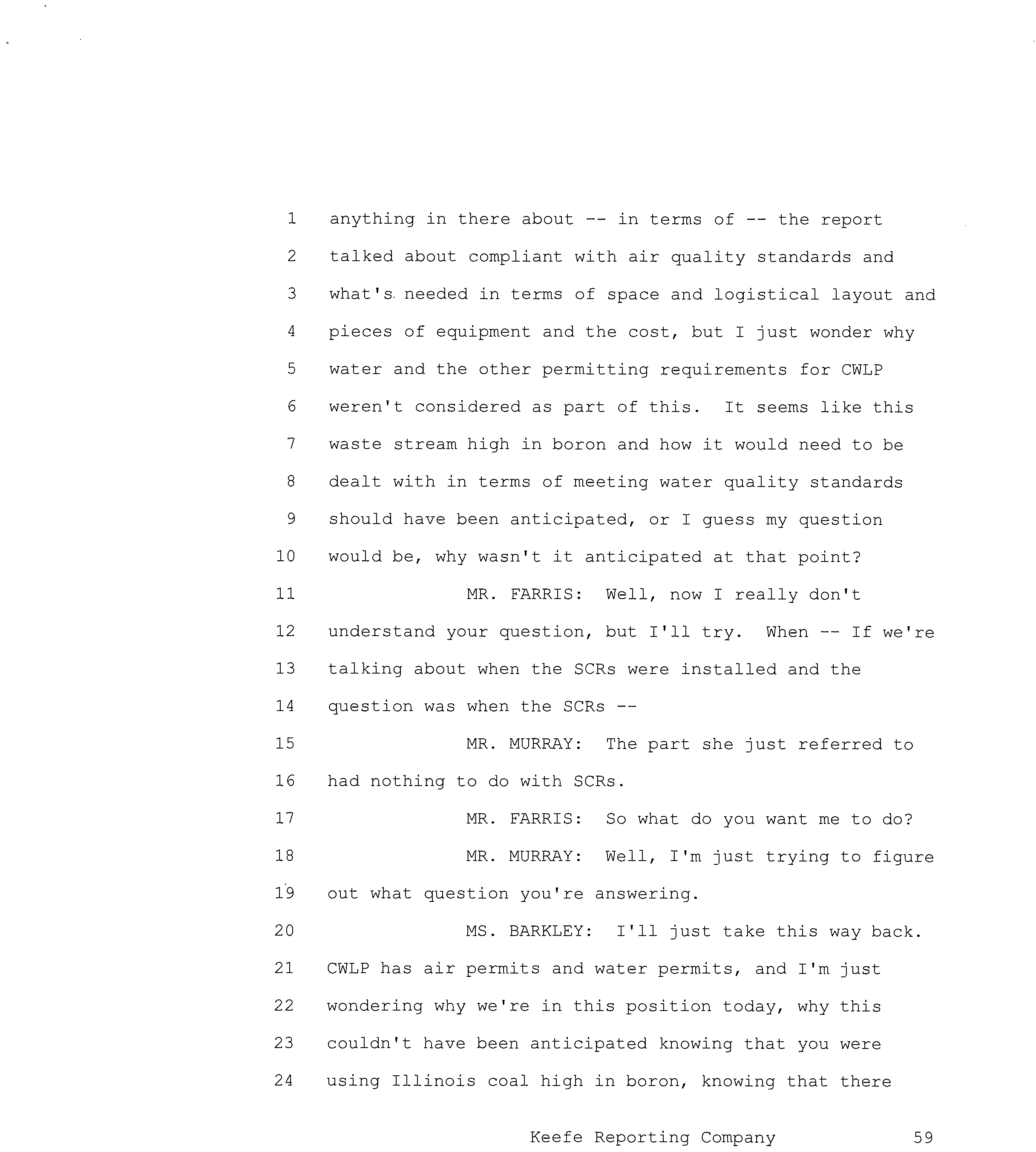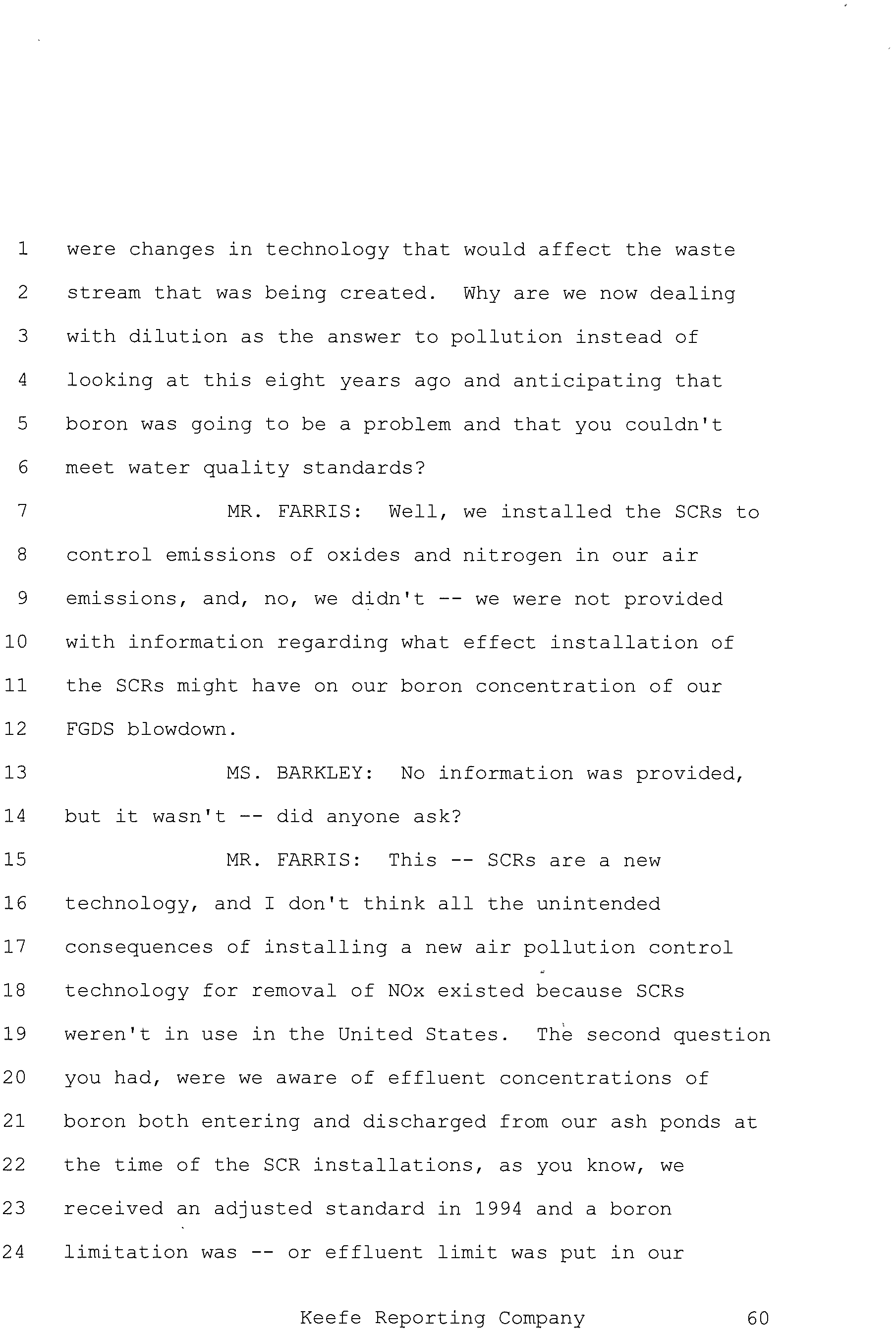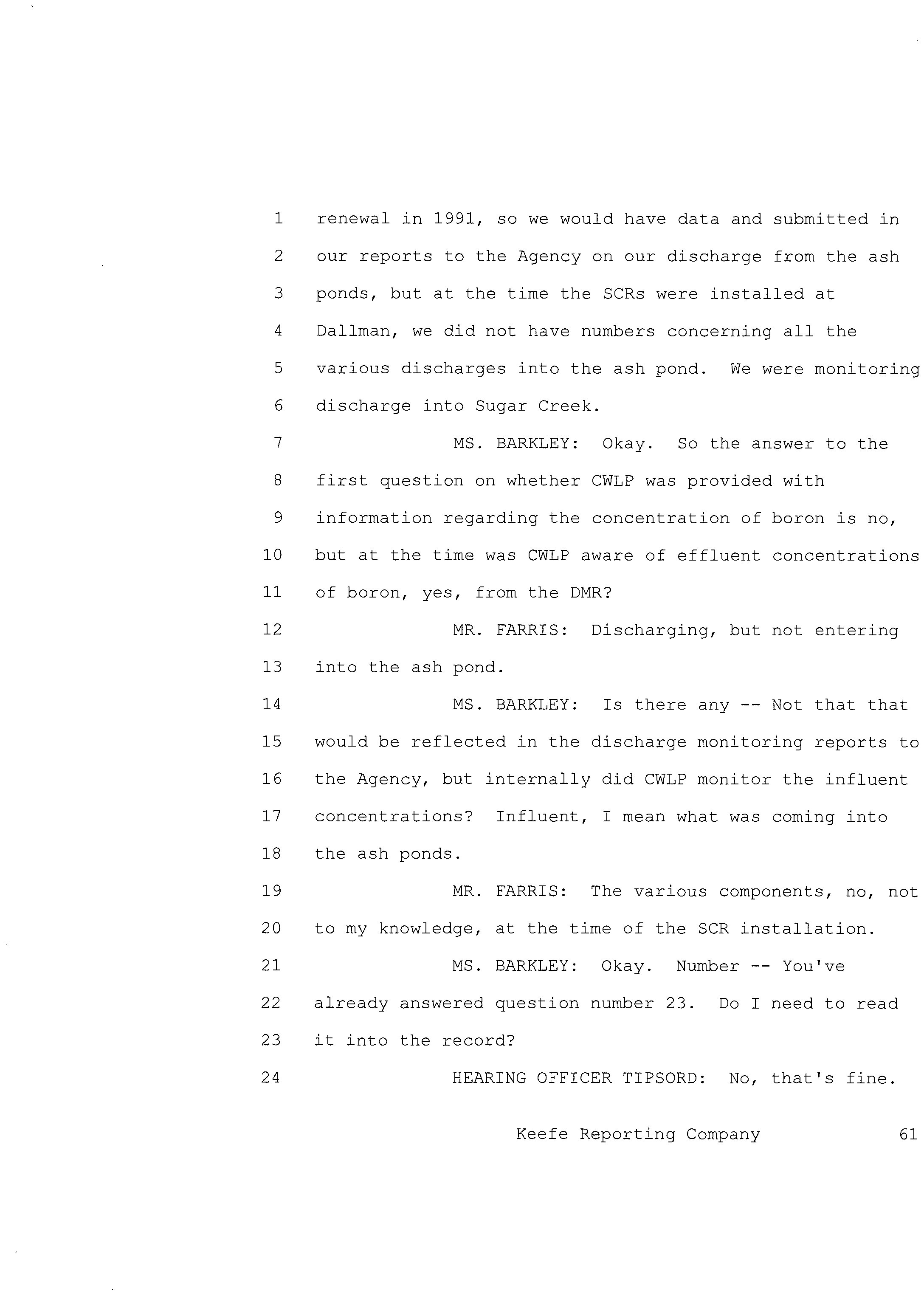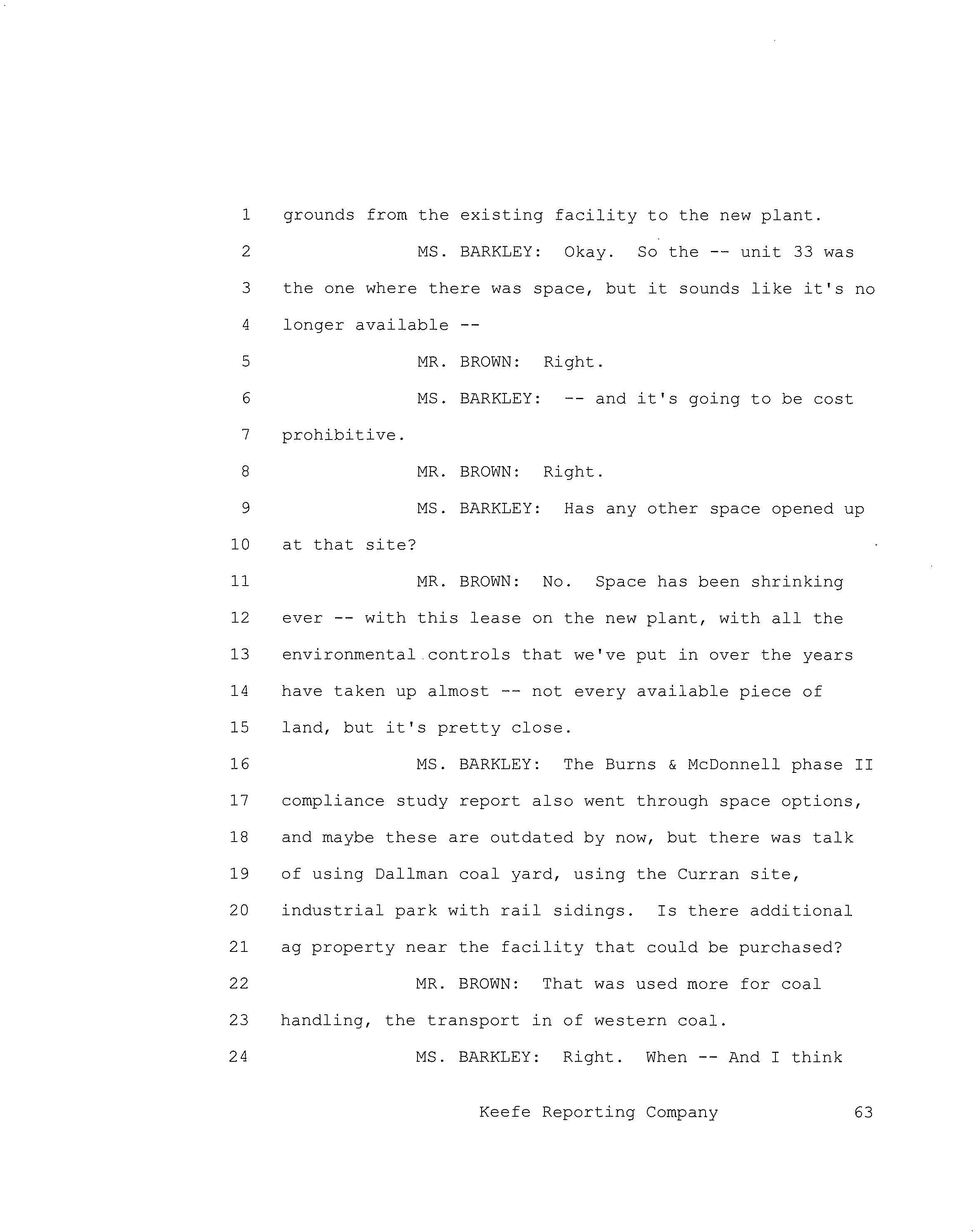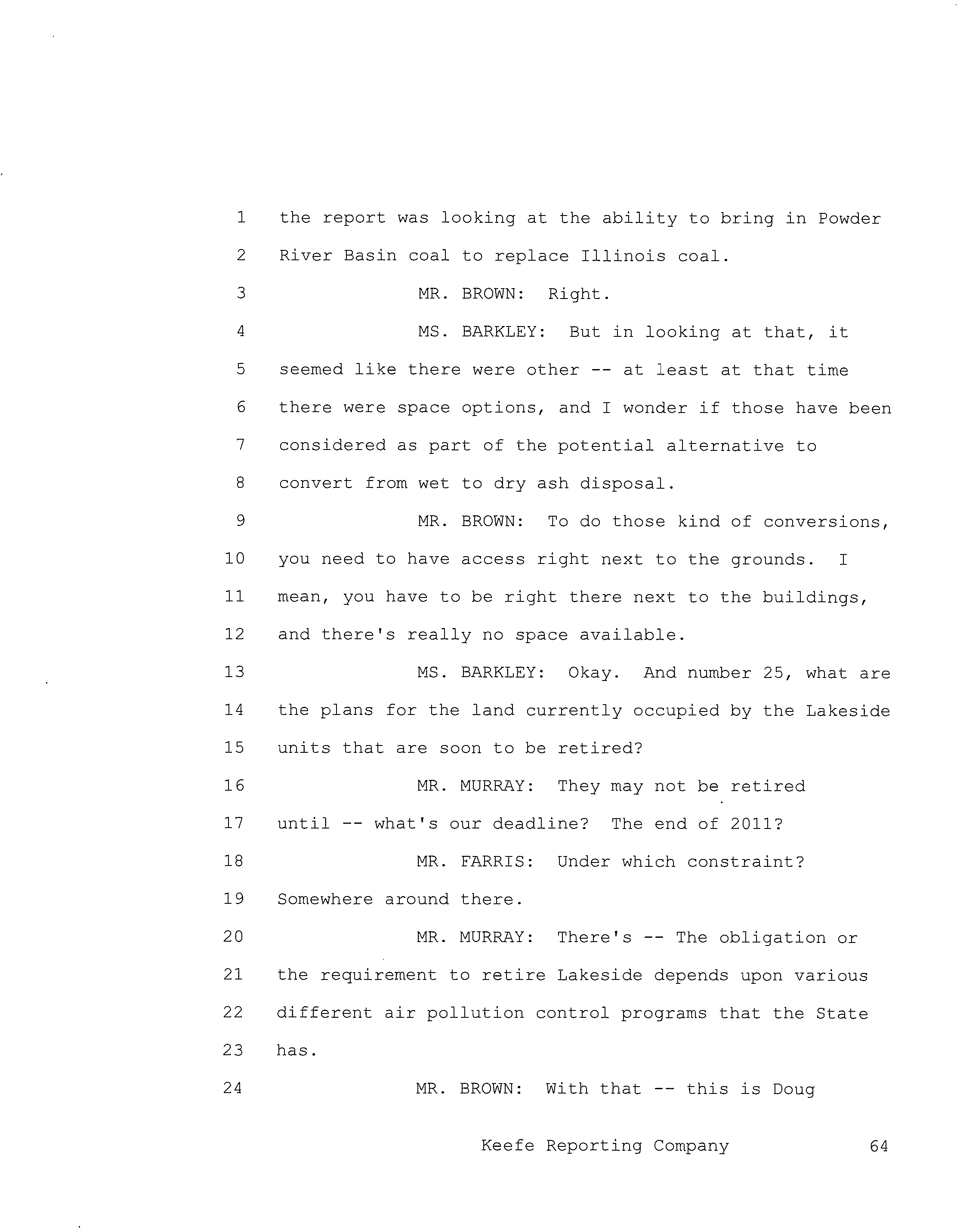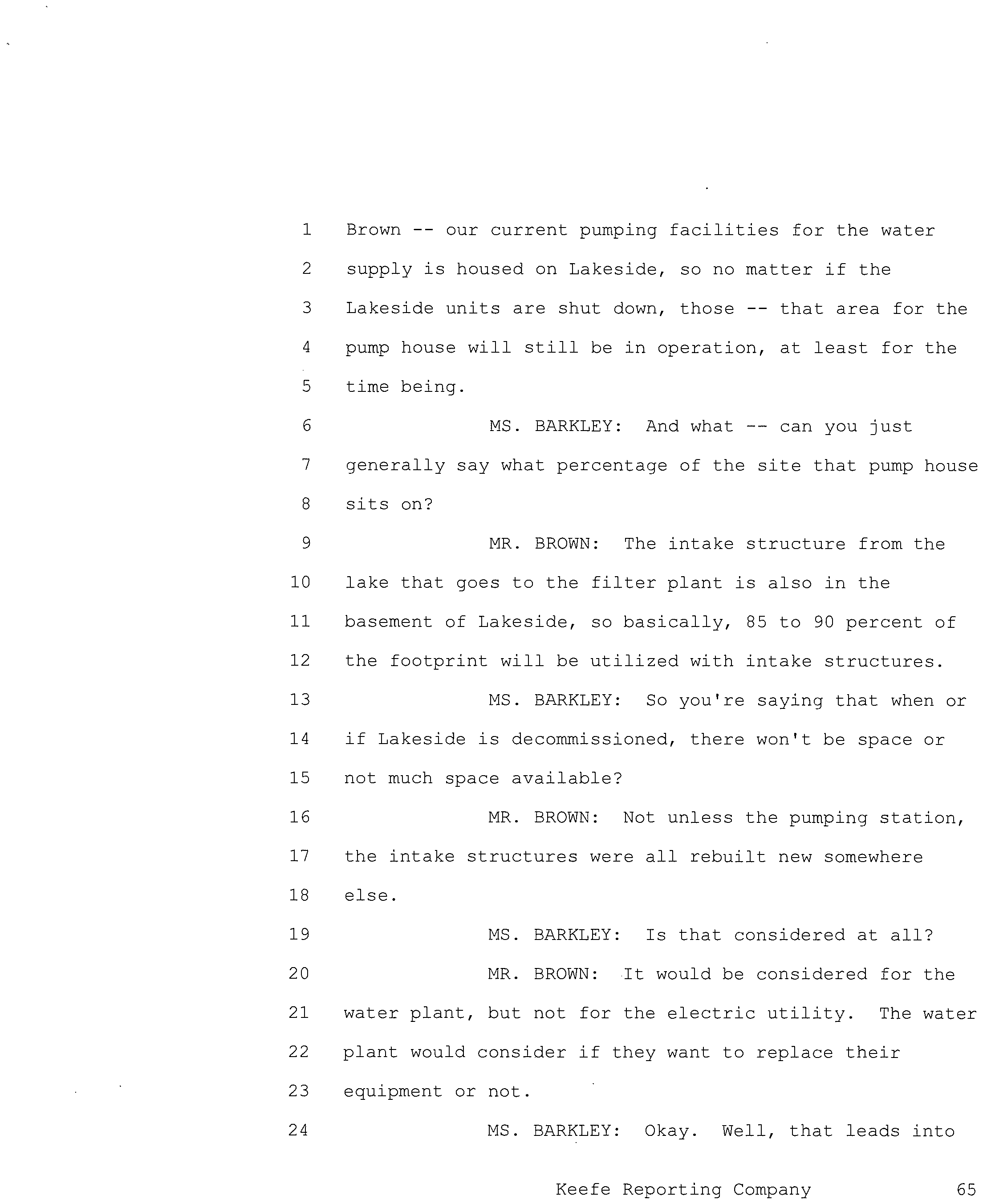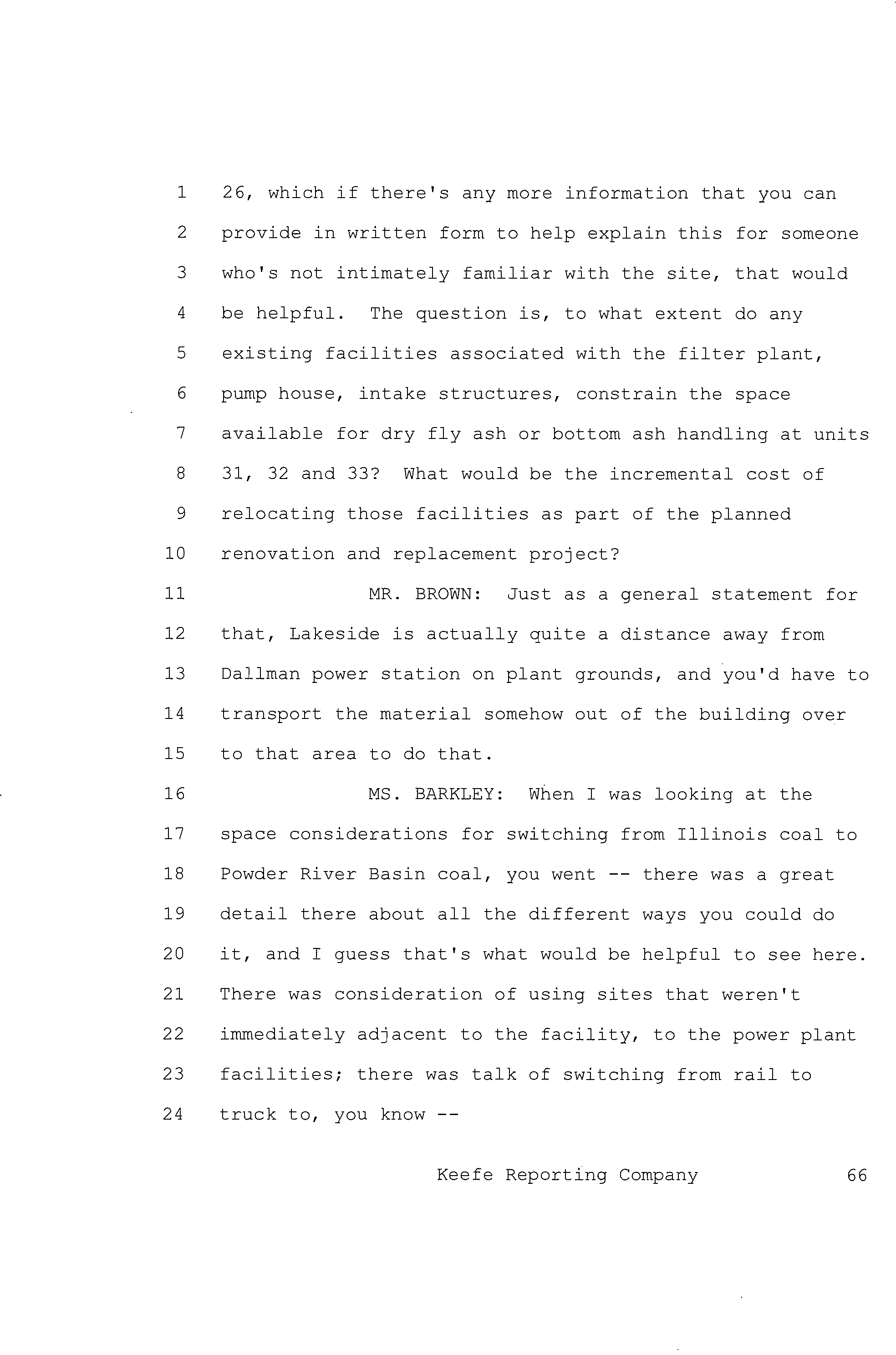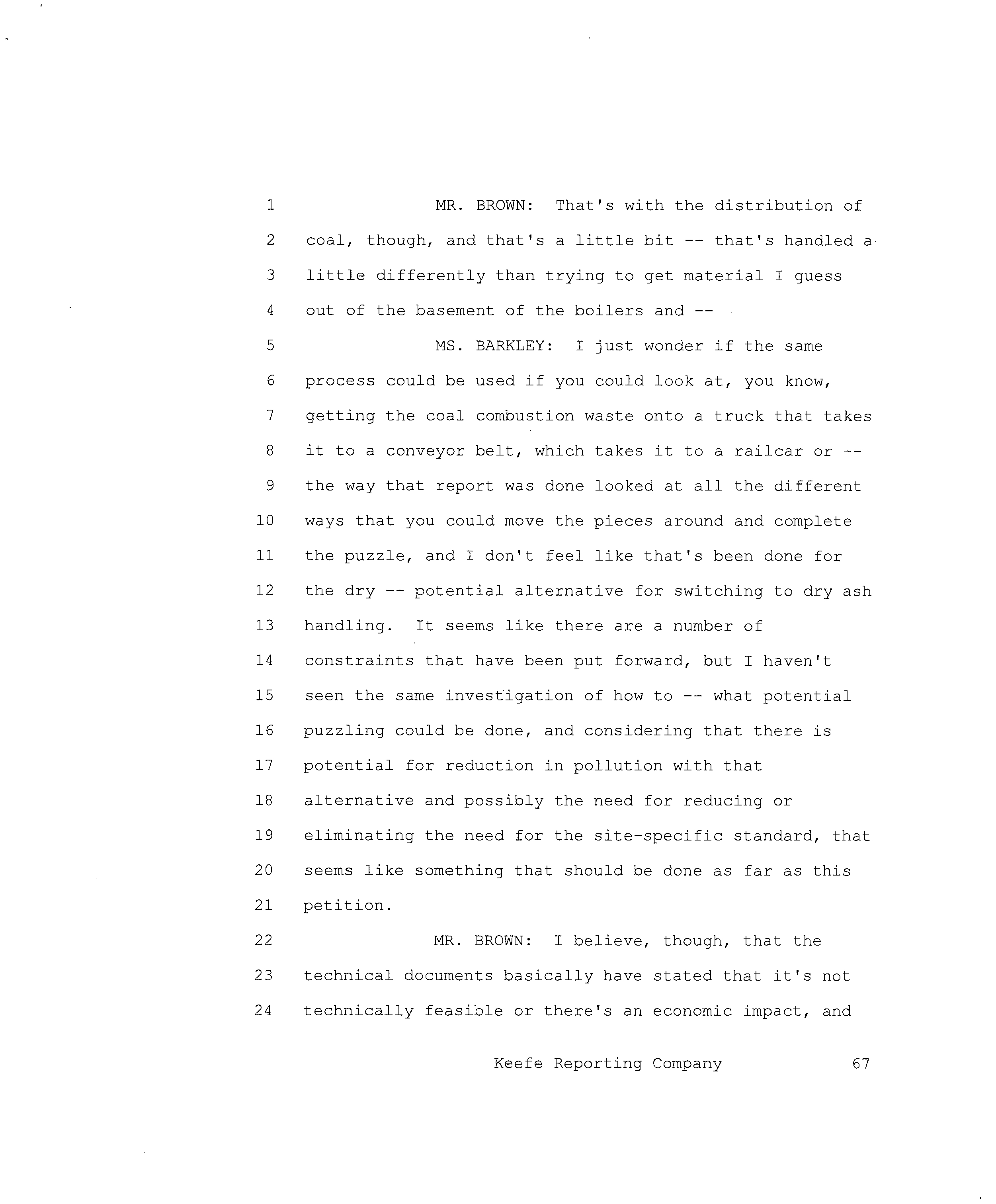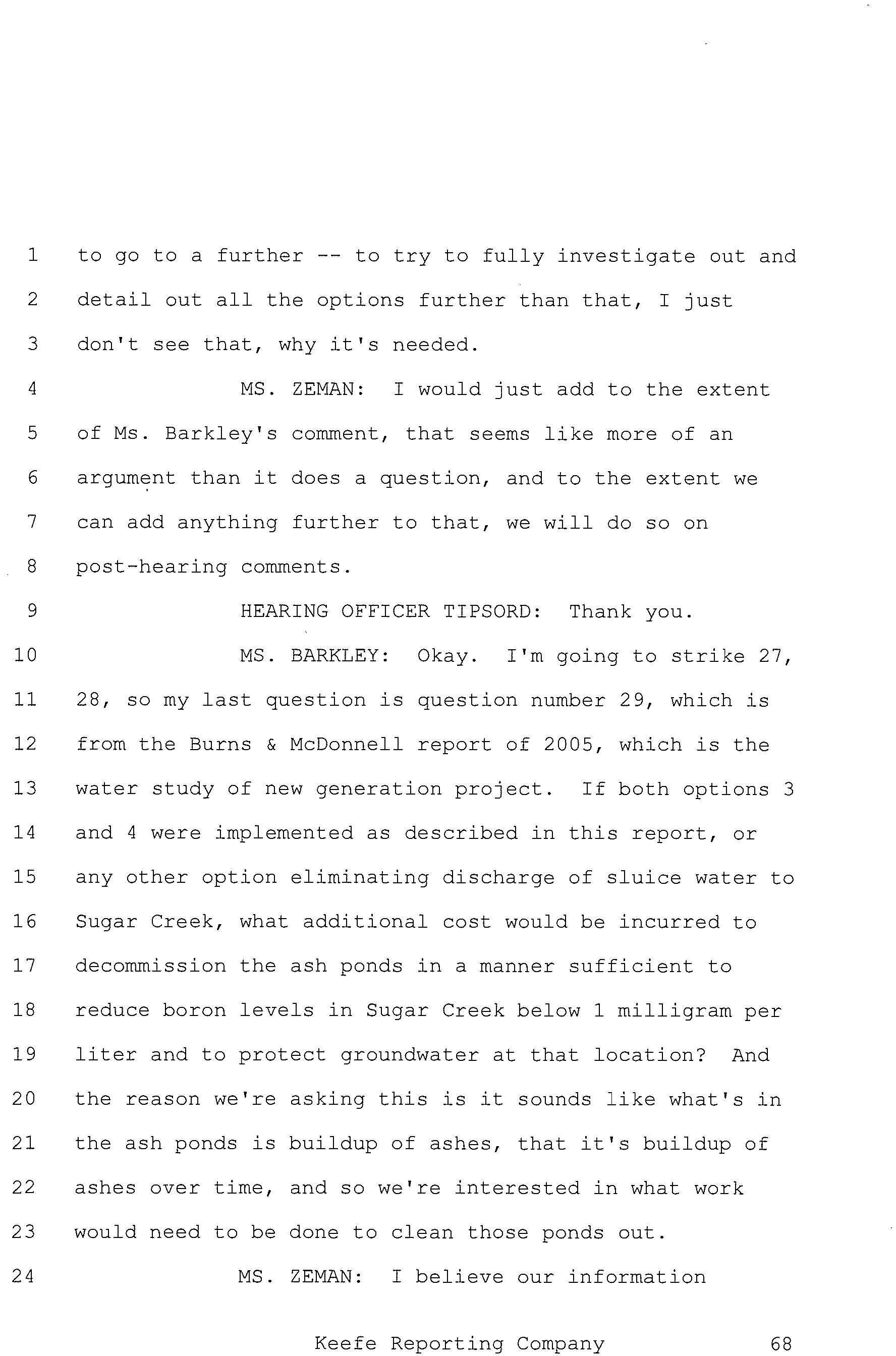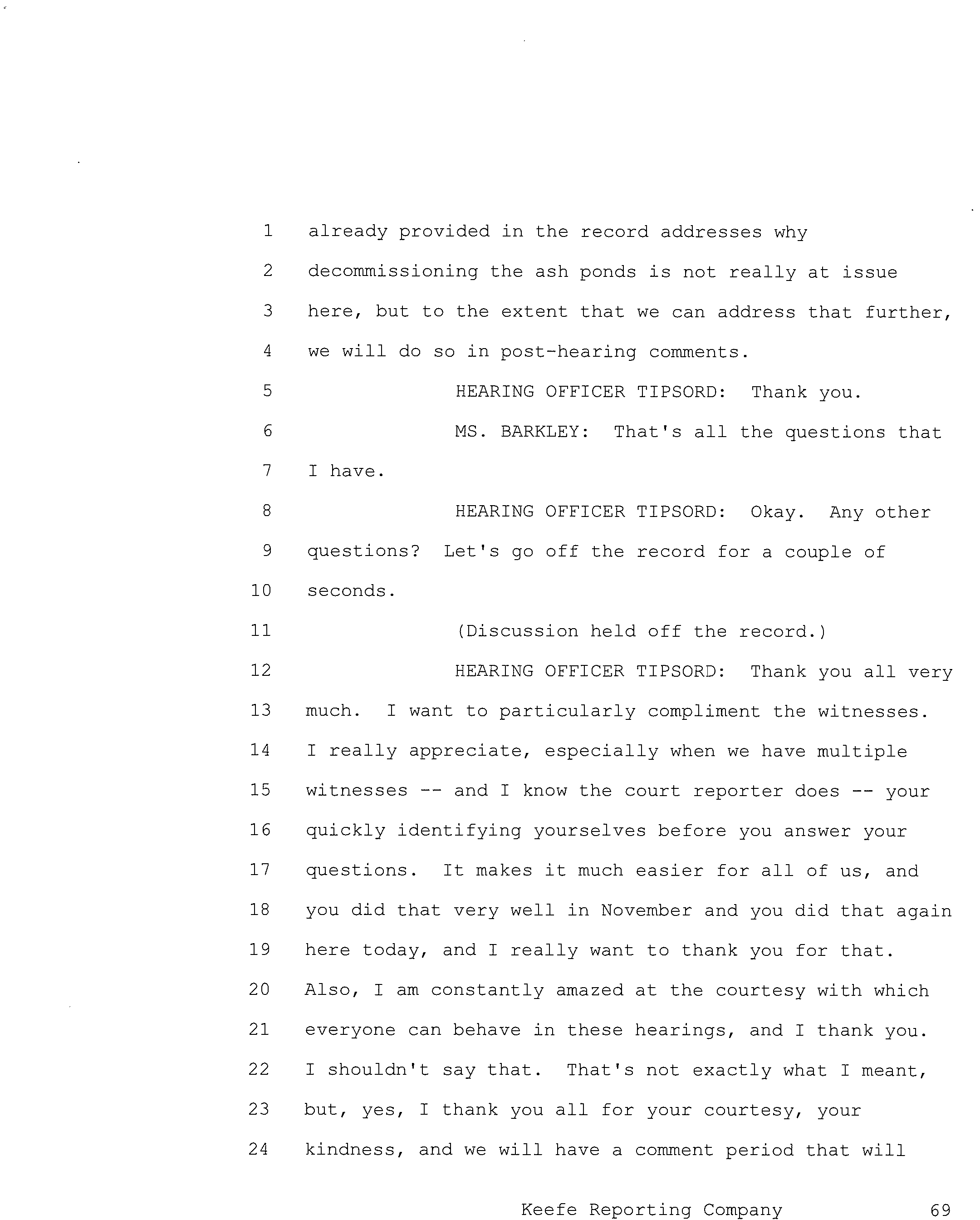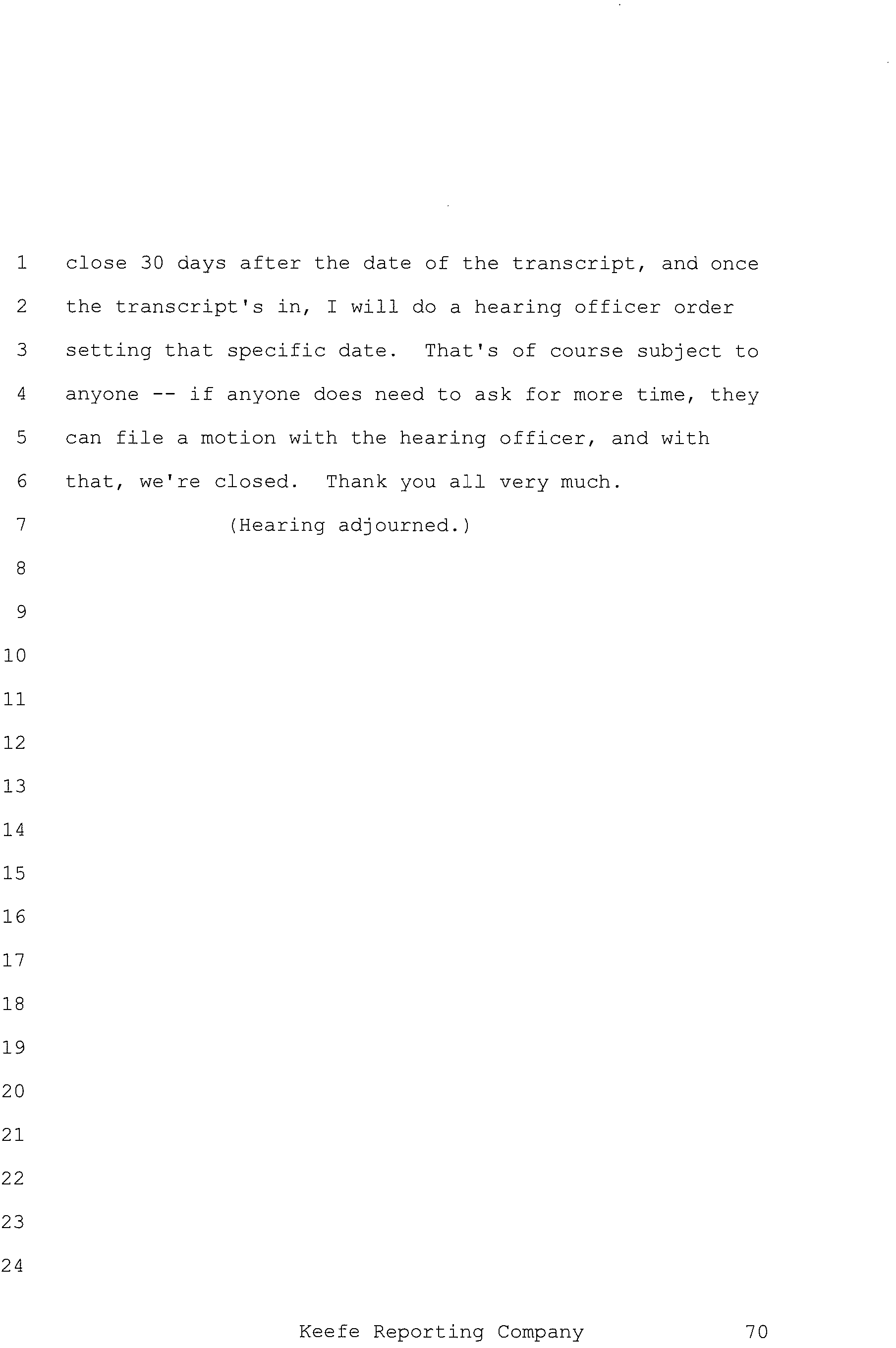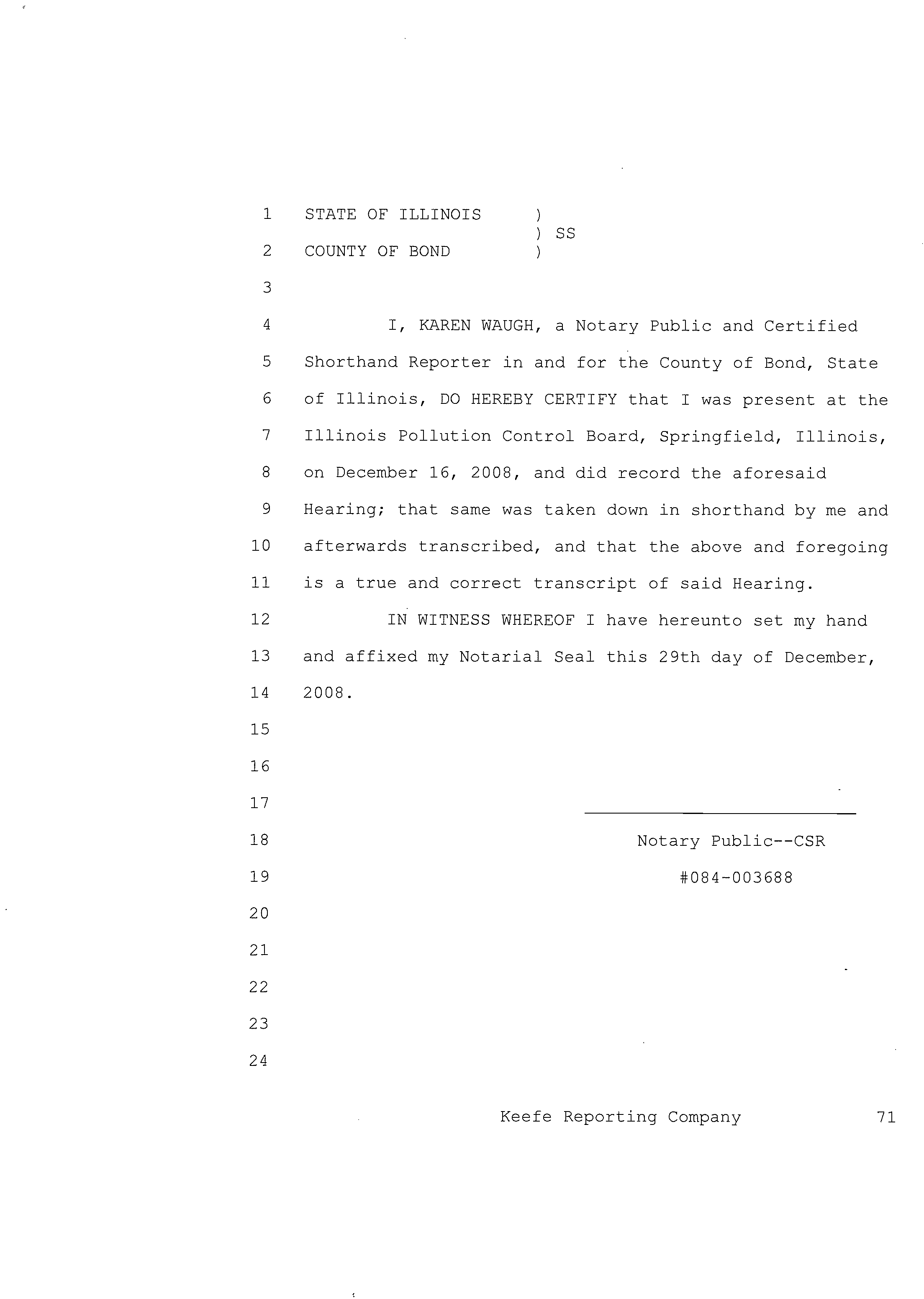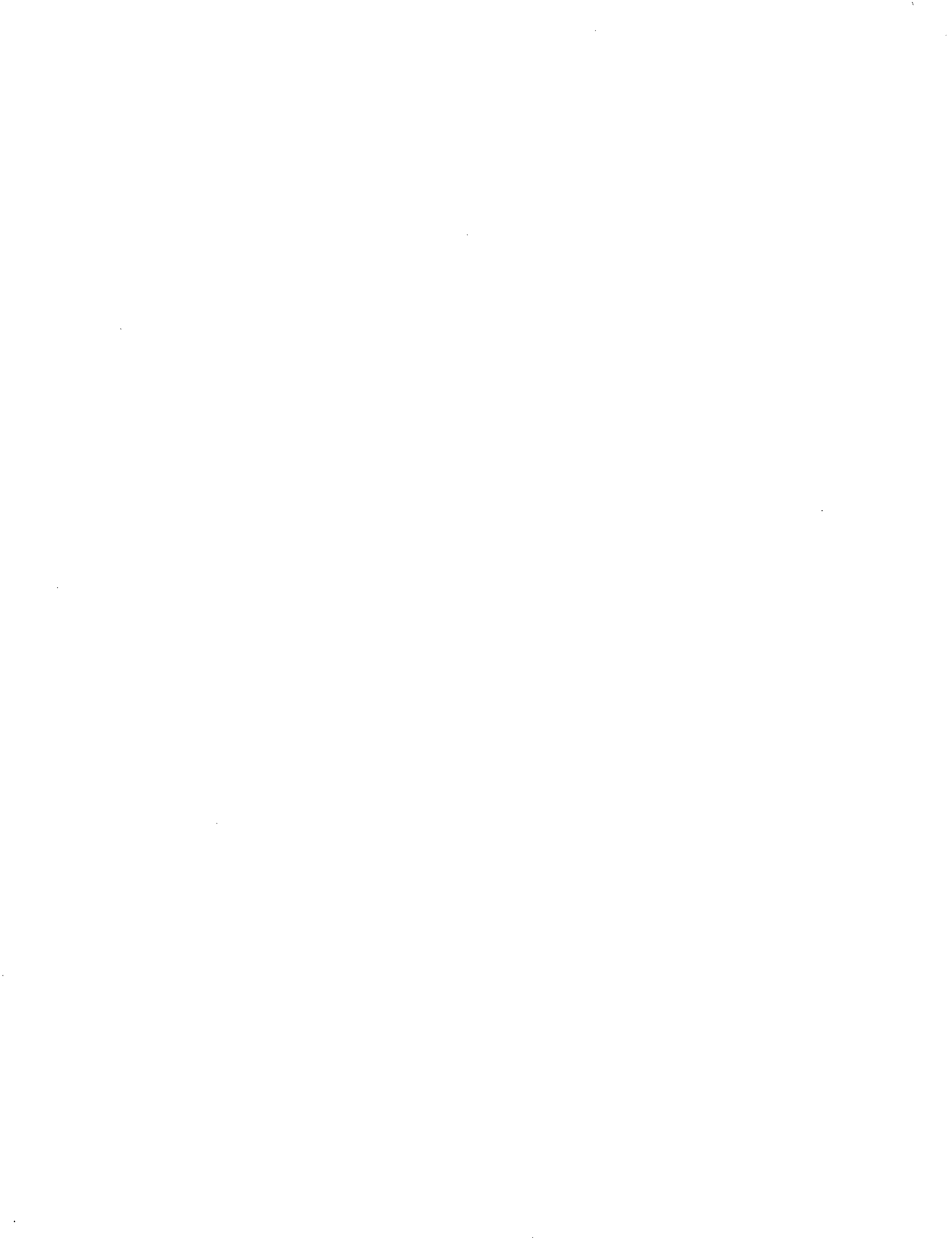1
BEFORE THE
ILLINOIS POLLUTION
CONTROL BOARD
2
3
IN THE
MATTER OF:
4
PROPOSED
SITE SPECIFIC
RULE
FOR
CITY OF
5
SPRINGFIELD,
ILLINOIS,
)
R09—8
OFFICE
OF PUBLIC
)
(Site—Specific
6
UTILITIES, CITY
WATER,
)
Rulemaking
- Water)
LIGHT and
POWER
and
7
SPRINGFIELD
METRO
SANITARY
DISTRICT FROM
35
ILL.
ADM.
8
CODE
302.208(g); NEW
35
ILL. ADM. CODE
303.446
9
10
Proceedings
held on December
16, 2008,
at
10:11
a.m., at
11
the Illinois Pollution
Control Board,
1021 North
Grand
Avenue
East,
Springfield, Illinois,
before Marie
E.
12
Tipsord,
Hearing Officer.
13
14
15
16
Reported By:
Karen
Waugh, CSR, RPR
CSR License
No:
084—003688
17
KEEFE REPORTING
COMPANY
18
11 North 44th Street
Belleville,
IL 62226
19
(618)
277—0190
20
21
22
23
24
Keefe Reporting
Company
1
APPEARANCES
2
3
Board Members present:
4
Chairman
G. Tanner Girard
Board Member
Thomas E. Johnson
S
Board
Member Shundar
Lin
6
7
8
ILLINOIS ENVIRONMENTAL
PROTECTION
AGENCY
9
BY:
Ms. Joey Logan-Wilkey
Assistant
Counsel
10
Division of Legal
Counsel
1021
North Grand Avenue
East
11
Springfield,
Illinois 62794—9276
On behalf of the
Illinois
EPA
12
13
14
HODGE
DWYER ZEMAN
BY:
Ms. Christine
G. Zeman
15
BY:
Ms. Katherine
D. Hodge
BY:
Ms.
Lauren C. Lurkins
16
Attorneys
at Law
3150
Roland
Avenue
17
Springfield,
Illinois
62705—5776
On
behalf
of
the City of Springfield,
Illinois,
18
Office of
Public
Utilities,
City Water,
Light and
Power and
Springfield Metro
Sanitary District
19
20
21
22
23
24
Keefe Reporting
Company
2
INDEX
2
WITNESS
PAGE NUMBER
3
CWLP Panel
13
Bill Murray
4
Dave Farris
Doug Brown
5
Gregg
S.
Humphrey
20
Traci Barkley
23
6
Robert
G. Mosher
39
Christine G. Zeman
54
7
8
9
10
11
12
13
14
15
16
17
18
19
20
21
22
23
24
Keefe Reporting Company
3
NJ
N)
[\)
N)
NJ
F—i
N-
H-
H-
F-’
F-’
H-’
F-’
F-’
F-’
(J
N)
F-’
—i
g)
(ii
U)
NJ
F-’
LO
CO
—J
0)
U)
Ui
NJ
F-’
0
CD
x
H
0
H
C)
CD
0
r1
CD
1
CD
0-
CD
CD
CD
><
CD
F-
o
H
F
rt
H-
C!)
0
0
0
‘-0
Di
0
1<
1
PROCEEDINGS
2
(December 16, 2008;
10:11 a.m.)
3
HEARING OFFICER
TIPSORD:
Good morning.
My
4
name
is Marie Tipsord,
and I’ve been
appointed by
the
5
Board
to
serve
as a
hearing
officer in this proceeding
6
entitled
“In the
Matter
of
Proposed
Site
Specific
Rule
7
for
the
City
of Springfield,
Illinois,
Office of Public
8
Utilities,
City Water, Light
and
Power
and Springfield
9
Metro
Sanitary District
from
35
Ill. Adrnin
Code
10
302.208(g); New 35
Illinois Admin
Code
303.446. With
me
11
today to my right
is the presiding
board member,
Acting
12
Chairman G.
•Tanner Girard.
To his immediate
right
is
13
Board
Member Dr. Shundar
Lin, and to my immediate
left
is
14
Board
Member Thomas
Johnson.
15
This rulemaking
was sent
to
first notice by
the
16
Board
on September 16,
2008, and was published
for
first
17
notice on October
10, 2008, at 32
Ill. Req. 16303.
The
18
Board held its
first hearing in
this proceeding
on
19
November 3,
2008.
20
The purpose of today’s
hearing is
twofold.
21
First,
this
rulemaking
is subject to Section
27(b) of
the
22
Environmental
Protection
Act. Section
27(b) of the
Act
23
requires the
Board to request the
Department of
Commerce
24
and Economic
Opportunity to
conduct an economic
impact
Keefe Reporting
Company
5
1
study on certain
proposed rules prior to the
adoption
of
2
those rules.
If
DCEO chooses to conduct the
economic
3
impact
study, DCEQ has 30 to 45 days after
such request
4
to produce a study of the economic
impact of the
proposed
5
rule. The Board must then make
the economic impact
study
6
available
or DCEO’s explanation
for not conducting
the
7
study available
to
the
public for at least 20
days before
8
public hearing on the
economic impact of the proposed
9
rule.
10
In accordance with
Section 27(b) of the Act,
the
11
Board requested by
a
letter
dated September 18, 2008,
12
that DCEO conduct an economic
impact study for the
13
above—referenced
rulemaking. The
Board has received
no
14
response.
A copy of the Board’s letter
is available
here
15
in the middle
of
the table, and we will
accept comments
16
concerning DCEO’s
actions today.
17
The second
reason for today’s hearing
is that we
18
have questions that have
been prefiled, and on
December
19
12, the petitioner
filed
a motion to strike
questions
or
20
clarify and a motion
to exclude
witnesses
of Prairie
21
Rivers Network. As they
laid out in both of those
22
motions, the response
time
will
not have had time
to run
23
by today’s hearing.
Therefore, before I rule
on the
24
motions, which I will
do so orally here
at the hearing,
I
Keefe Reporting Company
6
1
will
allow anyone to respond
to
the
objections on the
2
record
and then make my ruling. We will first
address
3
the motion to strike the
questions, and with that, I
4
think we’ll go ahead and
do that, and is there any
5
response to the motion
to strike? Did you have
a
6
response?
7
MS. BARKLEY:
I’d like to respond.
I went
8
through and I --
9
THE REPORTER:
Can I
have
your name, please?
10
MS. BARKLEY:
Traci Barkley, T—R—A—C—I,
11
Barkley, B-A-R-K—L-E-Y.
I’m with
Prairie Rivers Network.
12
I went through each of our questions
and looked at the
13
comments that were made in the motion
to strike or
14
clarify, and
I’d like the opportunity to clarify why
15
these questions were
asked. There were only two
16
questions where I can
see
where
the questions that were
17
asked might be somewhat irrelevant
to this adjusted
18
standard, and those were number 27 and
28.
19
HEARING OFFICER TIPSORD:
Okay.
20
MS. BARKLEY:
And I don’t know if
you want
21
me to go through and -- question by question,
but I can
22
generally
say
that
some of ——
as far as some of the
23
questions
being related to Hunter Lake or being
used for
24
discovery,
that’s not the case at all. It’s
actually
as
Keefe Reporting Company
7
1
we’re working
on another issue, which
is the Hunter
2
proposed reservoir, we’ve learned
of information that
3
applies to CWLP’s practice
that do
have
bearing, I
think,
4
to the
adjusted standard in terms of other options,
which
5
is why
questions weren’t asked before. I think
this
6
process has
moved
very quickly and it’s
—- I feel like
7
we’ve
worked
within the guidelines and
timelines that
8
have
been
given,
but it has taken the
full amount of
time
9
that’s been
given
to us to process information,
10
understand it and be ble to ask the
questions that we’d
11
like
to ask today.
12
As far as new information or repeat
questions
13
that
petitioner thinks that have already
been answered,
14
some of these
questions
were
answered in part either
in
15
our phone conference or
at the last hearing, but the
way
16
these questions are phrased,
they’re asking for the
17
petitioner to expand on the answer
that was given.
I
18
don’t feel like any of the questions
that have been
asked
19
have been fully answered or answered
in the way that
20
we’ve been asked —— or that we’d like
to ask them today.
21
HEARING OFFICER TIPSORD:
Okay.
Any other
22
comments, response? Would
you
like
to reply?
23
MS. ZEMAN:
If I may.
My name is Christine
24
Zeman. With respect to the
last part about those
that
Keefe Reporting
Company
8
1
may have been asked
before
in
part and now sought
to be
2
clarified, that
opportunity
was had on November
3.
If we
3
did not answer
a question
adequately at
that
time,
then
4
it
would
be up to
Prairie Rivers
at
that point
when all
5
of our
witnesses
here, when we
had
Burns
& McDonnell
6
people here
from Kansas City
to
clarify
the answer then
7
if in
fact they did not
believe that we
answered it
8
sufficiently
at that
time.
9
The primary
point we wanted
to make is
that we
10
believe
that
at the conclusion
of the hearing
you made
it
11
very
clear
that the questions
that were
to be filed were
12
to be based
upon the additional
information
that was
13
submitted
or it was repetitious
or they
had basically
14
waived
their opportunity,
and we
see
very
few of those,
15
and
the only ones that
are
that
do appear to
be
based
16
on the new information
are the very
end regarding
a 2005
17
Burns & McDonnell
report, and those
questions
indeed
do
18
pertain
to
an
entirely different
project rather
than the
19
site—specific
rule. So
we believe
that we’re
justified
20
in doing that.
We’re
not trying to be
obstructionists.
21
To the
extent that
you —— the Board
believes that it
is
22
appropriate
to
answer
some, we
certainly would ask,
23
however, that we
be
allowed
to do so in writing
after
24
this hearing.
Keefe
Reporting
Company
9
1
HEARING
OFFICER
TIPSORD:
Anyone
else?
I
2
would
agree that
at
the
close of
the
last hearing
it
3
seemed
that
it was pretty
clear
that today’s
hearing
was
4
either
supposed
to be
about
questions
regarding
the
5
additional
information
or
the
DCEO
action.
However,
at
6
the
bottom ——
the
bottom
line
and at
the heart
of the
7
matter,
it
is a
rulemaking
proceeding
and
informatiop
8
gathering
is what
we’re
here
to do,
and
if Prairie
Rivers
9
feels there’s
additional
information
to be gotten,
I’m
10
disinclined
to
strike
all
the questions
as a
whole.
What
11
I will
do is
allow
the petitioner
to
reserve
the right
to
12
answer
any
of the
questions
in
writing
that
they
feel
13
they can’t
clarify
here.
I will
also allow
you
to ask
14
for
clarification
from
Prairie
Rivers
Network
about what
15
they’re looking
for
in the
questions
and
take
objections
16
on
a
question—by—question
basis.
17
MS.
ZEMAN:
And is
the
latter part
of
that
18
for
us to ask
here
what exactly
they’re
looking
for?
19
HEARING
OFFICER
TIPSORD:
Let’s
get
it
on
20
the record.
21
MS.
ZEMAN:
Very
good.
22
HEARING
OFFICER
TIPSORD:
Let’s
get
it
on
23
the
record.
24
MS.
ZEMAN:
Very
good.
Keefe
Reporting
Company
10
1
HEARING
OFFICER
TIPSORD:
Okay.
Now, the
2
second
part was
also
a motion
to strike
any
additional
3
witnesses.
Ms.
Barkley,
you
had
indicated
you
might
have
4
a
witness?
Do you
plan to present
a
witness
today?
5
MS.
BARKLEY:
No.
6
HEARING
OFFICER
TIPSORD:
All right.
So we
7
don’t
—— that’s
been mooted
by you’re
not planning
to
8
present
a
witness.
9
MS.
BARKLEY:
We’ll
submit
written
comments,
10
but not knowing
what
we’re
coming
into
and what
would
be
11
left in
terms of
the
additional
questions
and
subject
12
matter
to be
dealt
with
today,
we decided
to
hold off.
13
HEARING
OFFICER
TIPSORD:
And
are you
okay
14
with mooting
that
objection?
15
MS. ZEMAN:
Yes.
16
HEARING
OFFICER
TIPSORD:
Okay.
With
that,
17
then, we’ll
have
Ms.
Barkley
read the
question
into
the
18
record
and then
there
will
be a
chance
to answer.
Again,
19
anyone
may ask
a
follow—up.
I ask
you to raise
your
hand
20
and
let the court
reporter
know who
you are
before
you
21
ask
your question.
Please
speak
one at
a time.
If
22
you’re
speaking
over
each other,
the
court
reporter
will
23
not be
able to
get your
questions
on
the
record,
and any
24
question
asked
by
a board member
or
staff are
intended
to
Keefe
Reporting
Company
11
1
help build
a
complete
record
for
the Board’s
decision
and
2
not
express
any
preconceived
notions
or
bias. And
with
3
that, let’s
go ahead
and at
least
swear
in
your
witnesses
4
again,
if that’s
okay
with
you.
5
MS.
ZEMAN:
Yes,
yes.
Do you
want for
the
6
record
who
all
will be
potentially
answering
the
7
questions?
8
HEARING
OFFICER
TIPSORD:
Yes,
please.
9
MS.
ZEMAN:
Just for
the record,
I would
10
like
to
note that
with
me from Hodge
Dwyer
Zeman
is
11
Katherine
Hodge
and Lauren
Lurkins
to
my
left.
To
the
12
far
left is
Jeff Slead
with
the District,
with
the
13
Sanitary
District,
and then
to my right
is
Bill
Murray,
14
Dave Farris,
Doug
Brown,
and -- with
CWLP.
On the
very
15
end is
Gregg
Humphrey
with
the Sanitary
District,
and
16
then
behind me
are
also representatives
either
of CWLP
or
17
the
District,
and
I’m
not
sure
whether
any
would
be
18
prepared
as
witnesses
today,
so for
now,
probably
——
19
Mr. Nika,
do you
think
you
may
be
answering
any
20
questions?
21
MR.
NIKA:
I
don’t believe
so,
no.
22
MS.
ZEMAN:
Then probably
just
the CWLP
23
witnesses
at the
table
here
can be
sworn.
24
HEARING
OFFICER
TIPSORD:
All right.
With
Keefe
Reporting
Company
12
1
that,
can we have
them sworn?
2
(Witnesses
sworn.)
3
HEARING
OFFICER
TIPSORD:
Anything
else,
4
Ms. Zeman?
5
MS.
ZEMAN:
No.
Thank
you.
6
HEARING
OFFICER
TIPSORD:
Ms. Barkley,
if
7
you want
to go
ahead
and start
with
question
number
1.
8
MS.
BARKLEY:
Okay.
I’d
like
to
ask the
9
question
and then
I’ll clarify
the
points
of the
10
question.
Number
1,
we’ve
learned
from
the final
11
environmental
impact statement,
Section
2.2.6.1,
for
the
12
proposed
dam
and
reservoir
also
known
as Hunter
Lake
that
13
nearly
3.3
million
gallons
per
day of
water
are lost
from
14
CWLP’s unlined
ash ponds
due to
evaporation
and
seepage
15
into the
ground.
Assuming
that
the seeped
water
would
16
drain
towards
groundwater
and Sugar
Creek
and contribute
17
to increased
boron
as well
as other
pollutant
18
concentrations and loading,
why haven’t
these
ponds
been
19
lined? Is
the
water
currently
seeping
from
the ponds
20
causing
violations
of
applicable
groundwater
standards,
21
and if
only
the
flue
gas
desulfurization,
FGDS,
22
wastewater
stream
is
diverted
from the
ponds,
which,
if
23
any,
of
the groundwater
standards
may
be exceeded?
24
The reason
we
ask
this question
is
we are
Keefe Reporting
Company
13
1
concerned
that there is
a loss of
boron through
the
2
groundwater
which would
allow a
lower effluent
3
concentration, which
would
have some bearing
on what
is
4
being dealt with
in this
adjusted standard
and would
also
5
allow an
artificial
estimate of loading
of boron
and
6
other
pollutants
to Sugar Creek and
Sangamon
River.
7
MS. ZEMAN:
Just
for
the record,
because
we
8
had
filed
our motion to strike,
we
actually
had not
9
prepared
to
answer each
question.
May I take a moment
to
10
confer
with my client,
please?
11
HEARING
OFFICER TIPSORD:
Absolutely.
12
(Discussion
held off
the
record.)
13
MS. ZEMAN: We’re
concerned
that the
14
question
does not
have
any
bearing on this
proceeding,
15
nor on the
issue
for
the location here.
To the
extent
16
that there
are issues
about the cost
of the
——
I mean,
17
arguably,
lining of
the
ponds is
a cost issue.
We
might
18
be able to take a
look
at that
in the post—hearing
19
submittal, and
similarly with
groundwater.
There’s
20
nothing in
the record
about that, so we
would have
to
21
reserve
any kind of comment
until
our post-hearing
22
submittal.
23
HEARING
OFFICER
TIPSORD:
Okay.
24
MS.
BARKLEY:
Okay.
I’d like
to
make
just
Keefe
Reporting
Company
14
1
one more
statement expanding
on why
we think this is
2
important.
I
think
both in the
Sargent & Lundy
report
3
and the Burns
& McDonnell report
it was noted
that there
4
is potential
for leaching,
and I can’t say
off the
top of
5
my
head whether there
was evidence that
there was,
but
6
there —— it was put
forward that the
life of these
ponds
7
is limited, and
we’re concerned
that if the ground
is
8
saturated
and if this is a
route of loading these
9
pollutants
in the Sangamon
River and that’s
not figured
10
into
the calculations
and the models that
are predicting
11
what needs to be
done to consider
what is already being
12
contributed to
the
river
or could
be in the future,
that
13
that
gives
an artificial assessment
of what’s
being
14
proposed for
the adjusted dam and
the ability for
the
15
District to
meet what’s being
—— the 11 milligrams
per
16
liter,
4.5 and 2.
17
MS. ZEMAN:
Thank you for
the additional
18
clarification. May
I just —-
19
HEARING
OFFICER TIPSORD:
Sure, absolutely.
20
MS.
ZEMAN:
-- speak
with
Mr. Farris?
21
(Discussion held off
the
record.)
22
MS. ZEMAN: We
will respond
in
writing.
23
Thank you.
24
HEARING
OFFICER
TIPSORD:
Thank you.
Go
Keefe
Reporting
Company
15
1
ahead, Ms.
Barkley.
2
MS. BARKLEY:
Number 2, several
other
3
coal—fired
electric
generating
stations in Illinois
4
currently sell
their
coal
combustion waste
to
be used
as
5
a beneficial
by-product. We’d
like to
know what
fraction
6
of the
ash currently
being produced
by Dallman
units 31,
7
32
and
33 and
what
fraction already
in the
ash ponds is
8
potentially sellable
for construction
or other
uses, and
9
we wonder if
CWLP
has explored
this option.
10
MS.
ZEMAN:
Mr. Brown, do
you
want
to take
a
11
crack
at
that,
please?
12
MR. BROWN:
This is
Doug Brown with
City
13
Water, Light and
Power.
85
percent of our ash
from
33
is
14
fly ash, and
it’s used for fill
material
on construction
15
projects if
they’re available.
85 percent
of the ash
16
from units
31 and 32 is
bottom ash and
is used by asphalt
17
companies.
18
MS.
BARKLEY:
So you’re
saying
that
30
19
percent of the
total ash, fly ash
and
bottom
ash
20
combined,
from
Dallman units
31, 32 and
33
is
being
21
sluiced
right now to the
ponds, the remaining
15 percent
22
and
the
remaining
15
percent?
23
MR.
BROWN: All of it’s
sluiced.
It’s
24
recovered at the
ponds.
Keefe Reporting
Company
16
1
MS. BARKLEY:
Oh,
it’s
recovered
at
the
2
ponds.
Okay.
3
MR. BROWN:
Yeah.
There’s no means
for
us
4
to be
able
to
recover
that
at the Dallman facility
5
itself.
6
MS. BARKLEY:
And could you
repeat 31 and
7
32, the 85 percent
of the bottom ash,
what that’s used
8
for?
9
MR. BROWN:
That’s
used by asphalt
10
companies.
11
MS. BARKLEY:
Asphalt.
Okay.
12
MR.
MURRAY:
Let
me clarify
that.
My name
13
is
William Murray. We
also sell some
of
it
to a
roofing
14
shingle company.
15
MS.
BARKLEY:
And
is there a reason
why
the
16
remaining
15 percent from each
of those waste
streams
is
17
not used?
18
MR.
BROWN:
So
for example,
then for the 33,
19
15
percent of it’s
bottom
ash, which is not
usable,
and
20
then
on 31, 32, 15 percent
is fly ash,
which
is
not
21
usable.
22
MS.
BARKLEY:
Can
you explain why it’s
23
usable
in one
instance and
not in the other?
24
MR. BROWN:
It doesn’t meet
the requirements
Keefe Reporting
Company
17
1
by the vendors.
2
MS. BARKLEY:
Okay.
Thank you.
3
CHAIRMAN GIRARD:
Could I ask
a question,
4
then? If there was
a market for your fly
ash, would
you
5
sell all
of it or
give
it away?
6
MR. MURRAY:
Let me answer
that question
two
7
ways.
First, are you referring
to ash that’s generated
8
now? Because
the ash ponds contain
ash that’s been
9
generated over
a number of years,
so ——
10
CHAIRMAN GIRARD:
Well,
it’s just a very
11
general
question. I mean, is there
any incentive for
you
12
not
to sell it?
13
MR. MURRAY:
We have
explored that, but
14
there are limited markets
in this area for that.
15
CHAIRMAN GIRARD:
So you’re -- it’s not
a
16
desire on your part; it’s
the limits of the market.
17
That’s what you’re saying.
18
MR. MURRAY:
For
us to get rid of all
ash
19
that’s on site, yes.
20
CHAIRMAN GIRARD:
Thank
you.
21
MS. BARKLEY:
I
just
have
one follow-up
for
22
the
Daliman unit 4. Will that
ash also be able to
be
23
recovered
and sold to the same
markets? Actually,
that’s
24
dry ash.
Keefe Reporting
Company
18
1
MR. BROWN:
Daliman
4, yeah, it’s
--- the
fly
2
ash is
dry ash, but there’s
also
other
components
there
‘3
that
probably would
not make
it
sellable to control
4
mercury,
so
that
would
probably
have
to be landfilled
5
somehow. We have
not gotten
into that, though,
yet.
6
MS. BARKLEY:
Okay.
Question
number 3, does
7
a pipeline currently
exist linking
Springfield Metro
8
Sanitary District
to CWLP power
prodpction facilities?
9
The reason
I’m asking this
again is because we
were given
10
a different
answer
at a
separate meeting
with
folks from
11
the
Sanitary
District,
and so
I ——
12
MS. ZEMAN:
A different answer
than what?
13
MS. BARKLEY:
I think last
time we asked
14
this question at
the 11 —— November
3 hearing, we asked
15
if pipeline existed
and we were
told no, pipeline
does
16
not exist
linking Springfield
Metro Sanitary
District and
17
CWLP, and
so
wondering
if
—— whether
it’s
in use or not,
18
does
a
pipeline
already
exist
linking the two
areas?
19
MS. ZEMAN:
Who wants to take
a
crack
at
20
that
answer? It
does
require clarification
of the
21
question, actually.
22
MR.
BROWN:
The --
Well, in reference
to the
23
last time
that we answered
the answer, I
guess,
the
24
pipeline
does
not exist
to the 8th Street
facility.
It
Keefe Reporting
Company
19
1
exists
to Sugar Creek.
2
MR.
HUMPHREY:
Sugar Creek.
3
MR. BROWN:
Sorry.
4
MS. BARKLEY:
So there
is a pipeline linking
5
CWLP
to Sugar Creek.
6
MR.
BROWN:
Right.
7
MR.
FARRIS:
This is Dave
Earns from CWLP.
8
I guess
it depends on
your —— what you’re
referring
to as
9
a pipeline.
There
are existing sewers
that leaves
CWLP’s
10
property,
obviously.
What we are
contemplating
here and
11
before the Board
is
a pipeline
dedicated for
this stream,
12
not an existing
sewer.
13
MS. BARKLEY:
A stream.
14
MS. ZEMAN:
And for
the
record, just
so that
15
it
is clear, because
you
commented
that you thought
you
16
had
received
different
information
from the District,
I
17
don’t
know
--
Gregg Humphrey could
-- you
haven’t
been
18
sworn.
Do
you want to swear
Mr. Humphrey
in, please,
so
19
that he can
clarify if there
was any misunderstanding
or
20
confirm what
has been
testified to
by
Mr. Brown
and
21
Mr. Farris?
22
(Witness
sworn.)
23
MR. HUMPHREY:
Okay.
I
guess
my first thing
24
would
be
is there’s currently
not
a pipeline constructed
Keefe Reporting
Company
20
1
from
City Water,
Light and Power
to connect
to our
Spring
2
Creek facility, which
is located
on 8th
Street. There
3
are existing
sanitary
sewers
that
run through
the City
4
Water,
Light and Power
property
that connect
to our
Sugar
5
Creek
plant, but
the intention
of the
discharge from
the
6
power
plants
is
to go to
the Spring Creek
plant, not
the
7
Sugar
Creek
plant.
8
MS. BARELEY:
Okay.
I understand
that.
9
I —-- And
perhaps I remembered
it
wrong,
but
I remember
a
10
discussion
about
the pipeline
linking the
—— one of the
11
facilities,
which
I thought
it was Spring
Creek,
to
CWLP
12
that could
be used in any direction,
but
-— and
my
13
recollection
is it was proposed
for
one direction,
could
14
be used in
the other,
but perhaps that
was
for the
Sugar
15
Creek
facility.
16
MR. HUMPHREY:
No,
it could not
be used
to
17
go
in
both directions.
The
system we have
only can
18
transport
waste
to the Sugar
Creek plant
from the
City
19
Water, Light
and Power power
plant property.
20
MS. BARKLEY:
Okay.
So
the only link
for
21
wastewater
between
CWLP
and Spring
Creek is the
sewer
22
system
right now.
23
MR.
HUMPHREY:
No.
There is
not
a
link
24
between the
City
Water, Light
and Power
property.
It
Keefe Reporting
Company
21
1
would have to
be
constructed.
2
MS. BARKLEY:
But right now there
are
3
sewers.
4
MR. HUMPHREY:
There
are sewers that
go to
5
Sugar Creek.
6
MS. BARKLEY:
Sugar Creek.
Okay.
7
MR. HUMPHREY:
The Sugar Creek plant is
a
8
completely separate watershed
area plant which is located
9
on Interstate 72
east of Interstate 55.
10
MS. BARKLEY:
Okay.
Number 4 -- and this
is
11
follow—up
to question number
1 -- please provide data
12
characterizing the quality
of the groundwater beneath
and
13
adjacent to the ash ponds, and
again,
we’re
concerned
14
that there’s an additional source of loading
to Sugar
15
Creek
and Sangamon, and if 3.3 million gallons
per day
16
are
being lost from the ash ponds, of course
some of
17
that’s
going to be evaporation, and I haven’t
seen any
18
data that
says how much is lost in
evaporation,
how
much
19
is lost towards
leachate into the groundwater,
but I
20
guess we’re concerned
this hasn’t been taken into
account
21
and looking
at the protection of water quality
standards
22
and aquatic life in
the
Sangamon/Sugar Creek systems.
23
HEARING OFFICER TIPSORD:
If I may,
24
Ms. Barkley,
is your question, then, that
you’re worried
Keefe Reporting Company
22
1
that
the
groundwater
will —- boron
is
seeping
into
the
2
groundwater,
which
will add
to
contamination
into
the
3
Sangamon
River,
from
the groundwater
to
the river?
4
MS.
BARKLEY:
Yes, because
I
think anything
5
that
goes
into
the
groundwater
because
of
the
6
interconnectedness
between
the
Sangamon
and surrounding
7
water tables
that
you
would
have water
movement
and
8
pollutant
movement
from the
groundwater
into
the Sangamon
9
River,
and our
concern
is
that that
just hasn’t
been
——
10
that
that part
of
the model
hasn’t
been
considered.
11
HEARING
OFFICER TIPSORD:
Okay.
Can I
have
12
you ——
I’m going
to
have you
sworn in
just because
your
13
description
of
the
water table
and
stuff
I think
becomes
14
a fact,
so
I think
I would
be more
comfortable
if we have
15
you
sworn
in.
16
MS.
BARKLEY:
Sure.
17
(Witness
sworn.)
18
HEARING
OFFICER TIPSORD:
Thank
you,
19
Ms. Barkley.
20
MS.
ZEMAN:
I’m
not sure
we
agree
with
her
21
assertions
of
fact,
but in
any
respect,
we will
answer
in
22
the
post-hearing
comments.
23
MS.
BARKLEY:
Can
you
answer
if that has
24
been considered,
if
you’ve looked
at
——
Keefe
Reporting
Company
23
1
MS.
ZEMAN:
We will answer
that in the
2
post—hearing
comments.
Thank you.
3
MS. BARKLEY:
Okay.
And number 5, what
does
4
CWLP
propose to do with the
brine concentrator-spray
5
dryer equipment already
purchased for over 7 million
6
dollars?
7
MR. BROWN:
We --
8
MS.
ZEMAN:
Mr. Brown, if
you
would.
9
MR. BROWN:
This is Doug Brown.
We plan
to
10
either sell it
or scrap it in the end.
11
MS. BARKLEY:
It hasn’t ever
been used,
12
right?
13
MR. BROWN:
No.
14
MS. BARKLEY:
So it could be sold through --
15
MR. BROWN:
It could
be sold.
It would
-- I
16
mean,
it would be a company that would
use it for
-- that
17
would
be a brine concentrator for maybe
a —— like,
a
18
desalination
plant. It would —— You know,
it’s not
going
19
to
be used by ——
in the same manner we were
going to
use
20
it in,
so ——
21
MS. BARKLEY:
And is the vendor
open to
-- I
22
don’t know how
these business dealings
go. Is it
23
possible
to through them find another
potential buyer?
24
MR. BROWN:
The vendor,
I guess it’s their
Keefe Reporting
Company
24
1
choice whether they
want to sell a brand—new unit and ——
2
or
try to
resell
ours.
3
MS. BARKLEY: My concern is it’s just a
lot
4
of money to have scrapped, especially when we’re looking
5
at the economic analysis of all of the other
options. If
6
you have a pool of money and
you’re
looking
at spending
7
all these different things, this is already 7 million
8
that’s gone.
9
MR. BROWN:
It is --
10
MS. ZEMAN: And for the record, I think
11
Mr. Brown did make a comment on that specific point
the
12
last time around, which is that is what makes the fact
13
that it was
ineffective
that much more egregious to CWLP,
14
because it did acquire equipment
believing
that it could
15
address the boron through that manner and it
could not
16
function in that way,
as
we have already pointed
out, at
17
a very significant cost, and I’m confident I can
speak on
18
behalf of CWLP that if there is a way to recover some
19
money from that expenditure, it will certainly do so.
20
MS. BARKLEY:
Okay.
Number 6, what does
the
21
applicant consider economically reasonable for the
22
treatment of boron?
23
MS. ZEMAN:
Generally, I
believe we’ve
24
answered that in the petition materials and the prefiled
Keefe Reporting Company
25
1
testimony.
Any information
that we
provide would
likely
2
be
basically
a repetition
of
the information
provided
in
3
terms of the
——
what we have
looked at and
what is
4
effective,
what isn’t
effective, and we
can
put
that
5
together
again in
our post—hearing
comments.
6
HEARING OFFICER TIPSORD:
And
if I may,
7
since the
Board’s required
to
determine
what
is
8
economically
reasonable,
would I
be
correct in assuming
9
the
petitioners feel
that what they’re
requesting
is —-
10
would meet
the legal
standard of what
the Board
has?
11
MS. ZEMAN:
Definitely.
We believe
we have
12
already
established
that
and
demonstrated that.
13
HEARING OFFICER
TIPSORD:
Wouldn’t
you
like
14
one of your
witnesses
to
answer
that,
or would
you
prefer
15
to be
sworn
in?
16
MS. ZEMAN:
Certainly,
certainly.
17
Mr. Murray?
18
MR.
MURRAY:
I believe
that
our opinion
that
19
this is economically
reasonable
is evidenced
by the fact
20
that
this
is the course
of action
that we’re trying
to
21
pursue
as the most economically
and
technically
feasible
22
method
available.
23
HEARING
OFFICER TIPSORD:
Thank
you.
I’m
24
happy to swear
you in, Chris,
but --
Keefe Reporting
Company
26
1
MS. ZEMAN:
No, that’s
okay.
Thank you for
2
the clarification.
I
appreciate it.
3
MS. BARKLEY:
Number
7
is a question that
4
perhaps
Bob
Mosher
might be more
able to answer,
and
this
5
is a
follow—up
to some of the
information that
was
6
provided
by -- on behalf
of IEPA after the
November
3
7
hearing.
8
HEARING
OFFICER TIPSORD:
Would
you
like
to
9
wait? I believe
they’re going
to contact Mr. Mosher
and
10
he will be
stepping in.
11
MS. BARKLEY:
Sure.
12
MS. ZEMAN:
Just to go on
the record, they
13
didn’t
know whether
this
would
be
limited to economic
14
issues
or other issues
and asked to
be
called if it
did
15
go on, and Ms. Hodge
has just stepped
out to call
them
16
in.
17
HEARING OFFICER
TIPSORD:
We can
come
back
18
to that,
then, when he joins
us.
19
MS. BARKLEY:
Okay.
20
HEARING OFFICER
TIPSORD:
Makes more sense.
21
MS.
BARKLEY:
And
then I think actually
22
number
8,
it might
be
—— well, I don’t
know.
The next
23
question is having
to do
with the
MBI index,
24
macroinvertebrates.
Keefe
Reporting
Company
27
1
MS.
ZEMAN:
And
just for
the
record,
these
2
issues
are
related
to
the
testimony
of
Jeff Bushur
with
3
Hanson
Services,
who
is not
present
here
today.
4
MS.
BARKLEY:
Okay.
5
MS. ZEMAN:
So if
it
goes
beyond
what
6
Mr.
Mosher
can
answer,
we will
have to
address
that
in
7
the
post—hearing
comments.
8
MS.
BARKLEY:
Okay.
I’ll
wait
on that
one
9
as
well.
Number
9,
I’ll
strike
—— well,
I’ll read
it
and
10
then
I’ll
-— I
will strike,
because
I
went
back
and
11
reviewed
the
information
and
found it
to be sufficient,
12
but there
is one ——
the second
question
I’d
like to have
13
answered.
From
the petition,
quote,
the
FGDS
blowdown
is
14
a means
to remove
chlorides
and
other
contaminants
that
15
would
otherwise
build
up in the
system
and
cause
a
16
corrosive
environment
in the
stainless
steel
towers.
17
I’ll strike
the
following
line, which
was,
please
18
characterize
with
all
available
data
the FGDS
waste
19
stream
prior to
treatment
or dilution
in terms
of
20
pollutants
and
concentrations.
The
following
question
is
21
what
I’d like
answered.
What
must be
added
to or
removed
22
from this
waste
stream
to
avoid
corrosion
within
towers,
23
pipelines
and
holding
tanks?
24
MS.
ZEMAN:
I am not
sure
that
the
Keefe
Reporting
Company
28
1
information
about the stainless steel towers is actually
2
relevant
to the proceeding, but to the extent —- Dave
or
3
Doug,
do you want to address just that
last
question?
4
Or, Gregg, are you in a ——
5
MR. FARRIS:
I
guess ——
This is
Dave
Farris.
6
If I could ask for clarification
in the question. It
7
says, what must
be added
or removed
from this waste
8
stream to avoid corrosion within which
towers, pipelines
9
and holding tanks? The ones on our
property or ——
10
MS. BARKLEY:
Well, it would
be the
11
pipelines linking the two facilities, the holding
tanks
12
that are -- will be used in times of drought. I’m
not
13
sure otherwise how it will be used, but anything that
the
14
FGDS waste streams
are going to be transported in or held
15
in. I just wonder if this needs
to be taken into
16
consideration between Springfield Metro
Sanitary District
17
and —— I’m sure it has, but I
guess
I’d like
to get on
18
the record what other —— what else we can anticipate
in
19
the waste stream in terms of Bioxide and what other
20
constituents will either be added to the FGDS waste
21
stream or
removed
from
to address the corrosive nature
of
22
it.
I
just didn’t see that in the petition or the
23
analysis
of
what will
be sent from CWLP to the Spring
24
Creek facility.
Keefe Reporting Company
29
1
MS. ZEMAN:
I’m confident
it has
been
2
considered,
but perhaps
the best witness
to address
that
3
is
William Brown,
who you may remember
was
here the last
4
time, with
Crawford, Murphy
&
Tilly, who
actually is
on
5
behalf
of the Sanitary District,
and
if you would, we
6
will
provide
an answer
to that
in our post—hearing
7
comments through
Mr. Brown.
8
MS. BARKLEY:
Okay.
9
MS. ZEMAN:
Gregg -- excuse
me.
Gregg,
is
10
that acceptable?
11
MR. HUMPHREY:
That’s
acceptable.
12
MS.
ZEMAN:
Thank
you.
13
MS.
BARKLEY:
Number
10, from
other similar
14
facilities
we expect the FGDS
waste stream will
likely
15
contain
boron, sulfates,
total dissolved
solids, total
16
suspended
solids, nitrate,
ammonia, selenium,
iron,
17
cadmium,
mercury,
manganese, as well
as other
pollutants.
18
If
this
waste
stream is piped to
the Springfield
Metro
19
Sanitary District,
what
treatment
besides dilution
can
we
20
expect from the
Springfield
Metro Sanitary
District
21
Spring Creek
treatment
process for the
pollutants
present
22
in the
FDGS waste
stream? And I know
we’ve asked
this
23
before.
I think
the answer is
primarily dilution,
but I
24
guess
I wanted
to go past that
and
see,
besides the use
Keefe Reporting
Company
30
1
of the ClariCone to pull some
of the solids out and
2
dilution, is there anything
else in the Spring Creek
3
plant
or the proposed expanded Spring Creek plant that
4
will
be useful in pulling out any additional pollutants?
5
MS. ZEMAN:
May we have a moment?
6
HEARING OFFICER TIPSORD:
Sure.
7
(Discussion held off the record.)
8
MS. ZEMAN: At this point in time, we will
9
get an answer to you, again, through Bill Brown with
CM&T
10
in the post-hearing comments.
11
MS. BARKLEY:
Okay.
We’re on question 11.
12
How will
the
Springfield
Metro Sanitary District Spring
13
Creek facility
be
able
to meet the proposed adjusted
14
standard of 11 milligrams per liter for boron during
15
times when enough water may not be available for
16
dilution; for example, severe droughts or even with
17
future reductions in wintertime base usage as plumbing
18
fixtures and appliances are replaced with equipment
19
meeting the
federal water conservation
standards which
20
mandate
40
to
70 percent reductions?
And this does go
21
into the
next
question.
22
MS. ZEMAN:
Part of this answer we believe
23
we’ve already answered through the
testimony,
the prior
24
testimony, in terms
of
what would
happen in the time of a
Keefe Reporting
Company
31
1
drought, and then
the last part, we would have
to
rely
on
2
people that
are
not
here at the hearing today,
so
we
can
3
attempt
to get that to you in the post—hearing
comments
4
or
refer
to the record that already
exists.
5
MS. BARKLEY:
I think
part of the answer
6
from the testimony on November
3
was
-- leads into
the
7
next question, which
said there’s a holding tank ——
8
250,000—gallon
holding tank which
provides holding
for 22
9
hours, and
a
follow—up
question to that is we wonder
if
10
you could characterize drought
conditions for the last
25
11
years, which would catch the drought
of 1988-89 -- I
12
think that was the year —— the
more significant drought
13
for the Springfield area, and explain
how the holding
14
capacity of 22 hours proposed would
be
sufficient
to meet
15
the NPDES
permit limits and water quality standards.
16
MS. ZEMAN:
I would object
to
the request
17
that we characterize
drought conditions for the last
25
18
years. I’m not sure
that that is our burden to
do in
19
terms of response
to a question, but we are willing
to
20
have Mr. Brown address the
question without looking
at
21
drought conditions for 25
years, because we actually
22
don’t think that that may
be
relevant
to the concern
that
23
you’ve expressed. Mr. Brown?
24
MR.
BROWN:
This is Doug Brown.
In
Keefe Reporting Company
32
1
relations to the holding
tank of 22 hours, and in
2
addition to that,
the system can be cycled through
or
3
cycled
up as
the
water’s kept being
reused in the
4
process, and it’s
anticipated we
get basically two days’
5
worth
of storage time. Discussions
with low flow
6
conditions would
be a
controlled
release to match the
7
lower flows and the higher flows
throughout the day.
8
MS. BARKLEY:
So I guess I’d like to ask,
9
then, if you continue to cycle
•and reuse that water, will
10
you be concentrating the contaminants,
then, in that
11
water?
12
MR. BROWN: Anything that’s recycled
in the
13
scrubber, everything
gets concentrated
up.
14
MS. BARKLEY:
So I guess short of
15
characterizing for the last
25 years, I guess we’d like
16
to know if you’ve looked
at
the range
of drought
17
conditions and predicted drought
conditions and feel
that
18
the twenty—two hours’ holding time or even recycling
19
through two days’ worth of storage is sufficient
under
20
either, you know, lower flow or drought conditions
to
21
meet the
NPDES permit limits and water quality
standards.
22
MS. ZEMAN:
I can answer we do,
but of
23
course I
don’t want to be testifying, so I don’t know ——
24
Mr. Brown,
Mr. Earns or perhaps even Gregg Humphrey,
do
Keefe Reporting Company
33
1
you want
to simply answer
that
for the record?
Or
unless
2
you
want
to prefer
to post-hearing.
Very
good.
As
3
Mr.
Murray has
reminded
me, this is based
on
the 7QlO
low
4
flow conditions,
but
the calculations
were
prepared
by
5
Hanson,
so
we will
take another
stab at that
in the
6
post—hearing
comments because Hanson
is not
present
7
today.
8
MS. BARKLEY:
Okay.
Do you want me to
9
continue with
these
or go to IEPA’s ——
10
HEARING
OFFICER TIPSORD:
Well,
I don’t --
11
the
IEPA
attorney
has just stepped
in,
so
let’s go ahead
12
and ask the
next question and
then we’ll ——
13
MS. BARKLEY:
Okay.
14
HEARING
OFFICER TIPSORD:
I would
prefer
not
15
to have
Mr. Mosher
questioned without
his counsel
16
present.
17
MS.
BARKLEY:
Number
13, in reference
to the
18
final product
of the brine
concentrator—spray
dryer,
the
19
petition states,
quote, the
by—product
would be
20
considered
a special waste
according
to chemical
analysis
21
of
the projected waste
by—product.
22
HEARING
OFFICER TIPSORD:
Slow down.
23
MS.
BARKLEY:
Sorry.
End of
quote.
Please
24
describe the
nature of this
special waste
quantitatively
Keefe Reporting
Company
34
1
in terms of the
contaminant
concentrations
and the
2
thresholds
exceeded
that place it in the
special waste
3
class.
For
each
of the contaminants
responsible, what
4
options
exist
for either removing
them
upstream
or
5
downstream
of the brine concentrator,
and has the
6
applicant
investigated disposal
options
for the
7
by—product,
including
beneficial reuse
as a wetting
agent
8
for dry ash -- dry
fly ash disposal
operations?
9
MS.
ZEMAN:
Just for
the record,
I do
10
believe that
we have already
answered this
generally with
11
respect
to the material
being characterized
as a special
12
waste
as
well
as the
investigation
of
disposal options
13
for the
by—product,
but to answer
your question here
14
today,
perhaps, Mr.
Brown, if
you
would
address
her
15
question, please.
16
MR.
BROWN:
Special
waste ——
The
material as
17
a by—product
of the brine concentrator
is not
known
until
18
you actually
build it, produce
it, that you
can
actually
19
give
a characterization
of it, so at this
point you
20
cannot
do that.
The
waste
companies
that we dealt with,
21
though,
based
upon
what
—— the
type of material
that was
22
expected
to
be as far as the
difficulty in handling
it
23
classified
it as a special
waste.
24
MS. ZEMAN:
Could you explain
again, since
Keefe
Reporting Company
35
1
we’re
all
present,
about the
difficulty
in handling
the
2
material?
3
MR.
BROWN:
The material
-- I’m
trying
to
4
search
for
the right
term.
It basically
absorbs
moisture
5
out of the
air. Hydroscopic,
maybe?
Is that
the term?
6
Therefore,
it’s
very difficult
to
dispose
of. It’s
a —-
7
It
turns into
a
muddy-like
substance.
It
would
be
very
8
difficult
for
them to
landfill.
I
do
believe,
though,
9
that
as
far as
all
the options
to
dispose
of upstream,
10
downstream
of
the
brine concentrator
systems,
any
11
possible
disposing
of that
could
be
blowdown
in general
12
was covered
in
the TSD
and the technical
documents.
It
13
would
just
be
pretty
cumbersome
to
go
redo
all
those
14
right
now.
The by-product
disposal
operations
for
fly
15
ash as a
wetting agent,
I
believe
it
was
in the
last
16
testimony,
Burns
&
McDonnell,
Don
Schilling
stated
that
17
we didn’t
have
enough
fly
ash on
site
to do
that
for --
18
it use
that as
a
wetting
agent.
We
would
still have
19
quite
a bit
of
the contaminant
left.
20
MS.
ZEMAN:
Thank
you.
21
MS.
BARKLEY:
Can you
tell
us what
the
22
vendor,
Aquatech,
recommended
be
done
or how
those
-- how
23
the
concentrated
salt should
be
handled?
24
MR.
BROWN:
They
didn’t.
Keefe
Reporting
Company
36
1
MS. BARKLEY:
Are
you aware of other
2
facilities using this
equipment and what they’re doing
3
with the waste product?
4
MR.
BROWN: There is no other facility
right
5
now that’s
in commercial operation. That’s what we
6
discussed
the last testimony.
7
MR. FARRIS: For this
type
of
application.
8
MR. BROWN:
For this type of application.
9
MS. BARKLEY:
And when
you say
for this
type
10
of application,
are you saying for the ——
I know we’ve
11
distinguished
that this
waste
stream is different because
12
it’s Illinois
coal
and it’s
high boron content and the ——
13
it was said this equipment wasn’t
applicable because of
14
that high boron concentration, but when
you say for this
15
application, because I -— there is some disagreement
as
16
to
whether
there are other facilities that are using
this
17
equipment,
and I
wonder where ——
18
MR. BROWN:
For
the treatment of FGD
19
blowdown.
20
MS. BARKLEY:
Yes,
and I just wonder, when
21
you say for this application, are
you saying application
22
of that type of equipment to FDGS waste
streams?
23
MR. BROWN:
It’s for
the use of brine
24
concentrator-spray dryer on the
treatment of FGD
Keefe Reporting
Company
37
1
blowdown.
2
MS. ZEMAN:
May I object.
here?
Because
we
3
believe
we did
make the record
very, very
clear the last
4
time that
this equipment or
this
technology
is not
being
5
used in
this application
anywhere
commercially for
the
6
FGDS
blowdown. I don’t
believe
the record
yet
7
establishes the point
that
she is making, that
there is
8
some disagreement
on that,
and if there is,
then
I
9
believe
it
is PRN’s burden
to establish
that.
10
MS. BARKLEY:
And --
11
HEARING
OFFICER
TIPSORD:
And I would
say I
12
just ——
Ms. Barkley,
I
assumed
when you made
that
13
statement that
it was your disagreement
and
that you
14
would
be presenting
information
in
post—hearing
comments.
15
MS. BARKLEY:
That’s right.
So I -- yeah,
I
16
will. I’ll
support that
in the written
record,
but I
17
wanted
--
18
HEARING
OFFICER TIPSORD:
With that,
I think
19
your objection’s
been
addressed,
but I note your
point,
20
but I had ——
I
also
just
assumed that she
meant they
21
would be providing
that
information.
22
MS. BARKLEY:
And that’s
why I clarified,
so
23
that
we can follow
up
with
that
in terms of what
your
24
position is when
you say in
this application,
so the
Keefe Reporting
Company
38
1
application of the FGDS blowdown
of the brine
2
concentrator—spray
dryer
equipment. Okay.
3
HEARING
OFFICER TIPSORD:
With that, if
you
4
would like
to go back to Mr. Mosher’s questions we
5
reserved, 7
and 8.
6
MS. BARKLEY:
Okay.
So
I have --
7
HEARING OFFICER TIPSORD:
First
we need
to
8
have Mr.
Mosher
sworn
in.
9
(Witness
sworn.)
10
HEARING OFFICER TIPSORD:
And I would
note
11
before Ms. Barkley answers,
we have ——
we are allowing ——
12
if you need to address
this as part of post-hearing
13
comments, the Agency can
certainly
reserve
the right
to
14
do that.
15
MS. BARKLEY:
Okay.
I have two, maybe
three
16
questions that
would
be
directed to the Agency.
The
17
first one is, what evidence
is there that the aquatic
18
life on the Sangamon River downstream
of Sugar Creek
is
19
unimpaired by boron concentrations
despite compliance
20
with the adjusted standard of
2
milligrams
per liter,
and
21
this question is in response
to
the
Agency’s explanation
22
of
(d)
listing the segment for impairment
by boron,
and
23
the reason that we think this is relevant
is because we
24
maintain that there is an
opportunity to compare the
Keefe Reporting
Company
39
1
adjusted standard
and its potential impact
on aquatic
2
life in the
Sugar Creek stretch and
its usefulness in
3
predicting
or at least informing what
the result of
this
4
proposed
adjusted standard would
be.
5
MR. MOSHER:
I think you need
to go back
to
6
how the Agency
biologists make these
assessments.
7
Illinois EPA provided
the Board with
a
rundown
of the
8
current
status of the Sugar Creek and the
Sangamon River
9
as far as impairment
relating to the
303(d)
list of
10
impaired waters,
and --
11
HEARING
OFFICER TIPSORD:
Excuse
me,
12
Mr. Mosher. For the
record, I just want
to
note
that
13
that was filed
as
public
comment number 2.
14
MR. MOSHER:
Is
that right, Joey?
15
MS. LOGAN-WILKEY:
I don’t have it in
front
16
of me. I’m not sure. If you need
to reserve the right
17
to address the question after the hearing
through
18
comment,
I think that would be appropriate
at this
point,
19
Bob.
20
MR. MOSHER:
Okay.
We can
do that, and what
21
may
be good is if we also have our Agency
biologists who
22
make
these assessments write up an explanation
for the
23
Board
for its understanding of all this,
but
what
I
24
wanted
to say, though, is how that
303(d)
list of
Keefe Reporting
Company
40
1
impaired waters
is put together. The
biologists go out
2
to the
river
or the stream.
They look at the biology,
3
the macroinvertebrates
and the fish, and if those groups
4
of aquatic life aren’t what
they should be, aren’t
as
5
healthy
as they should be, then they say there’s
6
impairment
here for the biota. Once they
say
that,
they
7
then are
required to look for what is causing that
8
impairment.
They use water quality standards
to
make
9
that
judgment, including an adjusted standard that
the
10
Board
adopted years ago for those waters. They also ——
11
where there are no water
quality standards for substances
12
such as phosphorous or
total suspended solids, they will
13
use some sort of rule of thumb
based on an 85th
14
percentile of state-wide monitoring results.
15
So they look to standards, in the
case
of
boron,
16
to
make
the decision, is that —— is this particular
17
substance,
boron, causing impairment; if it meets the
18
standard, no; if it doesn’t meet
the standard, possibly,
19
is how they do it.
So
there isn’t
a -- any kind of a
20
good way to go out to the river, look
at the condition
of
21
the biota, and other than what I
just said, say, oh,
yes,
22
this is —— this impairment is due
to
boron
or
silver
or
23
anything else. There just isn’t
a
way
to do that, so I
24
don’t think that that’s
a
pathway that’s very
useful
to
Keefe Reporting Company
41
1
try to
say,
oh,
here’s what
the boron
site—specific
2
standard
should
be in this
case.
Rather,
I think
3
laboratory
toxicity
testing
has
to
be
the way that
we
do
4
that, and
that’s
traditionally
the
way
we do
standard
5
setting,
and I
--
when
the Agency
looks
at a
6
site—specific
petition
such as
this one,
that’s
what
we
7
look
to,
what
is
the
laboratory
data
saying
the
aquatic
8
life sensitivity
is
to boron.
Should
this
be
allowed
or
9
should
not
be
allowed
is
based on
that
information,
10
laboratory
information.
11
MS. BARKLEY:
So
is it
standard
procedure,
12
then,
to either
not
list a pollutant
or
(d) list
a
13
pollutant
if an adjusted
standard
is
applied?
I mean,
14
that ——
does
that hold
the same
weight
as a general
use
15
water
quality
standard
in
terms of
assessment
of
16
impairment?
17
MR.
MOSHER:
We believe
it
does hold
the
18
same
weight,
because
when the
Board
grants
an adjusted
19
standard
or a
site—specific
standard,
they
have
20
traditionally
looked
at laboratory
toxicity
information
21
and
what
that
tells
us is
acceptable,
so
when
—— I
think
22
your
point
is
that in our
draft
303(d)
list,
boron was
23
listed
as
a cause
of
impairment.
Now I’m
saying
it
24
shouldn’t
have
been
because
the Board
had
an
adjusted
Keefe
Reporting
Company
42
1
standard in place for
the Sangamon
River,
and we said in
2
our recent submission
to the Board that
was
a mistake.
3
We shouldn’t have listed
boron as a cause of impairment
4
because the
river
always meets the adjusted standard
set
5
years ago by the Board. It was just
a
mistake.
6
MS. BARKLEY:
Okay.
That helps clarify
7
that. Question number 8 -- and I will drop the request
8
for a graph —— but the question is, what changes in
the
9
macroinvertebrate
index have been observed in Sugar
Creek
10
since the creation of the ash ponds, and how does the
11
MBI, the macroinvertebrate
index, macroinvertebrate
biota
12
index, relate
to the measured boron concentrations in
13
Sugar Creek?
14
MR. MOSHER:
I’m going
to
have
to say we’ll
15
answer that later when we can get the biologists
to -—
16
you’re essentially asking to look way back in the
17
records,
you know, before any ash pond was there, so
18
we’ll ask them
to do that
and we’ll
prepare a response.
19
MS. BARKLEY:
Okay.
We have
seen what was
20
provided with the technical support document
in terms of
21
the south fork of the Sangamon River and
the
downstream
22
Sangamon River sites and the comparisons between
the MBI
23
index upstream and downstream,
but
this is
24
specifically —— what we
are
interested in
specifically is
Keefe Reporting Company
43
1
Sugar Creek
because of the potential
predictive value.
2
MS.
ZEMAN:
Because
of the what?
3
MS. BARKLEY:
Potential predictive value
of
4
the
response in the biota
to the adjusted
standard on
5
Sugar Creek and its
applicability
to
this
proposed
6
standard. And then
the other question
I thought might
be
7
for the Agency is
—— and also for
the petitioners, number
8
20, have
you
conducted
a study of
-- and this is right
in
9
line with this -- have
you conducted
a study of chemical,
10
biological and physical
conditions
of the segments
11
assigned in the 1994
boron site-specific
rule since
that
12
went
into effect? And we’d
be interested
in information
13
regarding macroinvertebrates,
mussels, fish,
macrophytes
14
and water
quality data
past the boron data already
15
provided.
16
MR. MOSHER:
I
can say we will go
back and
17
ask our biologists,
but I think
my response to your
first
18
question for me will
hold true,
but
we’ll
get their
19
opinions and provide
a response.
20
MS.
BARKLEY:
Okay.
Then
going back
to
21
question number
14, the Sangamon
is known to be a
22
commercially and
recreationally important river
for
23
catfish, one of
the species known
as sensitive
to boron.
24
Can
you
please
explain
how the
proposed adjusted
Keefe Reporting
Company
44
1
standards for
boron will
be protective
of catfish
2
residing in
the
segments
for which
the adjusted
standards
3
would be
applied?
4
MS.
ZEMAN:
For
the record,
I’d like
to
5
point
out
that we believe
this was answered
the
last
6
time,
but
because this
concerns an
issue that
is in the
7
expertise
of Jeff Bushur
with
Hanson
Professional
8
Services,
who is
not present
now, we will
take another
9
stab at it in
our post—hearing
comments.
Mr.
Mosher,
is
10
there
anything
you wanted
to add in that
respect
on this?
11
MR. MOSHER:
I’m
sorry.
I thought I was
off
12
the thing.
Could you
repeat the
question? I was
13
taking
——
14
MS. ZEMAN:
Would
you like
a
copy of this
in
15
front of you? Do
you not
have
the questions?
16
MR.
MOSHER:
Not
in front of
me,
I don’t
17
have
them.
18
MS. ZEMAN:
We have
an
extra copy.
Let
me
19
get
a copy for you so
that you
can read along with
her
in
20
black and
white
while
it’s being read.
21
MR.
MOSHER:
Okay.
Thanks.
22
MS. ZEMAN:
It’s
number 14.
23
MR. MOSHER:
Okay.
Again,
our approach
to
24
potential
toxic substances,
which
includes almost
every
Keefe
Reporting
Company
45
1
substance,
is
to look at
laboratory
toxicity
studies,
and
2
those
studies
are
done
with different
kinds
of
organisms
3
in mind.
Now,
there
may not
be
any catfish
laboratory
4
toxicity
studies
out
there,
but
there
are certainly
fish
5
studies,
and
again, the
Agency’s
position
is that
you
6
have
to trust
the laboratory
data in
these
cases,
that
7
that’s
what’s
really
going
to tell
you
what sensitivities
8
to
boron
are,
so
when
we
came out
in
favor of
this
9
site—specific
standard,
we were
basing
that
on responses
10
of fish
and other
organisms
to
exposures
to
boron.
11
MS.
BARKLEY:
And
I think
one
of the
12
reports
——
and
I’m
sorry,
I don’t
have
the authors,
but
13
it’s in
the technical
support
document,
one of
their
14
reports
that was
referenced
as part
of this
petition
-—
15
it was
stated
that
there
was a lowest
observed
effect
16
concentration between 1
and 25
milligrams
boron per
liter
17
of
water
that was
observed
for
channel
catfish
at their
18
embryo
and
larval stage.
19
MR.
MOSHER:
We
can go
back
and look
at
that
20
study
and
give you
our opinion
of
what
the conclusion
of
21
it
is and
how
we interpret
that
conclusion.
22
HEARING
OFFICER TIPSORD:
And,
Ms.
Barkley,
23
I’m going
to
have to
have ——
you’re
going
to
have
to let
24
us know
who
that
——
which report
you’re
referring
to.
Keefe
Reporting
Company
46
1
MS.
BARKLEY:
Absolutely.
I
can do that.
2
MR. MURRAY:
Madam
Hearing
Officer, I
3
believe
she was referring
to
the Birge
and Black report.
4
MS. BARKLEY:
Yes,
that’s it.
5
HEARING
OFFICER
TIPSORD:
Thank
you
very
6
much.
7
MS. ZEMAN:
And just for
the record, did
8
you —-
do you recall that
in the technical
support
9
document
there is a
Table
5—1 that
references the
report
10
and comments upon
each report where
the information
was
11
deemed to be
an outlier or where
the information
12
suggested
that there could
be impacts
different from
our
13
proposal
here?
14
HEARING
OFFICER TIPSORD:
Could you
specify
15
what page
that’s on?
16
MS. ZEMAN:
Yes.
It is Table 5—1
on
17
page 5—7 of the technical
support
document of
Hanson,
18
August 2008, which
is Exhibit 1
of the
petition.
19
HEARING OFFICER
TIPSORD:
Thank
you.
20
MS. ZEMAN:
And I only make
that
notation
21
for
the record that
it does include some
asterisks
and
22
additional
information
beyond just
the results of
the
23
data.
24
MS. BARKLEY:
Number 15, please
identify the
Keefe Reporting
Company
47
1
location
and
length segments
of
the
river
proposed
for
2
the
adjusted
standard
that have
been
surveyed
for
aquatic
3
plants
and describe
the
nature of
the
area
where
4
macrophyte
surveys
were
conducted,
and
I do note
that it
5
has
been
told to
us
that three
ambient
water
quality
6
monitoring
network
stations
were
the
ones surveyed.
I
7
believe
they’re
E—26,
E—25
and
E—24.
E—24,
E—25,
E—26.
8
ut
I guess
my
point in
this
question
is
I’d like
for
it
9
to be pointed
out how
much area
was covered
in
that
10
macrophyte
survey and
how that
relates
to the
entire
11
length
of the
river
segments
proposed
for the
adjusted
12
standard,
because
to just
give
a
station number
13
doesn’t
—— especially
for
a macrophyte
survey,
did
not
14
tell
us how many
linear
feet or
square
feet have
been
15
covered
in
the macrophyte
survey.
It’s
not very
telling
16
to just give
a
station
number
and say,
we
did
a
17
macrophyte
survey
there,
so I guess
I’d
like
to see
how
18
much area
was
covered so
we
can
get an
idea
of how
19
representative
that
might
be of
the
proposed
length
of
20
the
standard.
21
MS.
ZEMAN:
If
I may,
is
that
a
question
22
more for
Illinois
EPA
since
it’s —— your
question
23
specifically
identifies
in
number
16
that that
study
was
24
done
by Illinois
EPA?
Keefe
Reporting
Company
48
1
MS. BARKLEY:
I -- Maybe
I’m wrong
here, but
2
I thought
that the
macrophyte survey
was
done
on behalf
3
of ——
I’m sorry,
I can’t remember.
Hanson?
4
MS. ZEMAN:
We
——
If that’s
the case, we
5
will get
back with
you, again, in
our post-hearing
6
comments
when we have
Mr. Bushur
from Hanson available
to
7
assist in the answer
of the
question.
8
MS.
BARKLEY:
Because I don’t
believe the
9
IEPA would
do
a
macrophyte
survey
at those
sites unless
10
it was
part of their intensive
——
11
MS. ZEMAN:
Unless what?
12
MS.
BARKLEY: Unless
it
was
part
of their
13
intensive
basin
survey, so it was
my understanding
that
14
it was done
on behalf of the
work leading into
this
15
petition, that
those macrophyte
surveys
were
conducted.
16
MS. ZEMAN:
So
what
you want
is the
specific
17
extent
of the station or
waters
that
were
looked at.
18
MS. BARKLEY:
Uh-huh.
19
MS.
ZEMAN:
Thank
you.
20
MS.
BARKLEY:
And
number 16
-- and it was
21
noted in the
motion to strike
or clarify that
there
was
22
additional
information that
should have answered
this
23
question,
and I’m sorry
if I didn’t
see
that,
but
the
24
question is, besides
the survey conducted
at
Illinois
Keefe
Reporting Company
49
1
EPA’s ambient water
quality monitoring network
stations,
2
including
E-24, E-25, E-26, was any additional
3
information reviewed
in terms of
the presence,
4
identification and density of
plants
within
the
5
site—specific
rule segment?
6
MS. ZEMAN:
We
will have Mr. Bushur
address
7
that in post-hearing
comments.
8
MS.
BARKLEY:
Number 17 is, can you please
9
describe what
types of habitat are available for fish
10
residing in
the affected segments of the Sangamon River?
11
Please provide
data
in
support of the response.
12
MS. ZEMAN:
Again, that will need to be
13
addressed
by
Mr. Bushur.
14
MS. BARKLEY: And I’ll
clarify. I think
the
15
importance behind identifying those
types of habitat is
16
if there are macrophytes within the river
that currently
17
provide
a habitat for fish and that is
a dominant —— if
18
that is a dominant habitat type and limited habitat
is
——
19
limited
other types of habitat are available for fish,
20
that
could be damaging to a fish population. If
21
macrophytes
are what
provide
them breeding grounds,
22
protection,
potentially food source, we’d like
to see
23
what
other habitats exist in case the boron
does
have
a
24
negative
impact on those macrophyte stands.
Keefe Reporting Company
50
1
MS. ZEMAN:
Thank
you.
2
MS. BARKLEY:
Number 18,
has a
wetland
3
survey
been completed for segments within
and adjacent
to
4
Spring Creek and the
Sangamon River for which the
5
adjusted standard is
proposed? Have any wetlands
been
6
identified in these
segments? And again, in the motion
7
to strike and clarify
it
was
mentioned that this was
a
8
Hunter Lake question,
and it’s not at all related.
We’re
9
simply concerned that,
again,
wetland
plants might
be
10
sensitive or some wetland
plants are sensitive to boron
11
and this concentration might negatively
impact wetlands
12
if they exist.
13
MS. ZEMAN:
We will need the
input of Hanson
14
engineers
on that, so we will get back to you in
the
15
post—hearing
comments.
16
MS.
BARKLEY:
Number
19, I’m going to
change
17
the wording of this.
I
-- The
original question was,
18
please explain how the petitioner has
determined no
19
current irrigation or potential for irrigation
in the
20
fields adjacent to the affected segments of
the Sangamon
21
River,
and I note that there were several
agencies,
22
Illinois
State Water Survey, Illinois
State
Geological
23
Survey,
Illinois Environmental Protection Agency,
24
Illinois Department of Natural Resources, Illinois
Keefe Reporting Company
51
1
Department
of
Agriculture,
U.S. Army Corps
of
Engineers,
2
Soil and Water
Conservation
District and
several
3
University
of Illinois
extension
units that were
asked
4
about
well,
the technical
support document
says
that
5
they were
asked about current
uses of
the river,
so I
6
guess my
question is, were
these agencies
specifically
7
asked
about existing
irrigation
as a use or the
potential
8
for future irrigation?
9
MS.
ZEMAN:
So now your question
is whether
10 - it is existing
irrigation
of the waters
or potential
for
11
irrigation?
12
MS. SARKLEY:
Uh-huh.
The technical
support
13
document made it
seem
as
if
they
were
asked about
uses,
14
and
I’m
interested
in specifically
whether
irrigation
was
15
considered knowing
that boron
concentrations
could affect
16
that.
17
MS. ZEMAN:
We -- And
just for the
record,
18
the --
this information
was
gathered
by
Hanson
engineers,
19
both
Deb Ramsey and
Jeff Bushur,
and the
question
20
regarding irrigation
uses actually
was clarified
in
21
response to a
question that
Mr. Mosher had
in
our
22
discussions
with EPA
before the filing,
and we
clarified
23
all of
the agencies
and —— to make
it more
specific.
24
With
respect
to
the specific question
of whether
each
Keefe Reporting
Company
52
1
agency was
asked about the potential for irrigation,
I
2
will need
to get back with you in the post-hearing
3
comments because that is a question that
only Deb Ramsey
4
or Jeff Bushur can answer.
5
MS. BARKLEY:
Okay.
Question
20 we’ve
6
already asked.
7
HEARING OFFICER TIPSORD:
We’ve asked and
8
answered.
9
MS. BARKLEY:
21,
please explain why this
10
petition seeks an adjusted standard
to 302.208 rather
11
than the adjusted standard sought and approved
in 1994 to
12
304.105.
13
HEARING OFFICER TIPSORD:
And if I may,
14
Ms. Barkley,
I
want
to
clarify.
You use the term
15
“adjusted standard” often throughout
here. You are
16
talking about the site—specific
rulemaking,
correct?
17
MS. BARKLEY:
Yes,
yes, yes.
18
HEARING OFFICER TIPSORD:
All right.
And I
19
know that it seems the same term, but they are legally
20
different before the Board, so just to be clear,
you are
21
asking why they’re looking for a site—specific
rule -—
22
MS. BARKLEY:
Okay.
Yes.
23
HEARING OFFICER TIPSORD:
-- versus what
the
24
current adjusted standard is, correct?
Keefe Reporting Company
53
1
MS. BARKLEY: Yes,
and I’ll -- can I clarify
2
just briefly? 302.208 is
the general water quality ——
3
general
use
water
quality standard for boron, which
sets
4
it
at
1
milligram per liter. 304.105 is, there
shall be
5
no
violations
of the water quality standard.
The exact
6
language is, no effluent shall alone or
in combination
7
with other sources cause
a
violation of
any applicable
8
water quality standard.
So the adjusted standard
9
approved in 1994 allows for exceedances
of the general
10
use water quality standard for Outfalls
003 and 004 in
11
the CWLP permit —— NPDES permits for boron
specifically,
12
and I’m wondering why the same type of site—specific
rule
13
isn’t being sought right now.
14
MS.
ZEMAN: As that is a legal question,
may
15
I submit the first
response, and then if you want
16
something more factual?
17
HEARING OFFICER TIPSORD:
If you’re going
to
18
give me a response now, I’m going
to
swear
you in too.
19
MS. ZEMAN:
That’d
be fine.
20
HEARING OFFICER TIPSORD:
Okay.
21
MS. ZEMAN:
That’d
be
fine.
22
(Witness
sworn.)
23
MS. ZEMAN:
I’m going
to refer you to
24
another matter
to
help
determine
the
answer to this.
Keefe Reporting
Company
54
1
We —— Our office was involved in
a
matter
called
“A
2
Site-Specific Rule for the City
of
Effingham
Treatment
3
Plant Fluoride Discharge.”
In that, a —— it was proposed
4
to
have ——
5
HEARING OFFICER TIPSORD:
Excuse me.
Can
6
you
give
us the rulemaking number?
7
MS. ZEMAN:
Yes.
It’s R03—ll.
8
HEARING OFFICER TIPSORD:
Thank you.
9
MS. ZEMAN:
And I will give you a copy
of
10
this
so
that
you can take a look at it.
11
MS. BARKLEY:
That’d be great.
12
MS. ZEMAN: At that
particular time, a
13
request was made consistent with
past
practice
before the
14
Board to seek an adjusted standard for effluent, and
in
15
discussions with the Illinois EPA before the filing
and
16
during that proceeding, the Illinois EPA submitted an
17
extensive basically brief on why
the standard should
18
actually
be
revised for the water
quality standard as
19
opposed
to
the effluent limitation, and I did not
bring
20
the petition —— or excuse me —— the legal brief of
the
21
Illinois EPA with me, but certainly if
you access the
22
Pollution Control Board Web site once
you
have this,
23
you’ll be able to see their rationale.
24
MS. BARKLEY:
Okay.
Keefe Reporting Company
55
1
MS. ZEMAN:
In
the decision
of
the Board,
2
the Board
specifically
concurs
with
the Agency
that
3
granting
relief
from the
and it
gives
the
specific
4
standard
—— the
effluent
limit
instead
of
a
water
quality
5
standard
could lead
to inconsistencies with
federal
law.
6
Accordingly,
the
Board
switched
the
proposal
essentially
7
to a
water quality
standard
rather
than
a new effluent
8
limit.
So
basically,
it’s ——
it was
a legal
change.
In
9
1994 it was
standard
to do
what CWLP
did.
Since
Blue
10
Beacon
——
that’s
how
this
matter
has come
to be known
-—
11
since
the Blue
Beacon matter
and
the brief
of the
12
Illinois
EPA,
these things
have
changed
from seeking
13
effluent
limitation
changes
to water
quality
standard
14
changes.
And just
for
the record,
I’ll
just hand
her
15
the
--
if you
would
hand her
the
copy
of the
opinion,
I’d
16
appreciate
it.
17
MS.
BARKLEY:
Thank
you.
18
HEARING
OFFICER
TIPSORD:
Thank
you,
19
Ms.
Zeman.
20
MS.
BARKLEY:
Okay.
You
indicated
that
was
21
a legal response.
Would there
be another
one
in the
22
written
record or
is that
——
23
MS.
ZEMAN:
Very good.
We
will supplement
24
that
response.
Or you
want to
do it today?
Very
good.
Keefe
Reporting
Company
56
1
Mr. Murray
will also
address it.
2
MR. MURRAY:
Thank
you.
Prior
to the
time
3
that we retained
Hodge,
Dwyer
and Zeman
to represent
the
4
petitioners,
we had
had
many meetings
with Mr. Mosher
and
5
his colleagues
since
2003, and
as this whole
process
6
developed
and
we
brought the
proposal regarding
using the
7
Sanitary
District
to the Agency,
they explained
to us
8
exactly what
Ms. Zeman has
run
through
about how
the lay
9
of the land
has changed
in these
matters,
and they
—— we
10
were told
that
we’d
have to
seek
a site—specific
11
standard,
so
with
that knowledge,
we
proceeded
to pursue
12
that
type of relief.
13
MS.
BARKLEY:
Okay.
And
this document
14
that
-- the legal
brief that
IEPA provided
is
on the
15
Pollution
Control Board Web
site so we
can
see this?
16
MS. ZEMAN:
Correct.
17
HEARING
OFFICER TIPSORD:
And quite
18
honestly,
if the
Board’s decision
—— I mean,
the
Board’s
19
decision
is —— has
been handed
to
you, Ms.
Barkley,
so, I
20
mean, that ——
21
MS.
BARKLEY:
That’s it.
Okay.
22
HEARING
OFFICER TIPSORD:
The
entire
case
is
23
available
on COOL
on the Web site,
so ——
24
MS. BARKLEY:
Okay.
Number
22, at the
time
Keefe Reporting
Company
57
1
the
pollution
control technologies
such as the
SCRs, the
2
selective
catalytic
reduction ——
3
MR.
FARRIS:
Reduction.
4
MS. BARKLEY:
——
were
selected for
5
installation
on the
Dallman
units,
was
CWLP provided
with
6
information
regarding
the
concentration
of boron
that
7
would
be in the
FGDS waste
stream? Also
at this
time,
8
was CWLP
aware
of effluent
concentrations
of boron
both
9
entering
and discharged
from
the ash
ponds?
10
MR. FARRIS:
I
guess
I need some
11
clarification
to
your question.
We
have
a lot
of
air
12
pollution
control
technology.
Is your question
relating
13
to
when
the
SCR5 were installed
or ——
14
MS. BARKLEY:
Well, in looking
into this,
15
there are
a couple of
things that I noted;
one,
that
the
16
FGDS system
has
been
on the unit 33
for 19
years,
so
17
that’s
—— had information
coming
from that
or what’s in
18
that waste stream.
The
SCRs,
I don’t remember
what
year
19
they were added.
20
MR. FARRIS:
2003.
21
MS. BARKLEY:
2003?
But in one
of the Burns
22
& McDonnell
reports where
you lay
out —- actually,
it was
23
in the phase II compliance
report, the musts
and the
24
wants, and looking
through
that report,
there wasn’t
Keefe
Reporting
Company
58
1
anything in
there about —- in
terms of -- the report
2
talked
about compliant with
air quality standards and
3
what’s.
needed
in terms of
space and logistical layout
and
4
pieces of equipment and
the cost, but I just wonder
why
5
water
and the other permitting
requirements
for
CWLP
6
weren’t considered
as part of this. It
seems like this
7
waste stream high in
boron and how it would
need to
be
8
dealt with in terms of
meeting water quality
standards
9
should have been anticipated,
or I guess my
question
10
would
be, why wasn’t it
anticipated at that point?
11
MR. FARRIS:
Well,
now I really don’t
12
understand
your question,
but I’ll try. When -- If
we’re
13
talking
about when the SCRs were
installed and the
14
question was when
the SCR5 --
15
MR.
MURRAY:
The part she
just referred
to
16
had nothing
to do
with
SCRs.
17
MR. FARRIS:
So
what
do you want me
to do?
18
MR. MURRAY: Well,
I’m just trying to
figure
19
out
what
question you’re answering.
20
MS. BARKLEY:
I’ll
just take this way
back.
21
CWLP has
air permits and water
permits, and I’m just
22
wondering why we’re
in this position
today, why this
23
couldn’t have
been anticipated knowing
that you were
24
using
Illinois coal high in boron,
knowing that there
Keefe Reporting
Company
59
1
were
changes
in technology
that
would
affect
the
waste
2
stream
that
was being
created.
Why are
we now
dealing
3
with
dilution
as
the
answer
to
pollution
instead
of
4
looking
at this
eight
years ago
and
anticipating
that
5
boron
was going
to
be a problem
and
that
you
couldn’t
6
meet water
quality
standards?
7
MR.
FARRIS:
Well, we
installed
the SCRs
to
8
control
emissions
of oxides
and
nitrogen
in
our air
9
emissions,
and,
no,
we
didn’t
—— we
were not
provided
10
with
information
regarding
what
effect
installation
of
11
the SCRs
might have
on our
boron
concentration
of
our
12
FGDS blowdown.
13
MS.
BARKLEY:
No information
was
provided,
14
but
it wasn’t
--
did anyone
ask?
15
MR.
FARRIS:
This --
SCR5 are
a new
16
technology,
and I
don’t
think
all the unintended
17
consequences
of
installing
a
new air
pollution
control
18
technology
for
removal
of
NOx existed
because
SCR5
19
weren’t
in
use
in
the United
States.
The
second question
20
you
had,
were
we
aware
of effluent
concentrations
of
21
boron
both entering
and
discharged
from
our ash
ponds at
22
the
time of
the SCR
installations,
as
you
know, we
23
received
an adjusted
standard
in 1994
and a
boron
24
limitation
was -—
or effluent
limit
was put
in our
Keefe Reporting
Company
60
1
renewal
in
1991,
so
we
would have
data and
submitted
in
2
our
reports
to
the Agency
on our
discharge
from
the ash
3
ponds,
but at
the time
the SCRs
were
installed
at
4
Dallman,
we did
not
have
numbers
concerning
all the
5
various
discharges
into
the ash
pond.
We
were monitoring
6
discharge
into
Sugar
Creek.
7
MS.
BARKLEY:
Okay.
So
the
answer
to the
8
first question
on
whether
CWLP was
provided
with
9
information
regarding
the
concentration
of boron
is
no,
10
but
at the time
was CWLP
aware
of
effluent
concentrations
11
of
boron, yes,
from the
DMR?
12
MR.
FARRIS:
Discharging,
but not
entering
13
into the
ash
pond.
14
MS. BARKLEY:
Is there
any
-- Not
that
that
15
would
be
reflected
in the
discharge
monitoring
reports
to
16
the Agency,
but
internally
did CWLP
monitor
the influent
17
concentrations? Influent,
I
mean
what was
coming into
18
the
ash ponds.
19
MR.
FARRIS:
The
various
components,
no, not
20
to my knowledge,
at
the time
of the SCR
installation.
21
MS.
BARKLEY:
Okay.
Number
--
You’ve
22
already
answered
question
number
23.
Do
I
need to
read
23
it
into the
record?
24
HEARING
OFFICER TIPSORD:
No, that’s
fine.
Keefe
Reporting
Company
61
1
MS. BARKLEY:
Okay.
Question
24, I think
2
this has
been
partially
answered
both
by testimony at
the
3
November
3 hearing and
the
technical
support document.
4
The question is,
please explain
what space is
required
5
for CWLP
to
convert
each
facility, Dallman
units
31,
32
6
and
33, from
wet
to
dry fly ash and bottom
ash
disposal.
7
Please
describe each
component, the
space
required
and
8
the configuration
needed to accomplish
handling
and
9
removal
of
dry ash. I believe
the technical
support
10
document
talks about ——
and this was mentioned
at the
11
last
hearing -- how
the boiler -— the
bottom of
the
12
boiler is different
and that requires
more
space.
Are
13
there
other considerations
in terms
of transportation,
14
offloading, onloading?
Can
you talk a little
—— Can
you
15
expand a little
bit more
on
what
space would
be needed
at
16
each of the
facilities? And
I
know
you
lump them into
17
Dallman
31, 32, and then
Dallman
33
based on the --
18
MR. BROWN:
I think ——
I
believe
——
This is
19
Doug Brown. I believe
one of the
reports
referred
to one
20
of the items
for unit 33 bottom
ash that there was
21
room on the
north coal pile
because
we had
relocated
our
22
coal handling
equipment
to the opposite
side
of the
plant
23
for
the new plant, which
is -- that’s
no longer
valid.
24
We are using that
land now for conveying
coal
around
the
Keefe
Reporting
Company
62
1
grounds
from the existing
facility
to the new plant.
2
MS.
BARKLEY:
Okay.
So the -- unit
33 was
3
the one where
there
was
space, but it sounds
like it’s
no
4
longer available
——
5
MR.
BROWN:
Right.
6
MS. BARKLEY:
-- and
it’s going
to be cost
7
prohibitive.
8
MR. BROWN:
Right.
9
MS. BARKLEY:
Has any other
space opened
up
10
at that site?
11
MR.
BROWN:
No.
Space
has been shrinking
12
ever —— with this
lease on
the new plant, with
all
the
13
environmental
controls
that
we’ve
put in
over the
years
14
have
taken
up almost —— not
every available
piece of
15
land, but
it’s pretty close.
16
MS. BARKLEY:
The Burns &
McDonnell
phase II
17
compliance study
report also went
through
space
options,
18
and
maybe
these
are outdated by
now, but there was
talk
19
of using Dallman
coal
yard,
using the Curran
site,
20
industrial park
with rail
sidings. Is there
additional
21
ag property
near the
facility that could
be purchased?
22
MR. BROWN:
That was
used more for coal
23
handling,
the transport
in
of western
coal.
24
MS.
BARKLEY:
Right.
When -- And
I think
Keefe
Reporting
Company
63
1
the report was
looking at
the ability to bring in
Powder
2
River Basin
coal to replace
Illinois coal.
3
MR. BROWN:
Right.
4
MS. BARKLEY:
But in
looking at that, it
5
seemed like there
were other
—— at least at that time
6
there were
space options, and
I
wonder
if those have
been
7
considered
as part of the
potential alternative
to
8
convert
from wet to dry ash
disposal.
9
MR. BROWN:
To
do those kind of
conversions,
10
you need to
have
access right
next to the grounds.
I
11
mean,
you
have
to be right there
next to the buildings,
12
and
thereTs
really no space available.
13
MS. BARKLEY:
Okay.
And number 25, what
are
14
the plans for the
land
currently occupied
by the Lakeside
15
units that are
soon to be retired?
16
MR. MURRAY:
They may not
be
retired
17
until —— what’s
our deadline? The end of 2011?
18
MR. FARRIS:
Under
which
constraint?
19
Somewhere around there.
20
MR. MURRAY:
There’s
-- The obligation
or
21
the requirement to retire Lakeside
depends upon
various
22
different air pollution control
programs that the
State
23
has.
24
MR. BROWN:
With
that -— this is
Doug
Keefe
Reporting Company
64
1
Brown
—- our current
pumping facilities
for the
water
2
supply is housed
on Lakeside,
so
no
matter if
the
3
Lakeside units
are shut down,
those —— that
area for
the
4
pump house
will still
be in operation,
at
least for
the
5
time being.
6
MS. BARKLEY:
And
what -- can
you just
7
generally
say
what
percentage
of the site that
pump
house
8
sits on?
9
MR. BROWN:
The intake structure
from
the
10
lake that
goes to the filter
plant
is also in the
11
basement
of Lakeside,
so basically,
85 to 90 percent
of
12
the footprint will
be utilized with
intake structures.
13
MS.
BARKLEY:
So
you’re
saying
that when
or
14
if Lakeside is
decommissioned,
there won’t
be space or
15
not much
space
available?
16
MR. BROWN:
Not unless the
pumping
station,
17
the intake
structures were
all rebuilt
new somewhere
18
else.
19
MS.
BARKLEY:
Is that
considered
at all?
20
MR.
BROWN:
It would
be considered
for the
21
water
plant,
but not for the
electric
utility. The water
22
plant would
consider if
they want to replace
their
23
equipment
or not.
24
MS.
BARKLEY:
Okay.
Well,
that
leads into
Keefe
Reporting Company
65
1
26, which
if there’s
any more information
that
you can
2
provide
in written
form to help
explain this for
someone
3
who’s not
intimately familiar
with the
site, that
would
4
be helpful.
The question
is,
to
what
extent do any
5
existing
facilities
associated with
the filter plant,
6
pump house, intake
structures,
constrain the
space
7
available for
dry fly
ash
or bottom ash handling
at
units
8
31, 32 and
33? What would
be the incremental
cost
of
9
relocating
those facilities
as part
of the planned
10
renovation
and replacement
project?
11
MR.
BROWN:
Just
as a general statement
for
12
that, Lakeside
is actually
quite a distance
away from
13
Daliman
power
station on plant
grounds,
and you’d have
to
14
transport
the material somehow
out
of the building over
15
to
that area
to
do that.
16
MS.
BARKLEY:
When I
was looking
at the
17
space
considerations
for switching
from Illinois
coal to
18
Powder River Basin
coal, you
went
——
there was
a
great
19
detail there
about
all
the
different ways
you
could
do
20
it, and I
guess
that’s what
would
be helpful
to
see here.
21
There was
consideration
of using sites
that weren’t
22
immediately
adjacent
to the facility,
to the power
plant
23
facilities; there
was
talk
of switching from
rail
to
24
truck to,
you
know --
Keefe Reporting
Company
66
1
MR. BROWN: That’s
with the
distribution
of
2
coal, though,
and that’s
a little bit
—— that’s handled
a
3
little
differently than
trying
to get material I
guess
4
out of the
basement of the boilers
and --
5
MS. BARKLEY:
I
just
wonder
if the same
6
process
could be used
if you could
look at, you
know,
7
getting the coal
combustion waste onto
a truck
that takes
8
it
to a
conveyor
belt, which takes
it
to
a railcar or ——
9
the way
that
report was done
looked
at
all
the different
10
ways that
you could
move
the pieces around
and complete
11
the puzzle,
and
I don’t
feel like that’s
been done
for
12
the dry
—— potential
alternative for
switching
to dry ash
13
handling.
It seems like
there
are a number of
14
constraints that
have been
put
forward,
but I
haven’t
15
seen the same
investigation of
how
to
—— what
potential
16
puzzling
could
be done, and
considering that
there is
17
potential for
reduction
in pollution with
that
18
alternative
and
possibly
the need for
reducing or
19
eliminating
the need for
the site-specific
standard,
that
20
seems
like something
that
should
be done as far
as this
21
petition.
22
MR.
BROWN:
I believe,
though,
that the
23
technical
documents basically
have
stated
that
it’s not
24
technically
feasible or
there’s
an
economic impact,
and
Keefe Reporting
Company
67
1
to go to
a
further
—— to
try to fully
investigate
out and
2
detail
out all
the options
further
than that,
I just
3
don’t
see that,
why
it’s
needed.
4
MS.
ZEMAN:
I would
just
add to
the
extent
5
of Ms.
Barkley’s
comment,
that
seems
like more
of an
6
argument
than
it
does
a question,
and
to the
extent
we
7
can
add anything
further
to
that, we
will
do
so
on
8
post—hearing
comments.
9
HEARING
OFFICER
TIPSORD:
Thank
you.
10
MS.
BARKLEY:
Okay.
I’m
going
to strike
27,
11
28,
so my last
question
is
question
number
29, which
is
12
from
the Burns
&
McDonnell
report
of
2005,
which
is the
13
water
study
of
new generation
project.
If both
options
3
14
and
4 were
implemented
as described
in
this
report,
or
15
any other
option eliminating
discharge
of sluice
water
to
16
Sugar Creek,
what
additional
cost
would
be
incurred
to
17
decommission
the
ash
ponds
in a
manner
sufficient
to
18
reduce
boron
levels
in
Sugar Creek
below 1
milligram
per
19
liter
and to
protect
groundwater
at
that
location?
And
20
the reason
we’re
asking
this
is it
sounds
like
what’s
in
21
the ash
ponds is
buildup
of
ashes,
that
it’s buildup
of
22
ashes
over
time,
and
so
we’re
interested
in
what work
23
would
need to
be
done
to clean
those
ponds
out.
24
MS.
ZEMAN:
I
believe
our
information
Keefe
Reporting
Company
68
1
already
provided
in
the
record addresses
why
2
decommissioning
the
ash
ponds
is
not
really
at issue
3
here,
but to
the extent
that
we
can
address
that further,
4
we will
do so
in
post—hearing
comments.
5
HEARING
OFFICER
TIPSORD:
Thank
you.
6
MS.
BARKLEY:
That’s
all
the questions
that
7
I
have.
8
HEARING
OFFICER
TIPSORD:
Okay.
Any other
9
questions?
Let’s
go off
the record
for
a couple
of
10
seconds.
11
(Discussion
held
off the
record.)
12
HEARING
OFFICER TIPSORD:
Thank
you
all
very
13
much.
I want
to
particularly
compliment
the witnesses.
14
I really
appreciate,
especially
when
we
have
multiple
15
witnesses
——
and
I
know
the
court
reporter
does
——
your
16
quickly
identifying
yourselves
before
you answer
your
17
questions.
It
makes
it much
easier
for all
of
us, and
18
you
did that
very
well
in November
and you
did that
again
19
here
today,
and I
really
want
to thank
you for
that.
20
Also,
I
am
constantly
amazed
at the
courtesy
with
which
21
everyone
can behave
in these
hearings,
and I
thank
you.
22
I shouldn’t
say
that. That’s
not
exactly
what I meant,
23
but,
yes,
I thank
you all
for your
courtesy,
your
24
kindness,
and
we will
have a comment
period
that
will
Keefe
Reporting
Company
69
1
close 30
days after
the date
of the
transcript,
and
once
2
the transcript’s
in,
I
will
do a
hearing
officer
order
3
setting
that
specific
date.
That’s
of
course
subject
to
4
anyone ——
if
anyone does
need
to
ask for
more time,
they
5
can file
a motion
with
the hearing
officer,
and
with
6
that,
we’re closed.
Thank
you all
very much.
7
(Hearing
adjourned.)
8
9
10
11
12
13
14
15
16
17
18
19
20
21
22
23
24
Keefe
Reporting
Company
70
1
STATE
OF ILLINOIS
SS
2
COUNTY
OF BOND
3
4
I, KAREN
WAUGH,
a Notary
Public
and Certified
5
Shorthand
Reporter
in and for
the County
of Bond,
State
6
of Illinois,
DO
HEREBY
CERTIFY
that
I
was present
at the
7
Illinois
Pollution
Control
Board,
Springfield,
Illinois,
8
on December
16,
2008, and
did record
the
aforesaid
9
Hearing;
that
same
was
taken down
in shorthand
by me
and
10
afterwards
transcribed,
and
that the
above
and
foregoing
11
is
a
true
and
correct
transcript
of
said
Hearing.
12
IN
WITNESS WHEREOF
I
have hereunto
set my hand
13
and affixed
my
Notarial
Seal
this
29th
day of
December,
14
2008.
15
16
17
18
Notary
Public—-CSR
19
#084—003688
20
21
22
23
24
Keefe
Reporting
Company
71















